Get a FREE Essential Travel Apps and Websites Checklist!


How to Visit Comuna 13 in Medellin, Colombia
Once one of the most violent districts in Medellin, today Comuna 13 is one of the most popular areas to visit in the city. In this short guide you can read about how to get to Comuna 13 and all the different ways you can visit, including with or without a tour.
Whilst Comuna 13 has had a troubled past, today the neighborhood is known for its vibrant murals, artwork, street performances, and lively atmosphere that really highlight its resilience. For this reason, a visit to Comuna 13 should be on everyone’s Medellin itinerary.
If you’d like to see our visit to Comuna 13, then make sure to watch our dedicated Medellin video on our YouTube channel . For more Colombia videos check out our Colombia Series .
Disclosure: This post may contain affiliate links, which means we may receive a small commission if you click a link and purchase something. Clicking these links won’t cost you anything, but it will help us to keep this site up and running! Learn more about our affiliate policy.
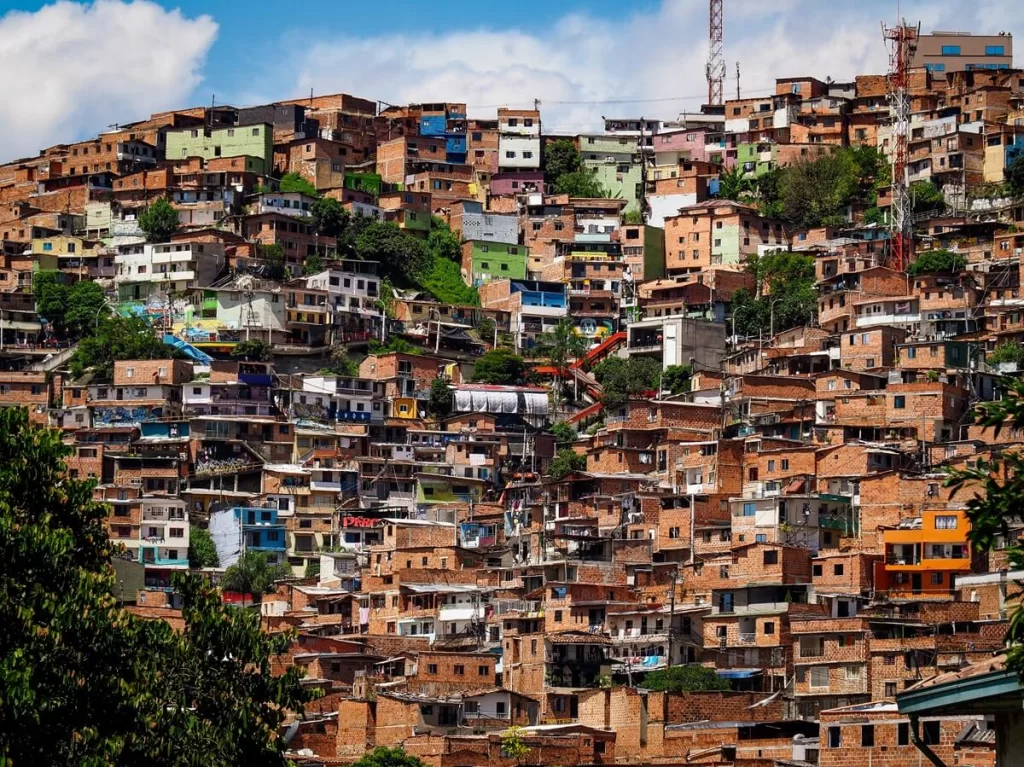
Table of Contents
Brief History of Comuna 13 in Medellin
You may already know that Comuna 13 has a violent history. Once occupied by large farms, the area was turned into illegal settlements in the 60’s and 70’s. As a result of the Colombian conflict, people from the countryside moved here in the hope of finding a better life. However, with no proper urban planning in place, the opportunities to find jobs in the city and commute were very low.
In the 80’s and 90’s Comuna 13 was run by drug trafficking organisations, paramilitaries and guerilla groups. They used this area as their transit hub in and out of Medellin. It wasn’t long before the situation became a national problem, resulting in the comuna becoming one of the most dangerous places in the world.
What is a comuna ? You might be thinking that comuna is just another name for a slum. In fact, Medellin is split into 16 different comunas . For example, the upscale El Poblado district is technically Comuna 14 and the Historic Centre is Comuna 10.
In 2002 the government decided to intervene and implemented multiple military operations. Two of the most important ones were Mariscal and Orión. Although the Orión operation brought about the end of the guerrilla groups, paramilitaries and youth gangs then took control of the comuna. Over the next few years, innocent people continued to be killed or put on trial for supposedly helping the guerrillas.
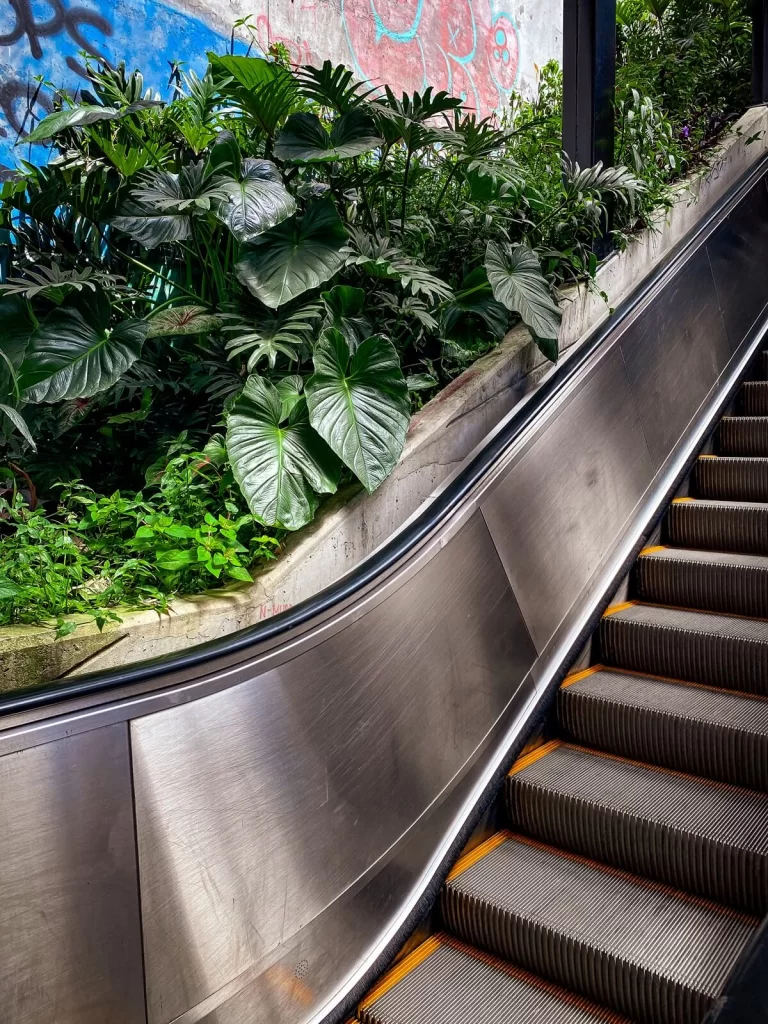
The Transformation of Comuna 13
In 2006, the mayor invested a lot of money towards making positive changes for the people of Comuna 13. One of these investments was the construction of a new cable car line. Later, a series of escalators were built into the side of the hill too. This new infrastructure improved residents’ access to jobs and education.
As part of the transformation, public spaces and recreational facilities were also added to help improve the quality of life. A huge focus was also put on culture and art. You’ll quickly notice that the streets of Comuna 13 are now filled with meaningful murals, street art and performers.
This transformation wasn’t all sunshine and rainbows though. It involved the destruction of homes, businesses and the relocation of some residents. Although the comuna is a much safer and liveable place today, there are still issues to address.
Even with all the current challenges, Comuna 13 is a great example of how urban design can improve accessibility and create a positive change for residents.
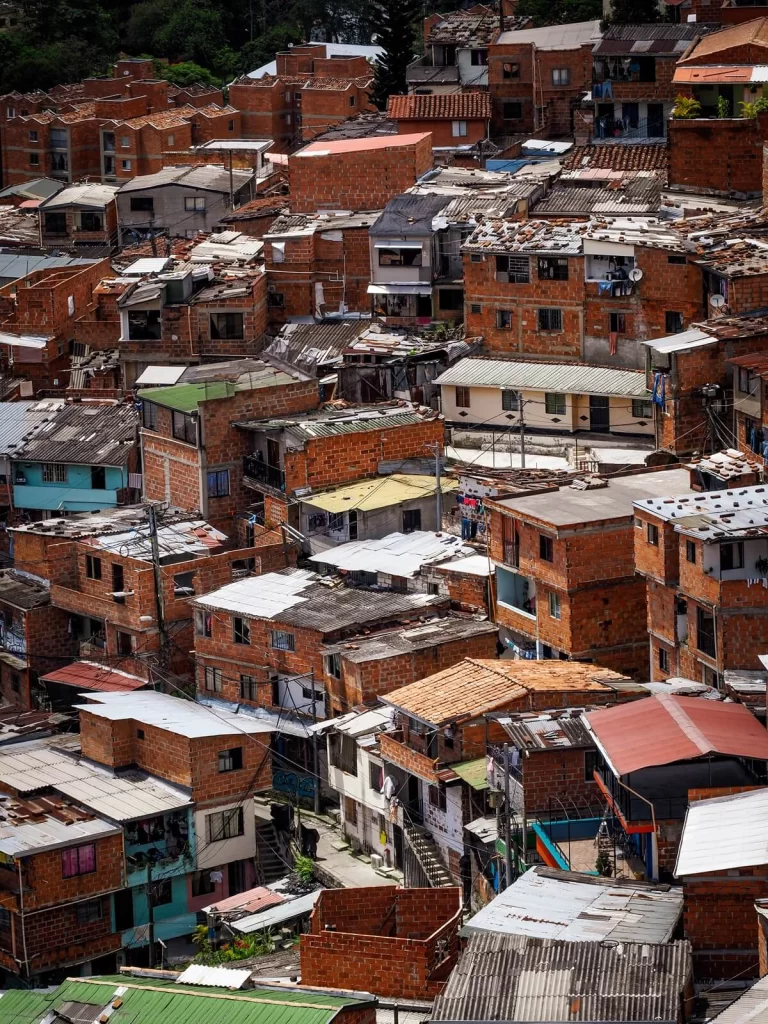
How to Visit Comuna 13 in Medellin
1. ‘free’ walking tour of comuna 13 in medellin.
The best way to visit Comuna 13 is to take a ‘free’ walking tour. We went with Zippy Tours , which is run by local guides who have always lived in Comuna 13. The guides are fantastic at conveying the history of this part of Medellin. They include their own experiences from living there, as well as explaining about the ongoing positive changes being made.
Taking this tour is a great way to understand the troubled past of Comuna 13, whilst also being able to focus on all the positive changes that have been happening in recent years.
You can book your spot through their website. They run the tours 3 times a day at 10AM, 2PM and 4PM between Monday and Saturday. On Sundays you can join a tour at either 10AM or 2PM. Tours are available in both English and Spanish, so make sure to book the language you want to take the tour in. The tours normally last around 2.5-3 hours.
Top Tip. Although this walking tour is ‘free’, it’s suggested to tip $10 USD per person at the end. We recommend leaving a generous tip, especially if you’ve enjoyed the experience, which we’re sure you will. Your contribution is being directly invested back into the community by supporting local artists and children.
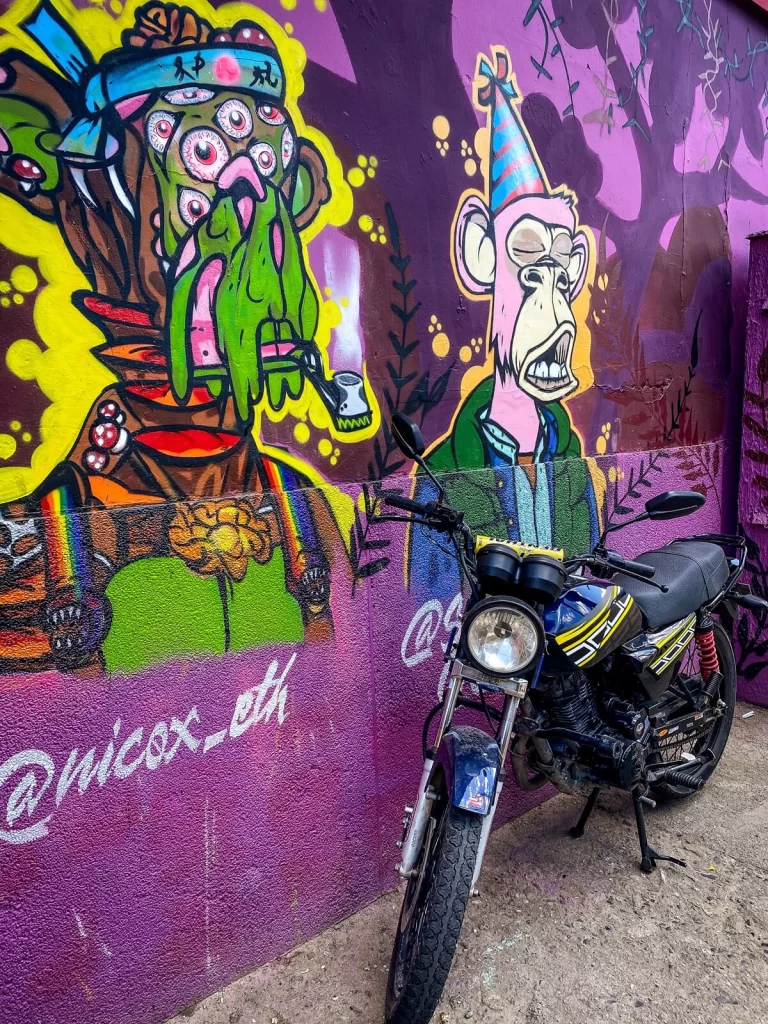
2. Visiting Comuna 13 in Medellin Independently
Thanks to the positive transformation Comuna 13 has undergone over the years, you can now visit this part of Medellin on your own. We’ll discuss how you can get to Comuna 13 using public transportation in the next section. Once you’re there, you’re free to walk around, admire the street art and murals, watch some street performers, chat with some locals and check out some of the art shops, local cafes and restaurants.
However, visiting on your own will never give you that personal knowledge that the local guides can provide you with. Unless you come prepared with some background knowledge, you won’t be able to fully understand the transformation and may not have as meaningful an experience. This is not to say that you can’t have a great time going without a tour. Just bear in mind that the streets can be confusing at times, so be mindful of your surroundings and try not to get lost or accidentally end up in someone’s private property.
Top Tip. If you want to visit Comuna 13 independently, then we highly recommend visiting Museo de la Casa Memoria (Memory House Museum) in Medellin first. It’ll give you a good background knowledge on the history of Medellin and Comuna 13.
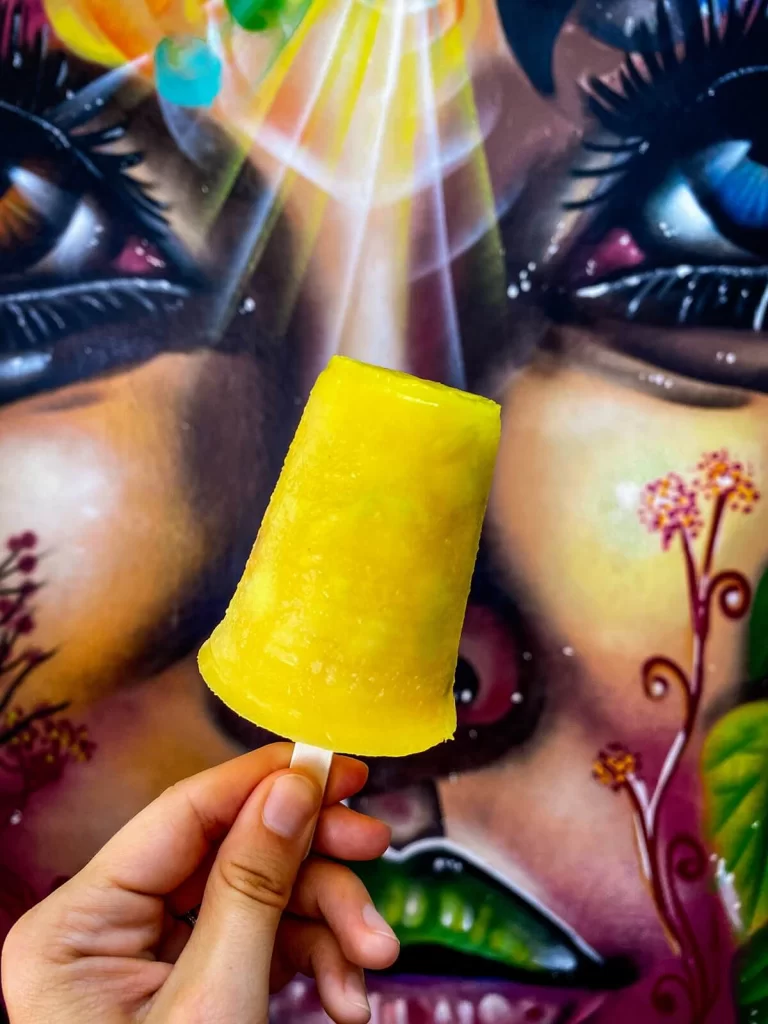
3. Visiting Comuna 13 with an Organised Tour
The increased popularity of Comuna 13 also means there is an increased number of tours available to tourists. You can now join dedicated graffiti tours, street food tours, or even go on a private tour. Below are a few tours you could consider booking:
Comuna 13 History and Graffiti Tour: This 4-hour tour includes the history and transformation of Comuna 13 with street art as the main focus. You’ll get the chance to ride the metro and the metrocable, whilst learning about the transport system and enjoying the views. The tour price also includes some snacks. You can book this tour here.
Comuna 13 Street Art and Food Tour: If you’re a big foodie, then you can join this tour that combines learning about the street art with trying out the local cuisine. You can book this tour here.
Epic Tours Medellin: If you prefer private tours then this company offers one of Comuna 13. It also includes a hotel pick up, so you don’t need to worry about your transportation. This tour starts with a street art tour of El Poblado and a tour of the historic centre of Medellin. You can book this tour here.
Top Tip. We recommend picking a guided tour that uses local guides.
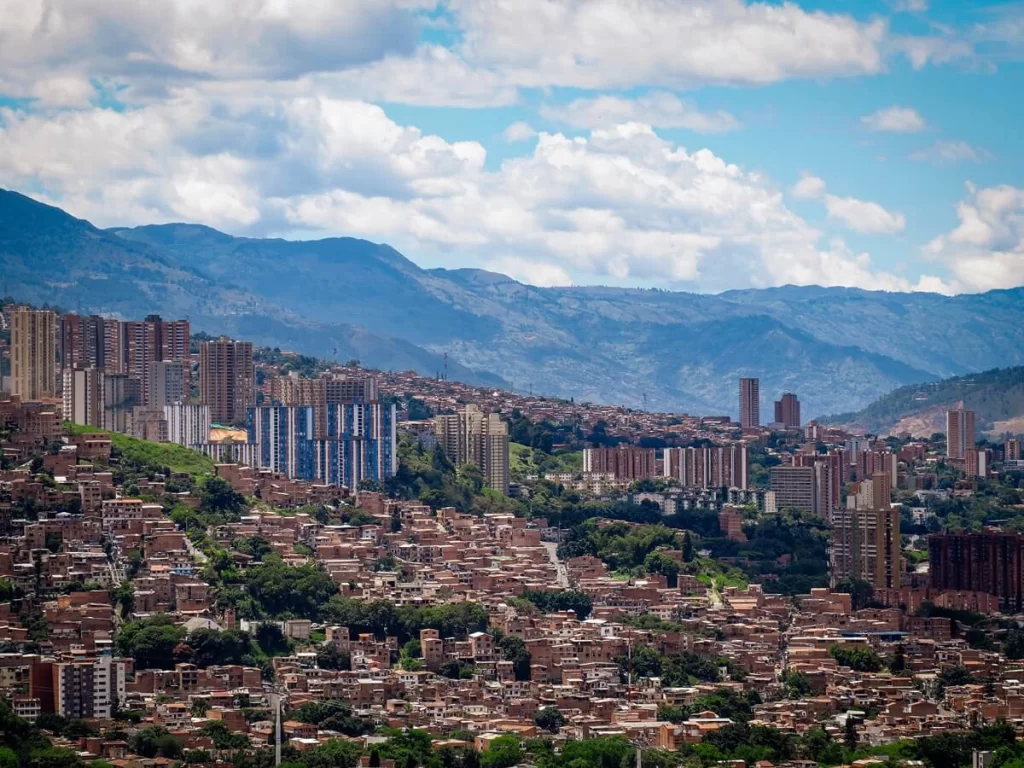
How to Get to Comuna 13 in Medellin
The best way to reach Comuna 13 is to take Metro Line B to San Javier, which is the last stop. You can hop onto Line B at San Antonio station in El Centro / La Candelaria. Alternatively, you can also use Metro Line A first and change at San Antonio station. You can check out Medellin’s Metro Map to see which station is closest to you.
To use the metro you’ll need to purchase a travel card, called Cívica Eventual, which costs 10,000 COP / $2.50 USD. Then you can top that up with however much credit you need for your rides across the city. A one-way journey is normally 3,210 COP ($0.80 USD).
If you’re visiting with a tour, San Javier station is normally the meeting point. From there, you’ll be walking to the main areas of Comuna 13 with your tour group. If you’re not on a tour, then from the station you can either walk to the escalators or take the bus.
The bus stop is just on the other side of the road from the station. Lots of people will be waiting there, so you can’t miss it. Plus, they’ll be a sign saying escalaras electrica. A one way ride costs around 1,500 COP.
- 9 Things to Do in Medellin
- Medellin Travel Tips: A Guide to Visiting Medellin
- Guatape and Piedra del Peñol: A Day Trip from Medellin
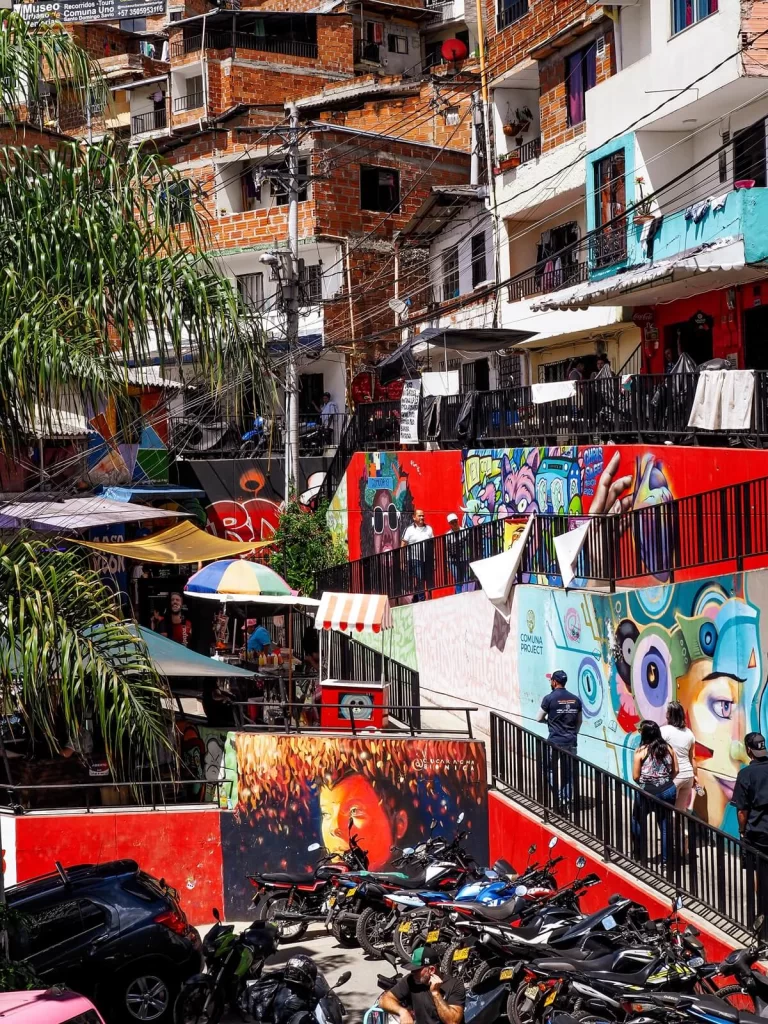
Tips for Visiting Comuna 13 in Medellin
Here are a few of our tips and things you should know before your visit to Comuna 13.
- Safety has improved massively, and we never once felt unsafe walking around Comuna 13. As always, we still recommend staying vigilant. Whilst residents want you to have a safe visit, there’s no guarantee that you won’t get pickpocketed like in any crowded place in the world. Just follow the ‘no dar papaya’ rule, which means don’t make yourself a target for crime.
- Comuna 13 isn’t just one barrio. There are still areas that aren’t safe for tourists. Make sure to stick to the streets where you see the most visitors, such as Las Independencias and the 20 de Julio area.
- It’s going to be touristy. Visiting Comuna 13 is one of the top things to do in Medellin , so don’t expect it to be any less touristy than other popular places in the world.
- Don’t mention Pablo Escobar’s name. Whilst Colombians are open about their past, they also don’t like to be reminded of the person who caused them a lot of pain, so please respect that. Local tour guides will tell you all you need to know about the history that matters, and why the focus should be on the positive transformation currently taking place.
- We were advised not to give money to children. This is because you don’t know what they’re going to spend that money on, and you don’t want to unintentionally support them in buying something that they shouldn’t.
- Be careful of stray dogs. We saw and petted plenty of friendly dogs in South America, but you always have to be mindful because not all of them are nice!
- Wear comfortable shoes. If you’re on a walking tour, you’ll be doing a fair bit of walking. Despite the escalators, Comuna 13 is still pretty hilly, so you want to wear something suitable for your visit.
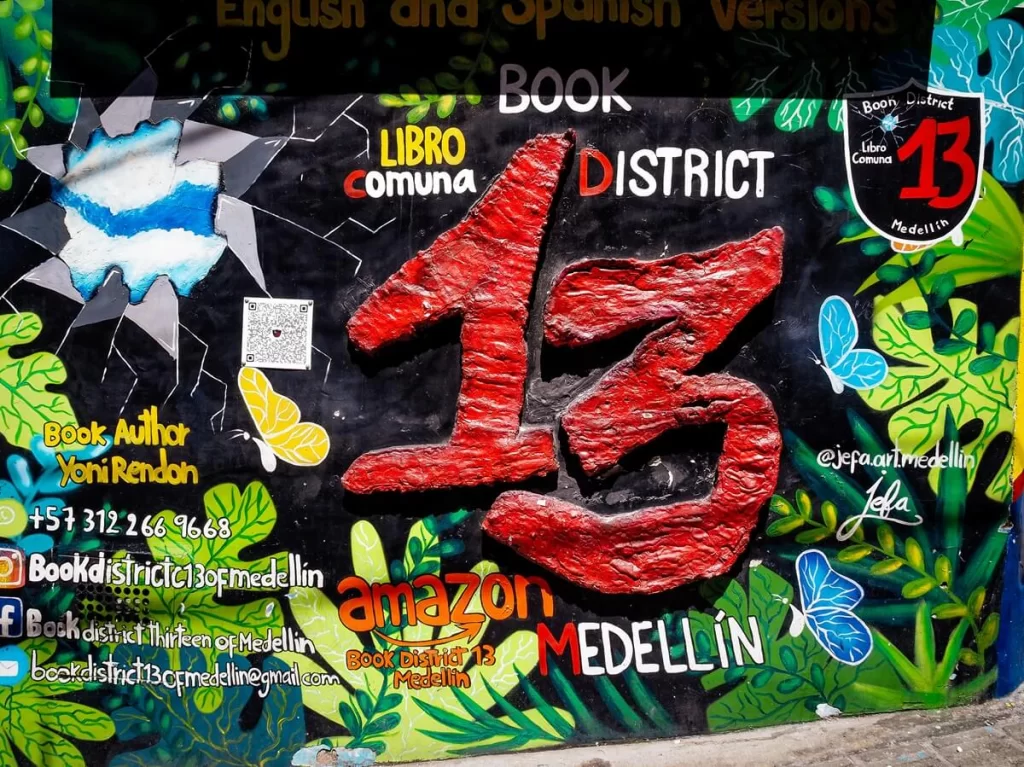
Final Thoughts on How to Visit Comuna 13 in Medellin
We thoroughly enjoyed our visit to Comuna 13. Joining the walking tour organised by locals was definitely the best way to learn about the history and transformation that this part of Medellin has gone through. We gained some valuable insight into what the daily life was like not that long ago and how the people’s resilience and hope has helped turn Comuna 13 into a lively and welcoming district which is focused on moving forward.
Have you ever been to Comuna 13 in Medellin? If so, how did you visit Comuna 13? What was your experience? If not, would you visit Comuna 13 on your own or with a tour? Let us know in the comments below.
Now, let your adventure begin,

Our Top Travel Resources
Accommodation: For hotels we always use Booking.com and Hostelworld for hostels. We also book longer stays on Airbnb or Vrbo.
Flights: To find the best flight prices we always check Skyscanner , Google Flights or WayAway. Then we also check the airlines’ websites too for comparison.
Car Rentals: We use Discover Cars when we want to rent a car as it compares local, national and international companies.
Activities: If we book organised tours we always check either GetYourGuide or Viator.
Foreign Currency: Whenever we can we prefer to pay in local currency and for that we always use our Wise card. We can easily withdraw money from the ATM or pay by card at most shops and restaurants.
Travel Insurance: We never go anywhere without travel insurance. You never know what will happen on your trip, so good travel insurance like SafetyWing can protect you in case of injury, illness, theft and cancellations.
eSIM and VPN: To get data abroad we use Airalo which is an app that allows you to download a prepaid eSIM to your phone in over 190 countries. Make sure to have a VPN to avoid hackers accessing your personal data when using public WIFI. We use Surfshark which is the only VPN that offers one account on unlimited devices.
Remember…It all starts with a Pin…
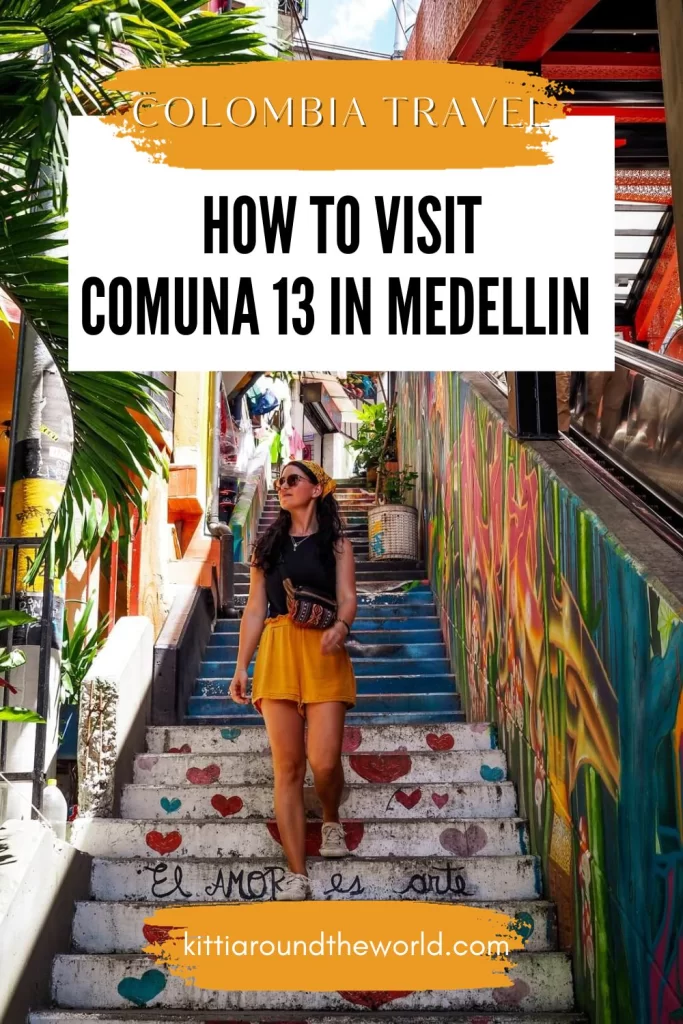
Similar Posts

Things to Do in Cali, The Salsa Capital of Colombia
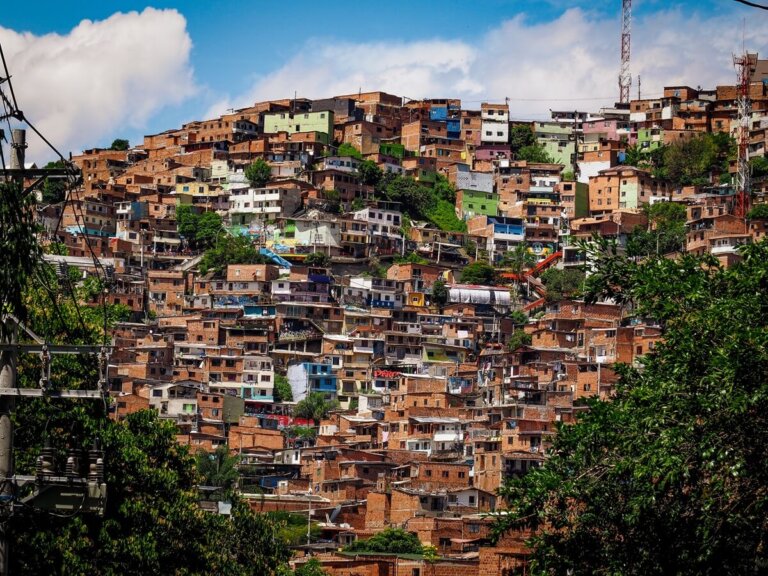
9 Things to Do in Medellin, Colombia
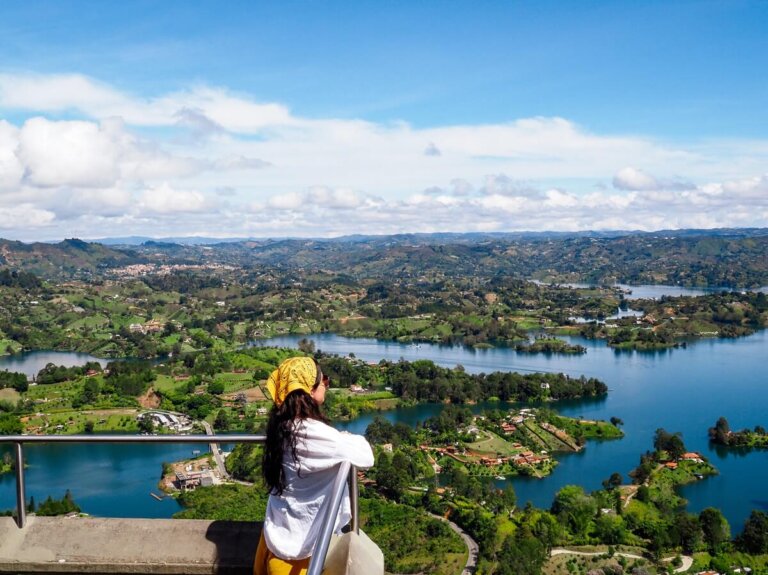
3 Week Colombia Itinerary – How to Plan a Trip to Colombia
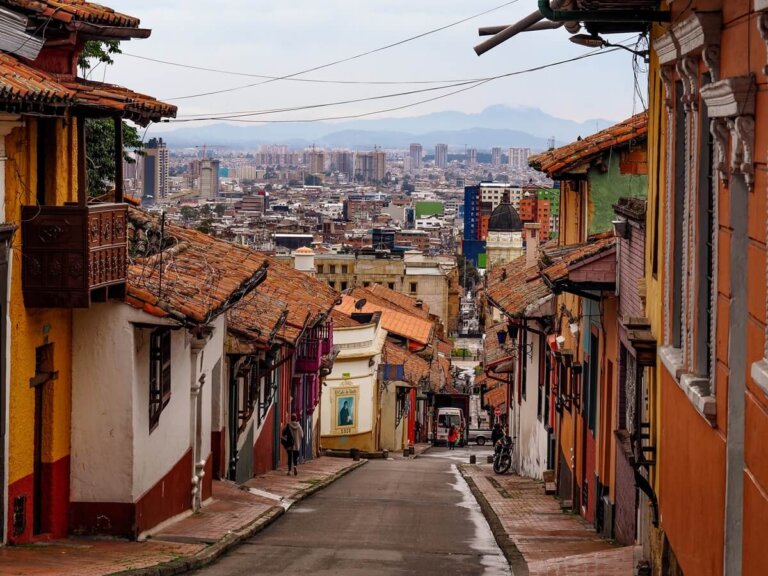
Things to Do in La Candelaria, Bogota Historic Centre
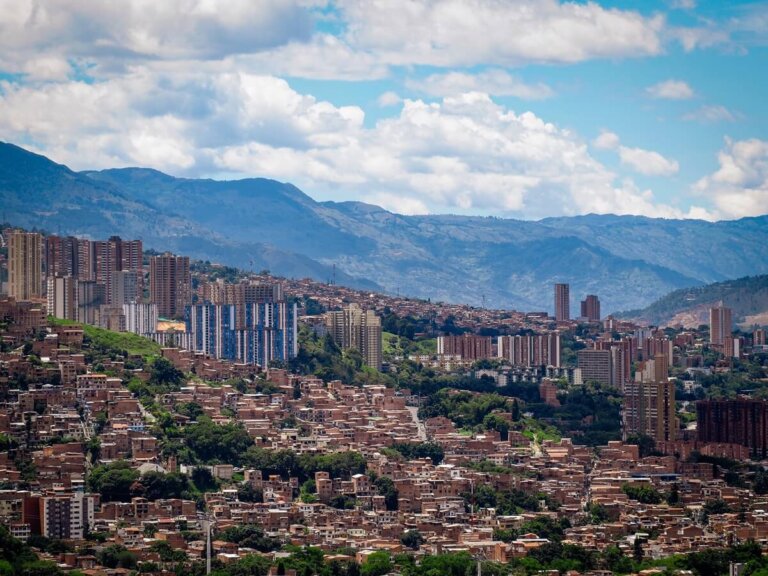
Medellin Travel Tips: A Guide to Visiting Medellin, Colombia
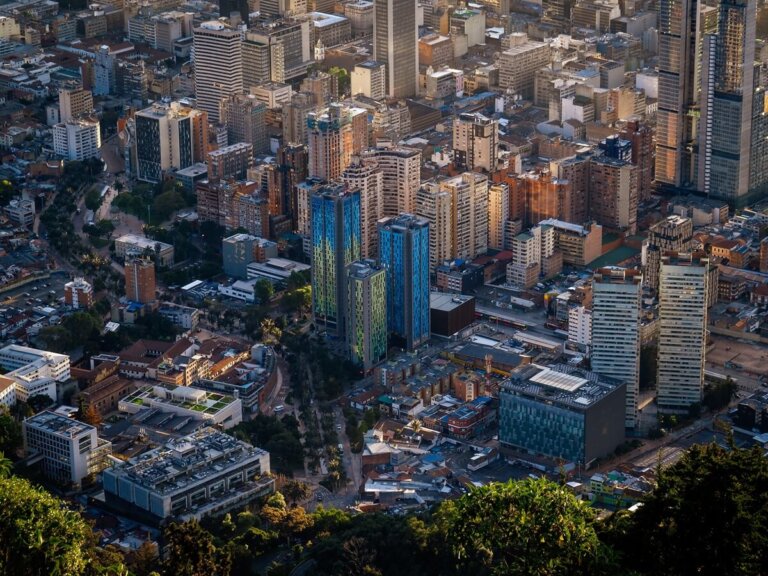
Things to Do in Bogota, Colombia
Your blogs are so informative! Great info and photos!😉
Thank you very much Karan 🙂
The information is very useful,and photos are pretty! thanks for so much details~
Thank you for the positive feedback Alyssa.
Leave a Reply Cancel reply
Your email address will not be published. Required fields are marked *
- Search Search Search …
- Search Search …

How to Visit Comuna 13 – History and Street Art in Medellin
The city of Medellin has 250 neighborhoods, which are all part of the 16 communes of the city. A commune (or comuna in Spanish ) is simply a neighborhood of the city. Different parts of the city of Medellin belong to communes. El Poblado, the primary tourist area of the city, is, for instance, part of Comuna 14, Plaza Botrero, and part of downtown Medellin belongs to Comuna 10. Comuna 13 also known as San Javier was once considered a no-go area. It was labeled the most dangerous community of Medellin due to the very high homicide rates. Comuna 13 today is the living embodiment of how a community has turned itself around. Visiting Comuna 13 from Medellin is a great way to understand what changed here in this community and why.
THIS POST MAY CONTAIN COMPENSATED AND AFFILIATE LINKS MORE INFORMATION IN OUR DISCLAIMER
#1 WAY TO VISIT

Easiest Way to Visit Comuna 13
Travel with a local English-speaking guide and get off the beaten track in Comuna 13. Learn about the history here, the artwork, and what it means to live here.
Why go to Comuna 13
The history of Comuna 13 ties in closely with Colombia’s history. By visiting Comuna 13 you’ll be learning about both some of the darker elements of Colombia’s history, but you’ll also be understanding what it takes to turn things around. In taking a tour of Comuna 13 you’ll be supporting the continuing transformation of the community and neighborhoods of this part of Medellin.
It’s important to learn from the past in order to move forward and you’ll find that in spades in Comuna 13. You’ll get some idea of the scale and scope of the city of Medellin by visiting some of the neighborhoods on the outskirts. While some areas of Comuna 13 are safe for visiting tourists, you should always be aware of your surroundings, and be respectful of the area in which you are visiting and its residents.

Many of the violent events that happened here in Comuna 13 and Medellin are in the recent past. Many families were affected and many still do not know what happened to their loved ones. Be respectful when you visit, these are people’s homes and so long as you take these few things into consideration you’ll have a safe, interesting, and educational visit.
Best Way to Take a Tour of Comuna 13
The best way to take a tour of Comuna 13 is to arrange one with a local. You’ll get inside information and a sense of history that you won’t from just taking one with a general tour agency. Check out these tour options.
- In this four-hour tour of Comuna 13 with a local, you’ll explore the district of Comuna 13, learn the history and see some of the most incredible street art. You’ll meet local artists and residents. You’ll meet at the Poblado metro station and your metro tickets are included in the tour price. Check availability and book this highly rated tour of Comuna 13 now!
- Take a private tour of Comuna 13, and benefit from a pick-up from your hotel or hostel. You’ll get to head off the tourist trail and see the street art of Comuna 13 which has contributed to transforming one of the most violent districts in the world into one of the most innovative. Explore your options for a private tour of Comuna 13 and book now!
What is Comuna 13?
A commune in Medellin is simply one of the cities of Medellin’s collection of neighborhoods. It stretches for 7 square kilometers and incorporates 12 different neighborhoods. Some of the neighborhoods are safe, others aren’t. Most tours and where you should focus your attention are the areas of Las Independencias and the 20 de Julio area.
Comune definitely doesn’t mean slum or dodgy area, it is just a collection of geographically connected neighborhoods. Comuna 13 is infamous for having been labeled the most dangerous part of a city, Medellin, that was already known for its violence and high homicide rates.
The History of Comuna 13 Medellin
Comuna 13 began as a small village called Las Granjas, it was also called, after that, La America. As the city of Medellin grew and encompassed smaller, then outlying villages, las Granjas became a neighborhood of Medellin. Comuna 13 was, however, still primarily an agricultural area where fruit and vegetables were cultivated.
If you want to read more about Comuna 13 history we recommend this book District 13 – available in English and Spanish, it chronicles the stories of pain, violence, and suffering of those living here. It also describes how the district transformed and what happens there today. Buy this history of Comuna 13 on kindle and enhance your Comuna 13 visit now!
If you’re reading this on public WiFi and plan to book a trip, a walking tour, or accommodation, then check out my guide to the best VPNs for Colombia and why (and how you should protect your personal login details).
Comuna 13 in the 1940s
The biggest changes in this area came in 1946 when one of the large farms of the area was transformed into a residential area. Changes came even more quickly in the 1960s and 1970’s when more and more farmland was sold to provide housing for primarily economic migrants to the area.
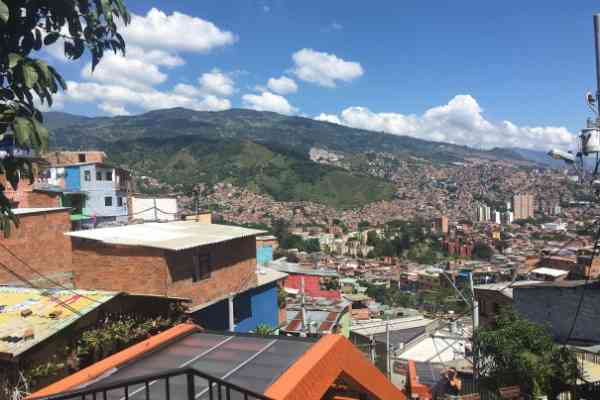
Comuna 13 in the 1970s and 1980s
Yet further migrants came in the late 1970s and the early 1980s – primarily those displaced by drug and gun violence from more rural areas of Antioquia. These immigrants were primarily poor, with few skills other than farming and construction. There was very little integration and much discrimination between the different waves of immigrants to Comuna 13.
Many of those living in Comuna 13 at this time were living in cheap, poorly constructed houses made of wood and salvaged materials. They used water that came from contaminated sources, stole electricity, and had jobs or means of income. It is little wonder that they were targeted by gangs involved in smuggling and drug trafficking.
Comuna 13 is just one day trip to take from Medellin – here are 9 more day trips from Medellin to check out
Comuna 13 in the late 1980s and early 1990s
Control of Comuna 13 during this time was under major dispute amongst Paramilitiaries, FARC and ELN . Each of these illegal groups were keen on controlling Comuna 13 as it was a strategic location for moving both cocaine and weapons. Comuna 13 was controlled by groups loyal to the notorious drug lord, Pablo Escobar. Even after his death, the cartels sought to retain control of this area, which was so important to their distribution.
These armed and violent groups took and retained power primarily based on the illegal drugs trade in Colombia and expanded their operations and became a nationwide problem claiming responsibility for multiple murders every single day.
Comuna 13 in 2003-2004
During this 2 year period, Comuna 13 was under the control of the Paramilitaries, who became judges and jurors for those they identified as helping the guerrillas. Those deemed guilty were usually killed. More than 200 people were “disappeared” and it is alleged, were buried in a rubbish dump called “La Escombrera”. The Paramilitaries were disbanded in 2004 and relative peace descended on Comuna 13. That’s not to say that there was no gang or illegal activity that took place. It did and continues to do so today to a much lesser extent.
Postive change started in Comuna 13 in 2002
The election of Alvaro Uribe in 2002 as Colombian President along with the support of the then Medellin Mayor, Luis Perez led to the beginning of change for Comuna 13. The first changes came with 10 military operations, which were instigated during 2002. The first operation, Mariscal, took place on 21 st May 2002. 9 people were killed, all innocent civilians. It led, primarily to the displacement of many citizens to other areas and neighbourhoods of Medellin. Mariscal came to an end with the waving of a single white bed sheet from one window – a mother desperate to take her sons to hospital. Other neighbours followed suit and the operation ended.
The last military operation of Comuna 13 was also the biggest. In October, the Orion operation lasted for 3 days and employed more than 1500 military, 2 helicopters and a tank. The Colombian army and police are thought to have worked with the paramilitaries to destroy the guerrillas holed up in Comuna 13. Many innocent citizens were again injured and killed. While Operation Orion might have wiped out the guerrillas, it simply handed control of Comuna 13 to the Paramilitaries.
Comuna 13 from 2002 – 2006
Comuna 13 residents started to voice their anger with the violence of the operations of 2002. Community events and pieces of street art depicting the waving of the white sheets raised solidarity and hopes for peace in the area. We’ve also explored Leon in Nicaragua , which expressed its revolutionary fervor through murals and street art too.
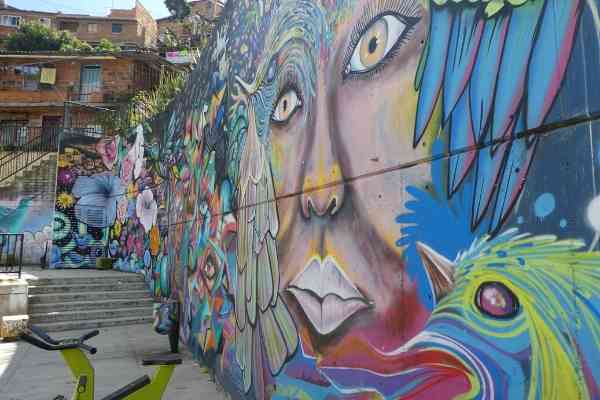
Comuna 13 from 2006 to 2011
Local government investment in Comuna 13 started in 2006 and a new cable car line was opened in 2008. San Javier Station was built and Comuna 13 became much more connected with her surrounding communities.
In December 2011 six electrical escalators were opened in Comuna 13 – providing residents with an alternative to the 384 metres (1260 feet) climb over 350 steep stairs that were their only access previously.

The escalators are free and operate from 0600 until 2200 during the week and from 0800 until 1900 on Sundays.
A wide pathway, the Viaducto Media Ladera connecting different neighbourhoods and providing for outside meeting places and seating areas was also provided.
Comuna 13 today
Comuna 13 is a transformed neighbourhood. International visitors come every day to see this vibrant neighbourhood, where locals give tours and first-hand accounts of the changes. Revenue from tourism brings money directly into the neighbourhood and into the hands of those who live here, not any faceless (to the tourist) organization or gang that controls things.
The very look and feel of the neighbourhood have changed. Street Art adorns many walls. The music reverberates throughout the area. Dance squads entertain tourists. Local vendors sell cane juice and ice creams, restaurants and coffee shops tempt you in for further refreshments.
Above all, life has changed. There are opportunities for gainful, sustainable legal employment. Transport links such as the escalators, the cable cars and the metro station – as well as the easy and cheap pricing of the transport make it possible for anyone from here to travel anywhere on the Medellin metro network for just 2.550 COP.
Now you have the history of Comuna 13, here’s how to visit Comuna 13.
How to take a tour of Comuna 13
You can visit Comuna 13 as part of a guided tour or independently. We know you’re probably concerned that it might not be safe to visit independently, so here’s a little about safety.

Is it safe to go to comuna 13 by yourself? Yes. It’s safe to visit Comuna 13, so long as you follow a few simple rules. And to be honest we apply these rules wherever we visit, in any country.
- Visit during daylight hours.
- Don’t overtly show fancy jewellery or expensive gear
- Always ask before taking a photo of people.
- If you don’t feel safe in a situation back out of it.
- Stick to the main routes and areas.
How to get to Comuna 13 on a guided Tour
Taking a guided tour to Comuna 13 is the easiest way to visit Comuna 13. You’ll either be met in Poblado, Laureles or at the exit of the San Javier Metro station. Our guide to the Medellin metro makes it REALLY easy to navigate Medellin’s fabulous metro system.
Here are our most highly recommended guided tours of Comuna 13.
- In this four hour tour of Comuna 13 with a local, you’ll explore the district of Comuna 13, learn the history and see some of the most incredible street art. You’ll meet local artists and residents. You’ll meet at the Poblado metro station and your metro tickets are included in the tour price. Check availability and book this highly rated tour of Comuna 13 now!
- Take a private tour of Comuna 13, and benefit from a pick up from your hotel or hostel. You’ll get to head off the tourist trail and see the street art of Comuna 13 that has contributed towards transforming one of the most violent districts in the world to one of the most innovative. Explore your options for a private tour of Comuna 13 and book now!
How to get to Comuna 13 without a tour
If you wish to visit Comuna 13 independently, then it is easy to do so. You’ll find Comuna 13 in the west of Medellin, around 6 miles (10 kilometres) from Poblado, but despite the distance its really easy to get there on Medellin’s metro system. The closest Medellin metro station is San Javier. This is the last stop of the B line. So take the metro to San Javier.
When you exit San Javier metro station, the Comuna 13 escalators are a short 1 kilometre (0.6 miles) walk (turn left out of the metro station). The walk to the Comuna 13 escalators from the San Javier metro station takes a slow 20 minutes.
You can also take a taxi (around 5,000 COP) or take the bus number 225i or any bus with “escalares” written on it. The bus from San Javier Metro station to the escalators will cost 1,100 COP per person.

If you are taking a guided Comuna 13 tour, then most tours will either meet outside the San Javier Metro station or will meet you at the Poblado metro station.
What to see when you’re visiting Comuna 13 independently
The first things that you’ll want to do is to take the escalators. So make your way to them, either walk (it is easy, that’s what we did), take a bus, also easy or take a taxi (even easier)
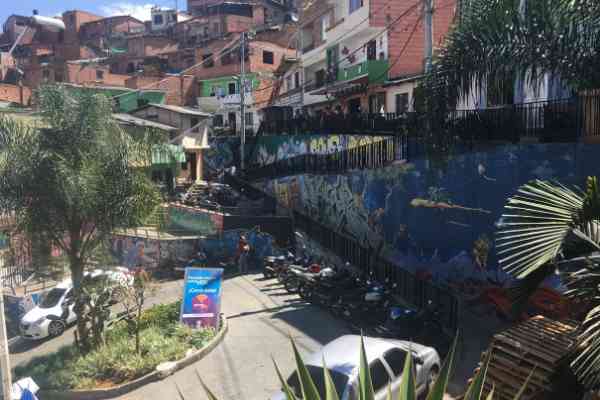
There are 6 escalators. Each escalator takes just a few seconds. There are platforms at the top of each. On some platforms, there are vendors selling drinks and souvenirs. Stop and take a while at each to explore the artwork and the vendors’ offerings.

You’ll find cafes, ice creams, guarapo all offering something for sale. Also on the way up you’ll find some of the street art that COmuna 13 is so famous for.
What to Know About Comuna 13’s Street Art.
You’ll notice several motifs amongst the street art in Comuna 13.
White Cloths: These stand for the time when during the Mariscal military operation white clothes and sheets were used to stop the operation in order that residents could take their injured to hospital.
Red, Yellow & Blue: the colours of the Colombian flag
Birds: symbols for peace.

Things to do in Comuna 13
- Take a tour – take a tour from a local to get more of the inside information about transformation here and also get the local story – try this local guided tour of Comuna 13 here
- Get an ice-cream – there are several vendors selling the most fabulous ice cream. Try green mango, you don’t regret it!
- Get a guarapo – fresh-squeezed cane juice- its really refreshing.
- Get a coffee – you are, after all, in the land of coffee!
- Eat lunch in Comuna 13. You’ll find a few places to eat either at the stops on the escalators or at the bottom of them.
- Photograph the artwork that takes your fancy.
- Watch the black and white break dancing dance group at the top of escalators. Don’t forget to tip.
- Don’t wander off the beaten track. There’s a great balcony walk that you can walk around and get amazing views of the wider city of Medellin.

How long does a trip to Comuna 13 take?
You can take as long as you like. A guided tour of Comuna 13 usually lasts around 3 hours. When we took our independent trip to Comuna 13, from the time we stepped off the San Javier Metro to the time we got back on it, we’d spent around 2 hours here.
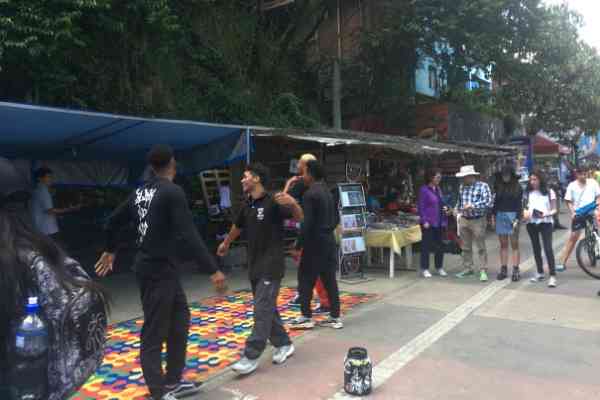
Where to Stay in Medellin, Colombia
The two key areas of the city of Medellin that are best to stay in for first-timers are El Poblado and Laureles. You’ll find a good selection of accommodation in both these areas of Medellin, plus all the infrastructure you’ll need to visit Medellin.
Where to Stay in El Poblado, Medellin
There are a host of places to stay in El Poblado, Medellin – here’s our pick of the luxury places to stay in El Poblado, Medellin, mid-range places to stay in El Poblado, Medellin, and budget accommodation in El Poblado, Medellin.
Hotel York Luxury Suites, Medellin–El Poblado : The Hotel York Luxury Suites in El Poblado units include cable TV, a kitchenette, a private bathroom with a shower, air-conditioning, and a coffee machine. This top hotel in Poblado, Medellin also has an outdoor pool, a bar, a shared lounge, and free WiFi. There’s also a restaurant and a fitness center at this fabulously luxurious hotel in El Poblado, Medellin. Read more reviews and check room rates and availability for the Hotel York in Medellin here.
Lettera Hotel, Medellin–El Poblado : The Lettera Hotel in Poblado provides accommodation with air-conditioning, a flat-screen TV, a private bathroom with a shower and hairdryer, an iron, a safety deposit box, a balcony in some rooms, an iron, a mini-bar, and a desk. This mid-range hotel in El Poblado, Medellin also offers continental breakfast, airport transfers, and free WiFi. There’s also a garden and a terrace here. Check room rates and availability for the Lettera Hotel in Medellin here.
574 Hotel, Medellin–El Poblado : The 547 Hotel is in a great location in El Poblado and this budget Medellin hotel has rooms that are spacious with a wardrobe, a flat-screen TV, a private bathroom, air-conditioning, a mini-bar, bed linen and towels, and balcony in some units. The budget Medellin hotel also offers continental breakfast and there’s free WiFi. This affordable hotel also offers laundry services and this is a great budget hotel option in El Poblado. Read more reviews and check room rates here.
Where to Stay in Laureles
There are a host of places to stay in Laureles – here’s our pick of the luxury places to stay in Laureles, mid-range places to stay in Laureles, and budget accommodation in Laureles.
Inntu Hotel, Laureles, Medellin: The Inntu Hotel is centrally located in the Laureles area of Medellin and rooms here have their own private bathrooms with hairdryer, air-conditioning, sound-proofed rooms, a desk, and a flat-screen TV. This great Laureles hotel also offers laundry, dry-cleaning, and ironing services, and an on-site coffee house and restaurants for dining options. The Inntu Hotel in Laureles, Medellin, has spa facilities offering massages, spa treatments, and other wellness packages. There are great scenic views at this top Medellin hotel from both the sun terrace and garden area. The Inntu Hotel is a great luxury hotel in Laureles. See room rates and availability for the Inntu hotel here.
Hotel Laureles Plaza, Laureles, Medellin: The Hotel Laureles Plaza is in a great location in the Laureles district of Medellin–Laureles. The rooms here at Medellin’s Hotel Laureles Plaza have their own flat-screen TV, private bathroom, air-conditioning, a hot tub in some units, and a wardrobe. This mid-range Medellin hotel also serves continental or a la carte breakfast in the morning, and has an airport transfer service, family rooms, a bar, and free WiFi. The Hotel Laureles Plaza is a great hotel option in Laureles. Check out rates and availability of Hotel Laureles Plaza here.
Hotel Torre Primavera, Laureles, Medellin: The Hotel Torre Primavera is located at Calle 40 in Laureles, Medellin and is a great budget option in Laureles. The units here at the Hotel Torre Primavera include a TV, a private bathroom with hot water, maid service, and free WiFi access. If you are looking for budget-friendly accommodation, Hotel Torre Primavera is a good option when visiting Medellin. Find out more about Medellin’s Hotel Torre Primavera’s room rates and availability here.
Travel Tips for Exploring Colombia
- Read our guide to travel insurance for Colombia
- Considering travel insurance for your trip? World Nomads offers coverage for more than 150 adventure activities as well as emergency medical, lost luggage, trip cancellation, and more.
- Our Colombia Travel check list is here
- Get online immediately in Colombia with an eSIM
- Download and install a VPN BEFORE you travel to Colombia > discount coupon here
- Arriving by air? Book your airport transfer with Welcome Pickups.
- Make sure you have the right travel adapter for Colombia
- Book the best Colombia tours and guides on GetYourGuide and Civitatis
- Read about ATM fees in Colombia
- Save money in Colombia with a Wise debit card
- Book Buses in Colombia with Bookaway
- Book accommodation in Colombia with Booking.com
Final Words about Visiting Comuna 13
We thoroughly enjoyed our trip to Comuna 13. We found the residents and tour guides to be friendly and open. The street vendors were open, helped us with our stumbling Spanish and the guarapo and ice-cream that we bought was thoroughly enjoyable. We felt safe the entire time of our trip to Comuna 13 and had no issues or worries at all. My biggest worry was that my visit was intrusive to the local community, but that didn’t appear to be an issue at all either!
So, please understand a little more about the history and hopes of Comuna 13 and enjoy your visit!
- Why not also take a day trip to Guatape – the most popular day trip from Medellin – read our guide here.
- Looking for other things to do in Medellin? Heres our ultimate guide of things to do in Medellin
We receive a fee when you get a quote from World Nomads using our affiliate links. We do not represent World Nomads. This is not a recommendation to buy travel insurance.
ASocialNomad is a participant in the Amazon Services LLC Associates Program, an affiliate advertising program designed to provide a means for sites to earn advertising fees by advertising and linking to amazon.com, amazon.co.uk, and amazon.ca. Amazon and the Amazon logo are trademarks of Amazon.com, Inc. or its affiliates. As an Amazon Associate, I earn from qualifying purchases .
Sarah Carter
Leave a comment cancel reply.
Your email address will not be published. Required fields are marked *
Save my name, email, and website in this browser for the next time I comment.
Privacy Overview

A Comuna 13 tour in Medellin: What You Need to Know
Medellin, Colombia. The first thing that probably pops into your mind is: ‘Isn’t that the most dangerous city in the world?’ While Medellin was once indeed a place where drug cartels ruled and deadly violence was a part of daily life, in recent years, the city has made a dramatic turnaround and is now emerging as one of the most innovative and community-minded cities in the world. To witness this transformation, there’s no better place to visit in Medellin than Comuna 13!
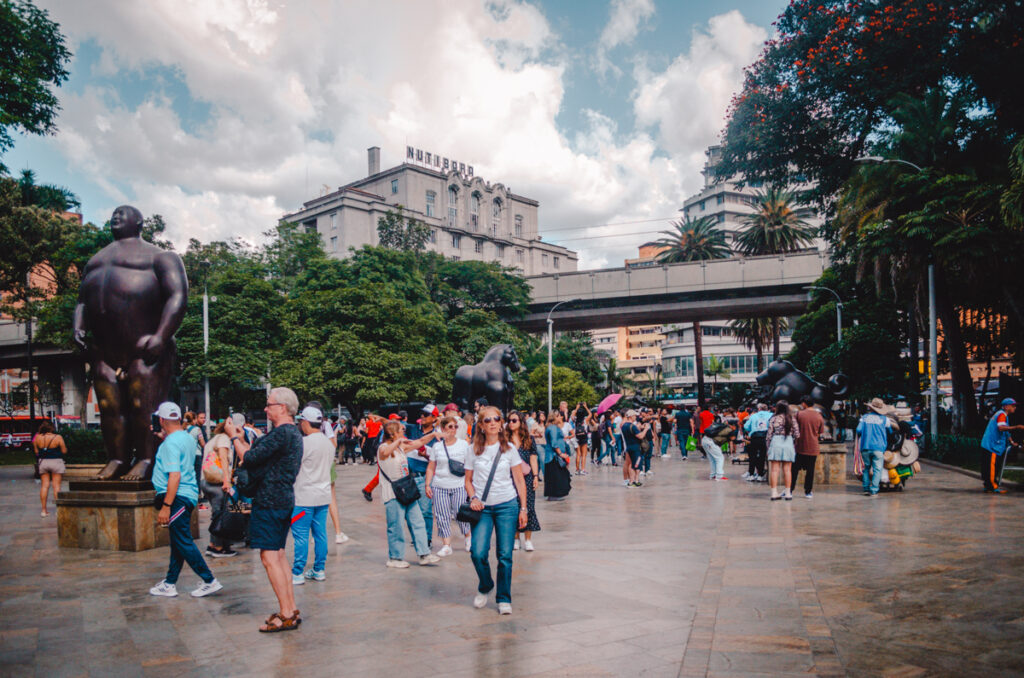
Plaza Botero, La Candelaria, Medellin
Medellin, Colombia ‘s second-largest city is located in the Aburra Valley surrounded by lush green mountains. Once on the daily international news in the 1990s, for the escapades of notorious drug lord Pablo Escobar and his strong grip on society, today Medellin has transformed itself into a hub for innovation, culture, and progressive thinking.
Medellin is often referred to as the “City of Eternal Spring,” and this couldn’t be less true. The city enjoys a temperate climate year-round, making it a perfect destination to visit at any time of the year.
Some of the most important sights in Medellin are the innovative MetroCable which improved city accessibility drastically for locals living on the slopes of the mountains, the dynamic cultural scene that fills the streets with colorful murals, music, and festivals, and the art of world-famous artist Fernando Botero.
You can feel the city’s progressive spirit the most in places like Comuna 13, once a no-go zone, but now a collection of colorful streets that breathes stories of hope and renewal.
→ Also read: The Botanical Garden of Medellin: What You Need to Know
Comuna 13 in Medellin
Comuna 13 outdoor escalators, Medellin
Comuna 13, also known as San Javier, is located in the western part of Medellin. It is situated on the city’s hilly terrain and is characterized by its maze of small streets, most of them inaccessible by car.
Comuna 13 is comprised of many barrios with Plan del Che and Independencias I, II, and III as the main areas of tourism in Comuna 13. Other barrios include Nuevos Conquistadores, Belencito la Colina, Belencito Betania, and many more.
As you step into the colorful streets of Comuna 13, you’re immediately greeted by vivid murals, friendly locals, and hip-hop tunes, a remarkable change from how this part of the city was like, 20 to 30 years ago.
One of the most eye-catching features of Comuna 13 is its outdoor electric escalators. They were installed in 2011 to help the residents navigate the steep hills more easily but grew out to be a symbol of hope and resilience in the community.
To understand why Comuna 13 is such a special place in Medellin and an example for the rest of the world, you need to understand the gruesome history of the history first!
Why is Comuna 13 (in)famous
During the 1980s and 1990s, Comuna 13 was one of the most violent areas in Medellin, caught in the crossfire of drug cartels, guerrilla warfare, and paramilitary groups fighting for control. This period was characterized by widespread violence, including bombings, assassinations, and armed conflicts.
While the drug trade brought wealth to some, it also brought about cycles of poverty and violence that affected marginalized communities, especially those in Comuna 13. The illegal economy and the enticement of quick money led many young people into lives of crime, further destabilizing the community.
However, today, Comuna 13 has turned its notorious past into a fascinating story of change, attracting tourists from around the world. When you visit Comuna 13 now, you can see transformative urban projects, engage with the local culture, and learn about the community’s history through street art and guided tours.
Comuna 13 has become an example of the power of community engagement and activism. While the government also implemented radical changes, especially the Comuna 13 residents have played a crucial role in driving change, advocating for peace, and participating in social and cultural programs aimed at improving their community.
Comuna 13 history explained
To understand the story of Comuna 13 better, we need to dive a bit more into its history first. I’m not going to get too deep into the details here, because that would spoil your tour! Here is a brief overview of what the situation was like in Comuna 13 and Medellin from the 1980s until now.
The 1980s were characterized by the rise of the drug cartels. During that time, Medellin became the epicenter of drug trafficking in Colombia, with Pablo Escobar’s Medellin Cartel dominating the cocaine trade. During these years, the city experienced a significant increase in violence and crime.
Comuna 13, among other neighborhoods, suffers from the consequences of the drug war, including homicides, kidnappings, and extreme violence.
Economic inequality led to the expansion of informal settlements, with Comuna 13 facing severe socio-economic challenges.
During the 1990s, the Medellin Cartel’s influence peaked early in the decade and this led to an all-time high in violence, with bombings, assassinations, and battles with rival cartels and government forces.
Eventually, even though he was protected by some people inside the government, they managed to kill Pablo Escobar in 1993. After that, the Colombian government intensified its efforts to dismantle the drug cartels and restore order, but violence persisted as smaller factions tried to grab control.
Comuna 13 remained caught in the crossfire of ongoing conflicts between drug traffickers, paramilitaries, and leftist guerrillas, which worsened the area’s struggles even further.
Comuna 13, Medellin, Colombia
In 2002, the local government, under the rule of newly elected president Alvaro Uribe, launched Operation Orion, which were military operations in Comuna 13 to eradicate rebel groups, resulting in many civilian casualties.
These operations became some of the most controversial and pivotal events in the recent history of Medellin and symbolized a turning point in the city’s struggle with violence.
Following the government restored state control, efforts began to revitalize Comuna 13, with a focus on improving infrastructure, public services, and social programs.
The introduction of innovative projects like the outdoor escalators in 2011 and a big investment in public spaces sparked a sense of culture and community in Comuna 13. Street art flourished and this turned the neighborhood into a symbol of resilience and transformation.
By the late 2000s and into the 2010s, Comuna 13 became a model for urban regeneration and they attracted global attention and tourism because of its inspiring story.
Can you go to Comuna 13 without a tour?
Yes, you can visit Comuna 13 without joining a tour. Many travelers choose to explore the area independently to experience the vibrant street art, outdoor escalators, and local culture at their own pace. While I don’t go on tours most of the time because I like to explore at my own pace as a slow traveler , visiting Comuna 13 is another story.
Since the history of the Comuna and Medellin in general is so complex, visiting Comuna 13 with a guide can be a very rewarding experience because you can dive really deep into the stories of the neighborhood.
I’m not talking about touristy tours here from big tourist agencies but small local organization that operate out of Comuna 13 itself. They are led and organized by residents of Comuna 13 themselves and participating in these tours can drastically benefit the local community.
In the next section, I’ll highlight three tours that are worth checking out!
Best Comuna 13 tours
The best tours of Comuna 13 are led by Comuna 13 residents, local people who grew up in the neighborhood and know the area inside and out. During their tours, they share personal stories and perspectives that you might not discover through independent exploration, reading or on a commercial touristy tour.
While most touristy tours only cover the main area of Comuna 13 where all the street art and souvenir shops are located, local tour companies also take you to lesser-known areas in the Comuna that are more local and authentic.
Zippy Tour is a local tour agency offering a comprehensive experience in Comuna 13 that focuses on its transformation and cultural dynamic. The tours are available in English and Spanish and last approximately 2.5 to 3 hours.
They include exploration of five neighborhoods in Comuna 13, experiencing artistic expressions like break dance and music, and visiting the outdoor escalators and viewpoints for panoramic views of Medellin.
The Zippy tours really focus on the community’s shift from their troubled past to becoming a thriving artistic and cultural hub. For more detailed information, including how to book a tour, you can visit their website at Zippy Tour Comuna 13 .
Street art and Zippy tour guide Yulieth
Andariegos C13
Explore the vibrant and transformative history of Comuna 13 with AndariegosC13. This intimate tour, perfect for groups of up to 10 people, takes you beyond conventional tourist spots into the heart of the community’s colorful streets and artistic expressions.
From historically significant sites and innovative mobility solutions like electric stairs to local galleries and street performances, this 3-hour journey offers a deep dive into the local culture. The experience is enriched with complimentary water and ends sweetly with homemade ice cream, making for an unforgettable adventure in Comuna 13.
You can book the Andariegos C13 tours here .
If these tours don’t sound appealing to you, there are dozens of Comuna 13 tours to be found on platforms like Viator or GetYourGuide . Do note that most of them won’t be ethical operations.
Casa Kolacho
Choosing a graffiti tour with Casa Kolacho means directly supporting local initiatives that aim to improve the lives of Comuna 13’s residents. The proceeds from these tours are reinvested into the community, funding workshops, cultural events, and social programs.
As a traveler, you can take pride in the fact that your visit will contribute to the ongoing development of the community.
One of the highlights of a Casa Kolacho tour is the exploration of Comuna 13’s world-renowned street art. Through the eyes of Casa Kolacho guides, you can learn about the meanings and inspirations behind the art. Beyond the street art, the tours also offer live hip-hop and breakdance performances.
You can contact Casa Kolacho through their Instagram profile.
THE BEST TRAVEL RESOURCES FOR COLOMBIA SOUTH AMERICA
Here are the websites I use when I travel to Colombia:
ACCOMMODATION
Booking.com : For the best guesthouses, homestays, or small hotels
Hostelworld : To find the best hostels located in the cities
Homestay : For a unique immersive homestay experience in the big cities or the countryside
Busbud and Redbus : The best transport websites for long-distance buses in Colombia. Note that 12Go also works in Colombia but the tickets they will buy for you are open-seat tickets and don’t guarantee a seat on the bus you book online.
Uber : Uber is a convenient and cheap ride-hailing app that can be used in the bigger cities of Colombia. Other apps are Cabify or Didi .
Skyscanner : For affordable flights to Bogota and intercity flights in the country.
Viator and Get Your Guide : book all kinds of activities from the Ciudad Perdida trek to a guided private tour of Comuna 13 in Medellin.
Citizens of many countries, including the United States, Canada, the European Union, Australia, and New Zealand, do not require a visa for short tourist stays (typically up to 90 days). However, this can vary, so it’s always best to check iVisa for the specific requirements for your nationality.
If you’re looking for travel insurance, the one with the best benefits online is undoubtedly Heymondo ! It’s very easy to ask for a quote on the website and, if you book with this link you’ll get 5% off!
Access mobile data immediately when entering the country with a Colombian E-sim or a Latamlink E-sim when traveling through multiple countries. If you are already in Colombia, the best local prepaid sim card is Claro.
Things to know before you go
Yes, the street art is cool and the hip-hop shows contribute to a party atmosphere but don’t forget, when visiting Comuna 13, that these people went through immense struggles in their lives.
Most of them have lost friends and family members during the drug-related violent events in the past so it’s necessary to show respect when you visit the area.
Pablo Escobar
When you go on a tour to Comuna 13 refrain from saying Pablo Escobar’s name out loud, especially in places where locals can hear it.
As said before, these people went through horrifying experiences due to this man and he should not be glorified. The community has worked hard to overcome the negative impacts of those times and prefers to focus on its present and future, emphasizing transformation, resilience, and positive growth.
Criminality today
Even though it’s relatively safe to walk around in Comuna 13 today, there are still corrupt practices in the underworld by criminal groups. To this day, the area of Comuna 13 is still divided by “invisible borders” between three gangs that rule the area.
As a result, in return for safety and protection, all the independent businesses operating in Comuna 13, must pay a weekly or monthly fee to these criminal organizations.
It’s important to take into account before your visit, that this community is fragile. While the inhabitants focus on peace and have a progressive attitude, it’s clear that not much is needed to reverse this process again.
One of these gangs can easily decide that they want to expand their power and gain more territory and go to war with another gang. It’s not all roses and sunshine in Comuna 13.
Prepare yourself well
Before visiting Comuna 13 it’s beneficial to keep a few key points in mind for a safe and educational experience.
Before you embark on a tour, familiarize yourself with Comuna 13’s past to appreciate its transformation and current cultural vibrancy. Engage with locals respectfully and also respect the artwork and the artists.
Even though Comuna 13 is much safer now than it has ever been, stay aware of your surroundings and follow local advice. On a Bogota tour I took before coming to Medellin, they suggested keeping your backpack not on your back but wearing it on your front. That way, you will be less of a target for petty theft.
Lastly, stay hydrated, ask locals for permission before you take a photo, and wear sturdy shoes. Comuna 13 is hilly!
→ Also read: Can You Drink Tap Water in Medellin?
What does a Comuna 13 tour cost
Comuna 13 tours come in all shapes, sizes, and price ranges. It all depends on what you want to get out of a tour, how long you want to explore, and if you opt for a group tour or a private tour.
Below are the two possibilities for the tour organizations I mentioned earlier in the post.
Free comuna 13 tours
Zippy Tour is a free Comuna 13 walking tour, or at least that is what they claim on their sales page. In truth, tours are never free, and also in this case they expect a donation at the end of the tour.
I have to be honest here that are guide, Yulieth, didn’t ask for the donation at the end of the tour but everyone in our group was eager to give it to her because she gave us an amazing tour.
On their website, they also indicate that a fair donation for these tours is around $10 and that is also what most of us contributed to her.
Comuna 13 tours with a fee
The tours of Andariegos C13 are not advertised as free tours but come at a small fee on the website of GetYourGuide . A small part of that will go to GetYourGuide themselves so you can say that, whether you choose to go on the free tours of Zippy Tour or pay € 11 for this tour, prices will be approximately the same.
Note that expensive tours with private transport will probably not benefit the local community, only the pockets of the tour operators.
Colorful houses and street art in Comuna 13.
How long is a comuna 13 tour
How long a Comuna 13 tour lasts is highly dependent on which tour you pick. It’s safe to say that most tours led by locals will take around 2,5 to 3 hours, including an explanation of the history of Comuna 13 and a visit to local shops, street art, and a dance show.
There are tours out there that seem to last a little bit longer, around 4 hours and they often include a ride with a cable car too.
How to get to Comuna 13
To get to Comuna 13 in Medellin, the most common and convenient method is using the city’s Metro system. Wherever you are in the city, take a metro to the San Javier station , which is on Line B of the Medellin Metro system. This is the closest metro station to Comuna 13.
Once you arrive at San Javier station, you have a couple of options to reach Comuna 13. It’s possible to walk from the San Javier station to the base of Comuna 13, where the outdoor escalators begin. This walk takes about 15 to 20 minutes, but it’s uphill, so be prepared for a bit of a workout.
If your health doesn’t allow it, there are also buses and taxis at San Javier Metro Station that can take you to Comuna 13. However, what a lot of people don’t know is that Comuna 13 already starts at San Javier Metro Station. While it’s a pretty local neighborhood far away from the escalators and fancy graffiti, your trip into Comuna 13 actually already starts here!
San Javier Metro Station
If you are taking a guided tour of Comuna 13, you will be asked to come to a meeting point where your tour starts.
Big commercial tour operators will have meeting points in El Poblado or offer a hotel pick-up. Smaller tour operators will either have a meeting point close to the escalators in Comuna 13 or pick you up at the San Javier Metro Station.
Is Comuna 13 safe
Yes, Comuna 13 is safe to visit. Comuna 13 has undergone a significant transformation over the past two decades, evolving from a troubled area in the city into a vibrant community known for its street art, cultural projects, and community initiatives.
Safety improvements and community policing make the area more accessible to visitors and tourists who want to learn more about this remarkable transformation.
However, as a traveler, you need to stay aware of your surroundings, especially in areas with a complex history like Comuna 13.
One of the best ways to visit Comuna 13 is with a guided tour, which not only provides an understanding of the area’s history and art but also ensures that you stick to the paths well-trodden by tourists.
Note that there are also many places to have beers and the area smells like marihuana. It’s needless to say that this is not a good place to get wasted!
→ Also read: Is Medellin Safe to Visit? What You Need to Know!
My experience visiting Comuna 13 in Medellin
As a traveler deeply drawn to the history of places, community life, and culture and art, I found my visit to Comuna 13 in Medellin to be profoundly moving.
This neighborhood which was once synonymous with the turmoil of Medellin’s darkest days, now is a wonderful place of transformation and hope, offering lessons in resilience that resonate deeply with conscious travelers like myself.
Medellin day trips: Comuna 13
Our journey began with a metro ride to San Javier station, the gateway to Comuna 13. Opting for a guided tour with Zippy, I wanted to ensure that my visit not only allowed me to witness the community’s vibrant art but also to understand the historical and social context behind its transformation.
Our guide, Yulieth, a local woman who grew up in the neighborhood, became the voice of Comuna 13 for the day. She shared personal anecdotes and insights that you simply can’t find in textbooks. It was also lovely to see her greet many people on the street (and even dogs!) which made it clear to everyone in the group what a tight community Comuna 13 is.
We also stopped at a local restaurant at the end that she really liked and a few coffee shops and panaderias on the way for Colombian coffee (tinto!) and ice cream.
→ Also read: Vegan Restaurants Medellin: Your Guide to The Best Hotspots!
The social aspects of Comuna 13’s transformation were particularly striking for me. Community-led initiatives, from educational programs to dance shows, highlight the power of collective action in driving positive change.
It was clear that, while the government and NGOs played significant roles in the neighborhood’s rehabilitation, the true architects of Comuna 13’s revolution were the residents, whose resilience and creativity have woven a new social fabric.
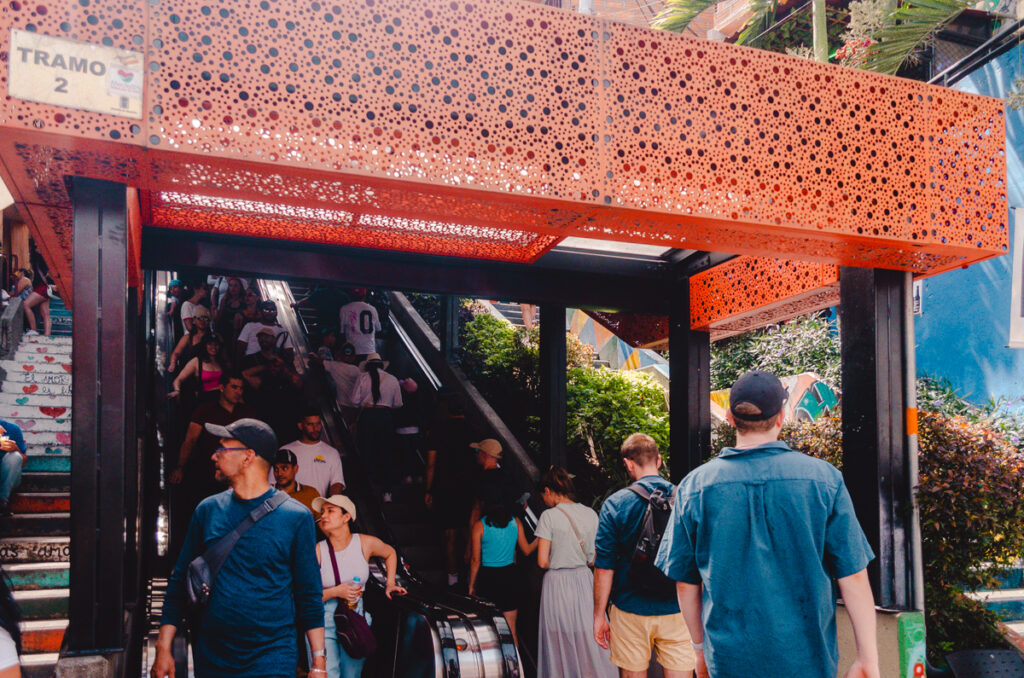
As the tour concluded, I was left with a profound sense of admiration for Comuna 13’s journey from a no-go zone to a must-visit destination for those seeking to understand the complexities of urban transformation.
This tour has been more than just a walk through a neighborhood. It’s been a profound journey of understanding and connection. The spirit of Comuna 13 is a great reminder for us all that the most beautiful stories of hope and renewal can emerge from the deepest challenges!
The best time to visit Comuna 13
The best time to visit Comuna 13 highly depends on what you are looking for in a visit. As Medellin is called “the city of eternal spring” the temperature is nice year-round and weather-wise any time of the year is suitable for a visit.
Regarding tourist crowds, I can highly recommend visiting outside of peak season, which is from December to February. Not only is this the time that many foreign tourists visit Colombia, but it’s also holiday season in Colombia and it was a bit insane how many Colombian tourists were on the road.
As a result, Comuna 13 was packed to the brim with domestic travelers when we visited. I believe it’s better to visit in March when the Colombian holiday season is over, and before the Eastern holidays start.
Final thoughts
There you go! I hope this post inspired you to visit to Comuna 13 in Medellin and to not only see the street art but also learn about its history and social transformation.
Let me know in the comments below if you have any questions or drop me a message through my contact page .
Also, don’t forget to check out my resources page with my favorite booking platforms and tips to start planning your trip. Additionally, have a look at my favorite travel gear if you want to pack more consciously!
Disclaimer: This post may include affiliate links. If you click on them, I may receive a commission at no extra cost to you.
Fancy more Colombia travel advice?
- San Agustin, Colombia: An Easy Travel Guide
- Tatacoa Desert: A Remarkable Hidden Gem in Colombia
- Silvia, Colombia: The Guambiano Market & More Travel Tips
- Villavieja, Colombia: A Complete Travel Guide
- Cocora Valley, Colombia: All You Need to Know
- Can You Drink Tap Water in Bogota? What You Need to Know!
- Buga, Colombia: A Complete Travel Guide to a Hidden Gem
- Dibulla, Colombia: A Hidden Gem on The Caribbean Coast
- March 1, 2024
post a comment cancel reply
Save my name, email, and website in this browser for the next time I comment.
Hi! I am Annelies and this is Travelers & Dreamers, a blog about conscious travel which means traveling in a more mindful way, with a positive impact on the world and yourself!
On this website, I cover different topics like slow travel, plant-based food guides, responsible travel, sustainable packing, eco-travel, and more !
Latest Posts
13 Best Vegan Bakeries in Barcelona For Dessert & Breakfast
How to Get From Prague to Karlovy Vary: An Easy Guide
Loket, Czech Republic: Guide to A Picturesque Castle Town!
Can You Drink Tap Water in Barcelona? A Complete Guide!
How To Get From Hanoi to Halong Bay: Ultimate Guide
Do you want to receive my latest finds on conscious and sustainable travel directly to your inbox? Subscribe here!
Add Your Heading Text Here
© COPYRIGHT TRAVELERS&DREAMERS, 2024.

Comuna 13, Medellín – From notorious murder capital to tourist attraction
By: Author Catrina McGrail
Posted on Last updated: January 25, 2023
Categories COLOMBIA , LATIN AMERICA
Comuna 13: a Colombian neighbourhood that was once considered the most dangerous place in the world’s most dangerous city, has transformed itself and is rapidly becoming a very popular tourist destination.
Not too long ago, the city of Medellin suffered from terrible violence, but nowhere was it more prevalent than in Comuna 13.
Learn how this commune has reinvented itself and why it is quickly becoming the number 1 attraction in Medellin.

Where is Comuna 13?
Comuna 13, also known as San Javier, is a district in Medellín, Colombia’s second city. It is one of 16 neighbourhoods (“ comunas “) of Medellín, located in the region of Antioquia.
Why is Comuna 13 famous?
In the 1980’s-1990’s Comuna 13 had such high murder rates it was considered the most dangerous place in the world.
Now it has become a vibrant place where young people can be creative and express themselves through street art, and the locals are optimistic they can live in peace again.
If you are heading to Medellín, a visit to Comuna 13 is a must. It is not only one of the best things to do in Medellin as it is a really informative and humbling place to visit but it is also one of the best places to visit in South America .
If you are visiting Colombia with kids , it’s also definitely worth bringing them here to Comuna 13.

Why does Comuna 13 have such a turbulent past?
The notorious drug lord Pablo Escobar lived in Medellin, hence drug cartels in the region were loyal to him. The Medellín Cartel took over Comuna 13 and ruled it during the 1980’s-1990’s.
This was due to the location of Comuna 13: it was seen as a favourable position for the cartel as it is located just off the San Juan Highway, on a steep hill just west side of the city.
Therefore it was the ideal route for the cartel to transport guns, drugs and money from the rural parts of the Antioquia region to it’s main city: Medellín.
Even after Escobar died in 1993, activity was rife here as rival rebel groups sought to take control over the area and guerrilla and paramilitary activities would constantly take place here.
Comuna 13 was, and still is, a very densely populated lower class area – there are around 100,000 inhabitants here, living in small houses clinging to the side of the mountain.
During this time, everyday life was filled with fear and chaos for the residents innocently caught up in the mess of gang violence and illegal trafficking. Thousands of residents even became displaced due to the violence.
During the reign of the drug cartel huge social class differences were created and social tensions with the Government mounted.
So in 2002 the military attempted a controversial attempt to overthrow the cartel in Operation Orion .
Helicopters, soldiers and policemen attacked the area (over a thousand of them altogether).
There were many raids and unfortunately this meant many innocent residents died or got seriously injured as a result of the crossfire and couldn’t access medical attention.
The residents united together and took to the streets, raising white rags in a plea to end the violence. And with that, the violence stopped.
The sense of community, solidarity and bravery shown by the residents in a bid to finally get peace is incredibly moving.
Whilst this operation significantly lowered the murder rate by about 400% and is considered by the Government to be very successful, the people of Comuna 13 believe murder rates dropped simply because people started ‘disappearing’ instead.
However, the neighbourhood is in a much better place now than it was and people are channelling their discontentment and energy about Operation Orion into art, music and dance and expressing themselves in this positive way.
As a result, you will see a lot of symbolic art work on the streets in Comuna 13.

What is Comuna 13 like these days?
Thankfully these days, things are much brighter for Comuna 13. During the last 10 years or so, the neighbourhood has been completely transformed.
The once dangerously violent streets are now covered in beautiful wall murals and street art, which the locals use as a way to express themselves. Whilst it is still a very poor area, art and tourism in particular have given this community hope.
Tourism has increased dramatically here in the last 2 or 3 years alone as word of mouth has spread about this neighbourhood that has transformed itself.
I first visited in 2017 and the streets were fairly quiet with the odd few tourists walking around.
Nowadays however, you’ll see hoards of tourists here, (25,000 a week!!!) which can kind of take away from the experience here.
I guess that’s what happens when you find a good thing – it never stays secret for long!
And I am happy the locals are benefitting from the tourism and tourists are learning about the history here and spreading the positive word.

Should you visit Comuna 13?
Comuna 13 is such a vibrant and optimistic places filled me full of happiness, but more importantly, full of hope. It is a great example of urban transformation in a city that was desperate to change it’s reputation.
I found it very educational and moving visiting this neighbourhood, and it was definitely one of my highlights in my Colombia trip.
The walls of this neighbourhood tell a thousand stories and it was so incredible to walk around and witness all the impressive art work.
The locals want you to visit Comuna 13 so you can see hope and transformation. Not so you can nose into their troublesome past.
You might find it surprising, but many locals are actually very offended all the ‘narco tourism’ that has become very popular in Medellin.
People in this city want to look forwards, and not be constantly reminded of their past. Remember feelings and memories are still very raw for those living here.
Many people died and thousands are still unaccounted for. Please be respectful towards the residents here.

What is there to see in Comuna 13?
Escaleras eléctricas.
As soon as you get to Comuna 13 you’ll see the ‘escaleras eléctricas’ (electric escalators).
There are 6 outdoor linking escalators in total, and they were built as a means to help the residents easily get up and down the steep hill that the neighbourhood is located on.
They have replaced 350 of the steepest steps and have really helped to make life a lot easier for the locals (the strenuous 35 minute uphill walk now takes just over 5 minutes!).
They have also meant the locals feel more connected to the city of Medellin and the area is more accessible, which in turn, helped tourism flourish here.
Make sure you take the final escalator to the top, where you’ll be awarded with sweeping panoramic views – some of the best in Medellin!
Medellín is located in a valley and Comuna 13 looks down into the city. It’s only from here that you’ll realise the grand scale of Medellin and Comuna 13.
The escalators operate from 06:00-22:00 (08:00-19:00 on Sundays) and are free to use.

The area is nowadays most famous for it’s large wall murals and street art. Every piece of street art here is symbolic and tells a story about the area’s past, and it’s hopes for the future.
You’ll see some elephant motifs: a sign that Comuna 13 will never forget it’s past, and motifs of birds which symbolise peace.
White sheet motifs symbolise the time when the locals of Comuna 13 raised white flags above their houses during the attacks to plead for the violence to end. A lot of the street art is very colourful which makes the place really uplifting.
As you go higher up the hill there are lots of pedestrianised areas where you can stroll round, sit and admire the art and take pictures.
You may even see some youths performing street dance or hip hop – a way that young people are able to focus their energy and have a creative outlet instead of getting caught up in violence.

Also make sure to ride the cable car when you are in the area. Similar to the escalators, the cable car has helped transform the lives of the locals by providing easy accessibility to the metro.
Therefore they can easily get into Medellin now have more opportunities for jobs. Visit the cable car after you have finished visiting Comuna 13 as it is next to the San Javier metro stop.
Get on the cable car (line J) and it will go up and down the mountain, over Comuna 13 to La Aurora, providing incredible views. It is one of four cable car lines in Medellin.

View of Comuna 13 from the cable car
How to get to Comuna 13
If coming from the metro in Medellín, get off at San Javier stop. This is the final stop on the B Line. A 20 minute uphill walk from the metro will take you to the escalators and Main Street art area.
Alternatively you can wait for the bus 225i, which stops right outside the metro station. Tell the bus driver you want to get off at ‘ escaleras electricas ‘.
To be honest, I advise to take the bus from the metro as opposed to walking.
This is not for safety reasons as I felt perfectly safe, but because it’s a lot of walking (uphill too!) and it can be easy to get disorientated amongst all the streets.
Comuna 13 is not just one barrio, but a mixture of several – a commune, as it’s name suggests. It is pretty big: the whole area of Comuna 13 is actually more than seven square kilometres, made up of several neighbourhoods.
So if you do plan to walk, make sure you have offline maps such as maps.me or Google Maps on your phone as it’s not one simple road to get there. Here is the route to walk .
Therefore it is definitely easier to take the bus as you’ll end up near the escaleras electricas, which is the main part that tourists visit, and where you can see all the street art.
Plus the bus is very cheap and you’ll be with many locals on the bus which will be a cool experience.
If you wish to take a taxi to escaleras electricas, it will cost around 4,000 Colombian pesos (£1).

Is it safe to visit Comuna 13 alone?
In my opinion as a female solo traveller, yes it is. Just exercise caution and be vigilant like you would be anywhere in the world. Many people actually explore it without a tour and you’ll see plenty other tourists walking round.
It is still a poor area though and crime does sometimes exist, so just keep your wits about you like you would anywhere when you travel alone.
I felt very safe here and was so glad I decided to visit.
If you want to visit, don’t let other people’s comments put you off. People are really friendly and really kind here here and want to change your perception about what their area is like.
Some of them will want to chat to you and share their culture with you. Make time to interact with them – you are in their area after all and it is still quite a new thing for the locals to see tourists!
People here are going back to living their normal lives without feeling scared. You’ll see street vendors, children playing in the streets, women carrying their groceries home. I did not feel threatened at all when I was here.
Be mindful when taking photographs – if you want one of a local, ask for their permission first and be respectful of people’s private property.
The area is very over-populated and many of the houses here are built almost ontop of each other, so be careful you aren’t going onto someone’s property by accident.
Whilst it is great to visit Comuna 13 alone, if you are on a tour you will get to hear the stories behind the area, the art work and transformation, which is just as inspiring as seeing the art work.
Therefore you may have a more meaningful and insightful experience if you visit with a tour. Read below about which two local tours I recommend.

How can you help the residents?
If you visit Comuna 13, please don’t be one of those cheap tourists who just walks around, takes pictures and leaves. Try and support the community – everyone here has been negatively affected by the violence that happened here.
Whether that is by buying a postcard or a print in one of the little market stalls, or buying some street food or a juice from somewhere (there are lots of restaurants and cafes, especially near the metro station!).
Your contributions will really help these residents.
You can also help the residents by going on a tour that is organised by the locals, see below for details.

Tour of Comuna 13
If you don’t fancy exploring the area alone, you can go with a tour.
There are several companies that offer tours, however it is best to go with a local company, to directly help support the local community and to be more ethical. Two local companies that I recommend are:
Graffiti Tour
The Medellin graffiti tour is a highly recommended tour to take. Not only are the tours highly educational, but part of the proceeds of their tours are used to fund education programs for local children here in Comuna 13.
Local street artists lead the tour and will tell you about the transformation of the area. They will also explain the stories behind the street art: all which promote peace and hope.
The tours depart daily from Medellin, cost 80,000 Colombian pesos and last about 4 hours as they depart from Medellin (metro and bus tickets included in the price).
Free Comuna 13 Tour
Zippy Tours are also a good company that offer free tours (although a tip afterwards would be very much appreciated).
They are led by local guides who grew up in the area, so know the streets and stories very well and are able to give a personal and reliable account of what happened back in the day.
Tours depart from San Javier metro station and you walk to Comuna 13 from here (you don’t take the bus like in Medellin Graffiti Tour). Tours also depart daily, leaving at 10am and 2pm.

What should I wear?
As Comuna 13 is set on a steep hillside, there is a fair bit of uphill walking when you get here, so wear suitable shoes. Also be respectful – this is a low socio-economic area so don’t parade around sporting your most fancy and designer gear.
When I visit places like this, I don’t want local people to think I am gawping into their life or feeling sorry for them “seeing how the other half live” (yuk I hate that expression).
I just want to show that I am a normal person inquisitive about learning about other cultures.
Visiting Medellin
Medellin was probably my favourite city in Colombia. You could feel the optimism in the air, the thirst for change and people looking eagerly towards the future.
The Government and the people of Medellin are passionate for the city to lose it’s long-standing reputation as a centre for drug trafficking and it is rapidly becoming a much safer, and more modern place.
Looking for other ways to help Colombian families who come from a low socio-economic background? Read my post on volunteering in Bogota .
Alternatively, if you’re interested to find out more about Colombia culture, check out:
Dating A Colombian
Colombian Wedding Traditions
Like this post on Comuna 13? Pin it!

Catrina McGrail is a Travel Writer and ex-Flight Attendant based in Sydney, Australia. She has visited 85 countries and lived in several – including Italy, Australia, United Arab Emirates and England. Her work has been featured in a variety of popular travel publications including Fodors, Escape, Australian Traveller and Bear Grylls, as well as several international aviation and travel companies. She only writes about places she has personally visited, and aims to give real, honest advice to help her readers.

- Hawaii Islands
- Philippines
Comuna 13 Medellin | All You Need To Know
Comuna 13 was the most dangerous place in Medellin, if not in all of Colombia , 20 years ago (see the history section below ). There were daily murders and the inhabitants could not be sure of their lives. Strolling through this neighborhood as a tourist (and even on your own without a tour guide) was not possible at all. And today? Masses of tourists in flip-flops and sunglasses roam Comuna 13 Medellin, snapping photos of the numerous graffiti scattered throughout the neighborhood. What a change of times.

For us, Comuna 13 (pronounced trece ) was one of Medellin’s highlights. The colorful houses, the corrugated iron roofs, the narrow streets. And the confidence in the faces of the people that, despite the bad past, a better future lies ahead of them. Comuna 13 is built on a steep hill and to get from the lower end to the upper one, one has to climb many stairs otherwise. With the newly built escalator, the residents were much more agile and could also get to the city center much easier. Also, the economy and coexistence in Comuna 13 were improved tremendously.
What to do in Comuna 13 Medellin?
The Comuna 13 really impressed us and is a must-do on your Medellin trip. But what is so special about this once most dangerous neighborhood of Medellin?
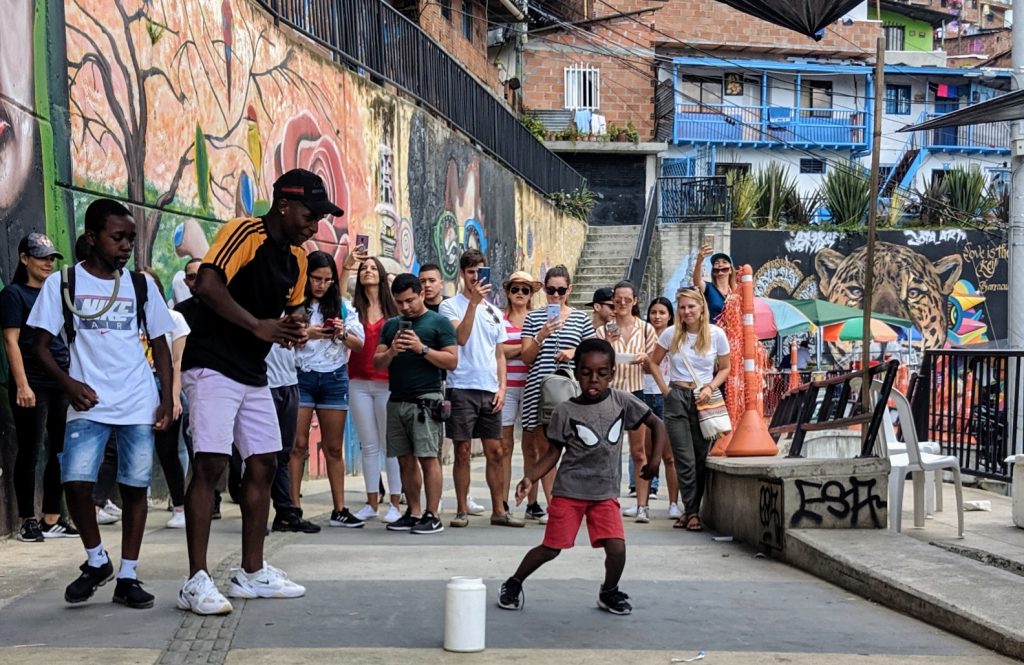
It is, of course, the transformation that this district has undergone. With this history in mind, it is impossible to walk unimpressed through the streets of this neighborhood. Secondly, it is the many artistic graffiti that can be seen everywhere and in front of which the many tourists are only too happy to be photographed.

Third, it’s the escalator built in 2011, which, if you add up all the sections, is said to be the longest escalator in the world. It’s not quite as impressive, of course, since the nearly 160 meters just aren’t reached in one piece. Nevertheless, a special highlight in this quarter. But the escalator was not built for Instagram-crazy tourists, of course, but for the residents.
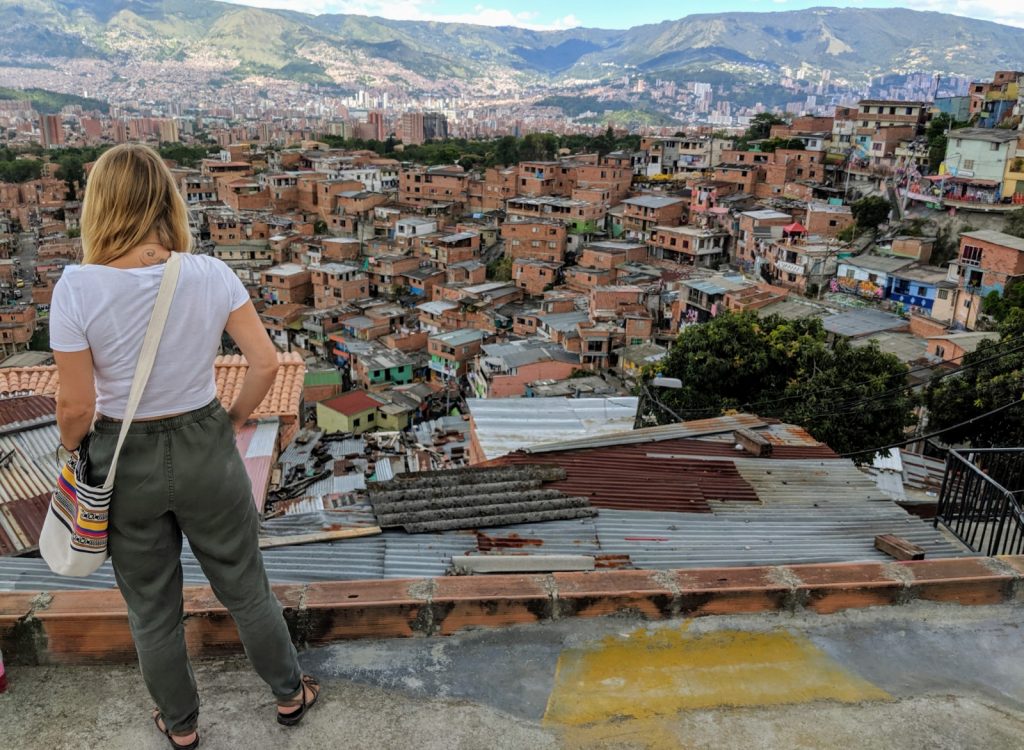
It’s just totally interesting to climb the individual sections of the escalator, exploring each “floor” and treating yourself to a homemade lemonade along the way. On the top step of the escalator, the tourist area is particularly large and you have a fantastic view of the whole neighborhood and Medellin.
How safe is Medellin? A History Excursion
When we think of Colombia, many people think of drugs, cocaine, Pablo Escobar and kidnappings. So did our parents when we told them about our travel plans. And of course it’s true, just a few years ago Colombia was dominated by gang wars and murders were common, especially in Medellin.

3 Weeks in Colombia | The Perfect Itinerary
The history of the city.
Especially in Comuna 13, there was statistically almost one murder per day in the 90s. Medellin was reportedly the city with the highest murder rate in the world as recently as 1991, with a total of 7000 murders. Medellin, and especially Comuna 13, was completely in the hands of the Medellin Cartel . Constant deadly confrontations between drug gangs, paramilitaries and security forces, social tensions and high unemployment brought the city to an extremely desolate state.

Even after the death of Pablo Escobar in 1993 and the resulting dissolution of the Medellin cartel, crime did not decrease. The unemployed hit men now engaged in bloody battles with the communist urban guerrillas. Even years after the end of the cartel, Medellin was still the city with the highest murder rate in the world.
The Situation Today
Only gradually did the situation in the city calm down, and the murder rate dropped significantly after the turn of the millennium. With a new mayor, a lot was invested in the city and things slowly started to look up. Proverbially also in Comuna 13, because in 2011 the famous escalator was inaugurated in Comuna 13.
Since then, the living conditions of the people living there have improved enormously. It used to take forever to get from Comuna 13 to the city center, and it was also dangerous. Today, Medellin has become a tourist destination that is very interesting not only for backpackers, but also for families with children from the USA and Europe.
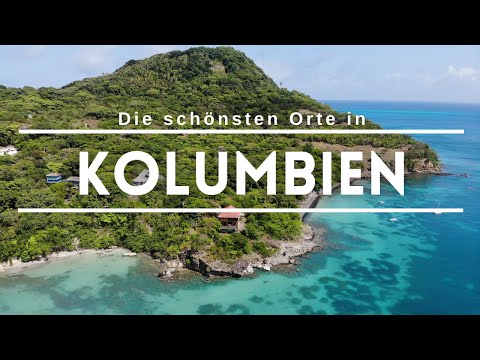
Hotel Recommendation in Medellin
We stayed in a small hostal in the Suramericana neighborhood in a normal residential area and were within 5 minutes of the metro. Then we only had to go 2 stops to get to the center. It was great to live in a residential area so close to the center among locals and not in the tourist district with all the other tourists.
We can therefore only recommend you to look for a nice hostal near the center, so that you are quickly everywhere and are not endlessly on the metro. Our hotel wasn’t super luxurious, but it had super friendly staff and as we said, you were in the city very quickly. If you want to check it out, just click on the following link:
How to get from Medellin to Comuna 13?
Even on your own, it’s totally easy to get from downtown Medellin to Comuna 13.
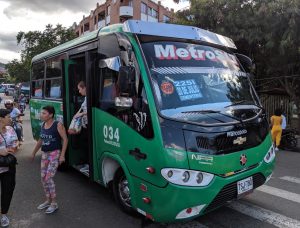
There, take either a cab (8000 COP) or a local green bus (1200 COP) of line 225i, both of which will be waiting for you across the street. The cab may take you to the beginning of the escalator, but more likely will stop at the intersection in front, where the buses also stop.
From there you have to walk uphill for about 300 meters until you can take the first escalator. The exact starting point of the escalator can also be found here here at Google Maps .
Do I need a Guide or a Tour in Comuna 13?
It is recommended everywhere, but we think it is not necessary to join a tour with a guide. Not even for safety reasons. We prefer to do such tours on our own anyway and don’t like to join a group. We prefer to decide for ourselves when we go where and how long we take photos of something. Of course, then you miss a lot of information that the guide can give you on the way, often from his own experience.
If you are interested in visiting Comuna 13 you can book a tour with a local guide * here.
But that is the compromise you have to make. We can definitely recommend doing the tour to Comuna 13 alone and without a tour .
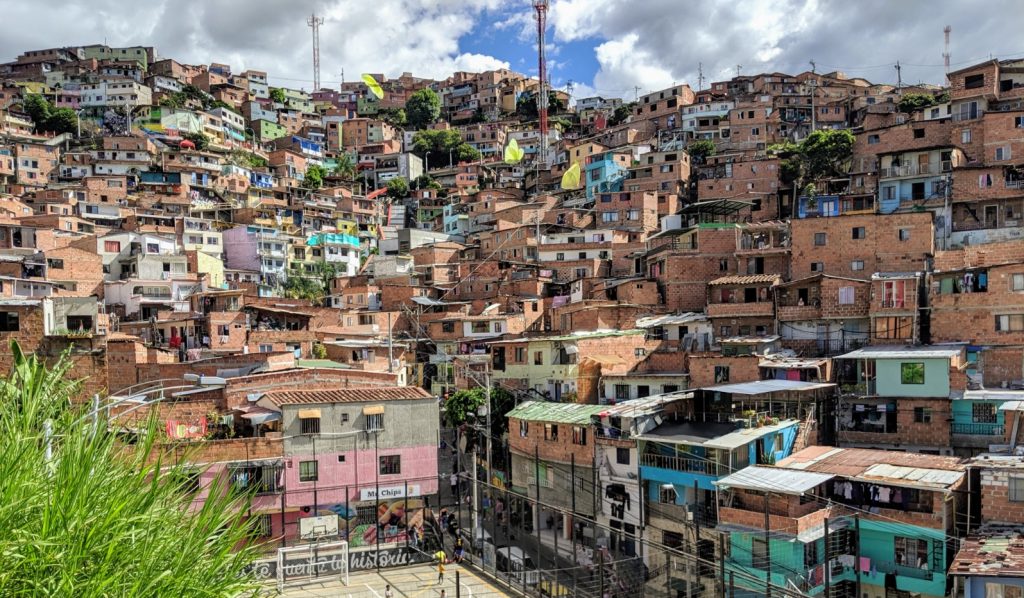
In some blogs you read that you should rather not go too far from the escalators alone. We can not confirm that either. Maybe it was different a few years ago, but nowadays (August 2019) the neighborhood is so overrun by tourists that I can not imagine that you could be affected by a significant crime here as an attentive tourist.
The whole neighborhood also benefits so much from tourism (which I don’t begrudge the residents) that an increased rate of pickpocketing or other criminal incidents would be counterproductive to economic development. The locals sell drinks everywhere, show breakdancing or singing interludes or earn money by selling Pablo Escobar T-shirts. My guess is that in Comuna 13, you have to be more afraid of inflated prices for souvenirs than pickpocketing. But this is of course only my personal opinion.

Leave a Reply Cancel reply
Your email address will not be published. Required fields are marked *
Save my name, email, and website in this browser for the next time I comment.
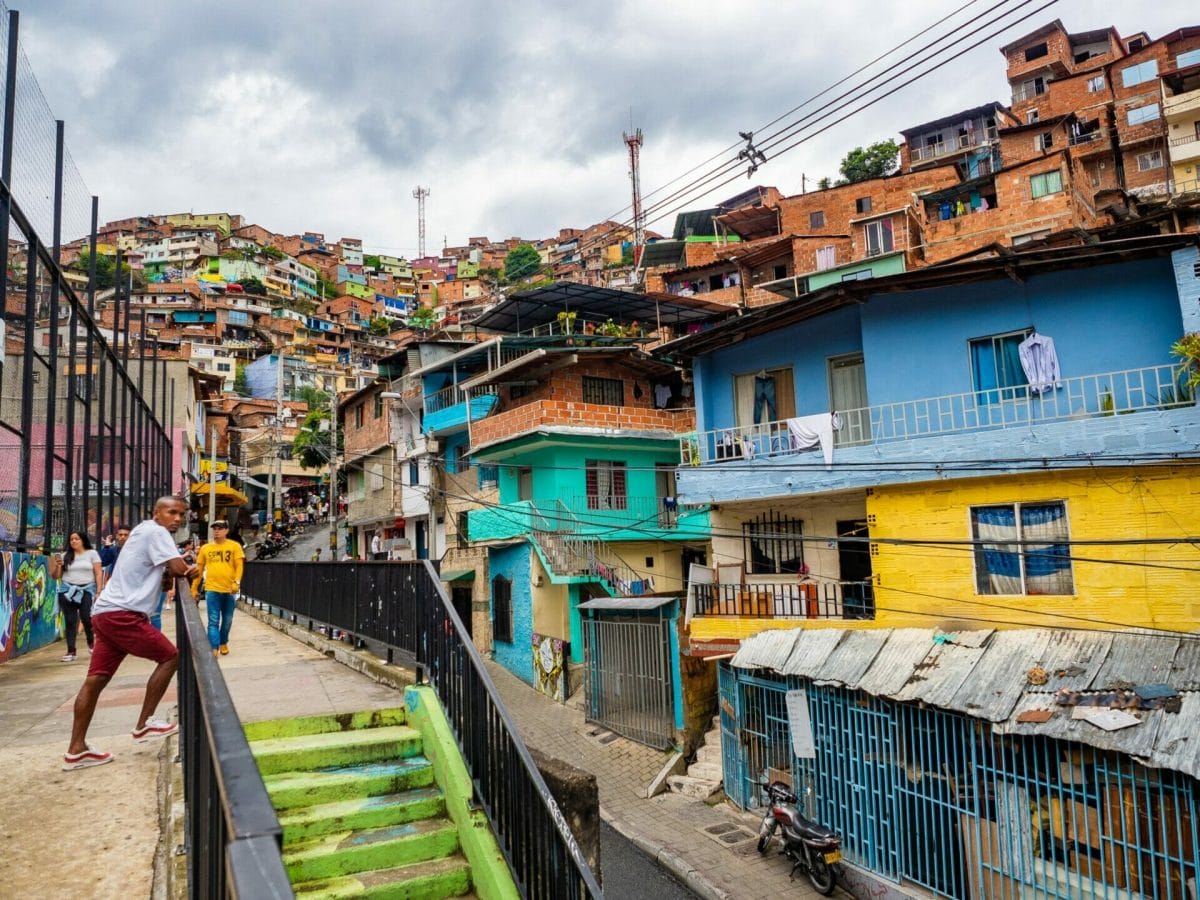
13 essential things to know about Comuna 13 & why you absolutely need to visit
Every day, dozens of energetic, bilingual paisa tour guides stand beneath vibrant red and blue umbrellas outside the San Javier Metro Station, each collecting a small group of travellers with whom to walk through Comuna 13, share stories of Medellín’s darkest days, and showcase the incredible transformation this city has undergone in just a few decades.
Bullet holes are painted over by vibrant street murals, outdoor escalators connect the barrio to the city below, locals sell handmade wares and tasty local delicacies to flushed gringos , and amidst it all, a palpable feeling of hope hangs over a place once plagued by gang violence and mercilessly presided over by Pablo Escobar and his cartel.
Previously the most dangerous neighbourhood in the world’s most dangerous city, Comuna 13 doesn’t seem like the kind of place that would attract a lot of tourist attention— and yet it’s probably the single most important place to visit while in Medellín. Here’s absolutely everything you need to know about Comuna 13, including some of its most significant history, what you can expect to see now, and how to visit the barrio yourself.
What's in this travel guide
1 | Comuna 13 started as an illegal settlement above Medellín
Comuna 13 is a low socioeconomic neighbourhood perched above Medellín , its seemingly infinite swathe of polychromatic brick homes packed tightly onto the steep western hills. Although it’s (nearly) accessible from the Metro line, it’s still a world away from the rest of the city in many ways.
Hillside barrios like Comuna 13 were originally settled after violence in the Colombian countryside drove thousands of citizens into Medellín, all searching for refuge. Unfortunately, many of these people had little more than the clothes on their back and couldn’t afford to live within the city itself, so desperate residents were left to erect ramshackle, unsanctioned domiciles from found materials , practically right on top of each other.
The government didn’t recognise these residences as legal, which meant that Comuna 13 was not only left without any basic infrastructure, but also that the area received no support from the police . Its location and complete lack of police presence is really what combined to make Comuna 13 the perfect drug- and arms-trafficking intermediary between Medellín and the rest of the country— and indeed the rest of the world.

2 | Comuna 13 used to be the most dangerous place in Medellín
Much like the lawless favelas still operating under gang control in Rio de Janeiro , Comuna 13 spent the majority of the 1980s and 90s as a cartel stronghold , its prime (and otherwise unprotected) position between the city and the mountains making it the ultimate corridor for drugs to leave— and weapons to enter— Medellín.
Cast unwittingly at the centre of the Colombian drug trade and favoured by guerrilla groups hoping to arm desperate residents, Comuna 13 found itself hopelessly caught up in an ongoing war between the Medellín Cartel, opposing gangs, guerrilla insurgents like FARC, extremist paramilitary forces, and the government , each vying for control over the barrio .
All of these insatiable powers converging on a single neighbourhood translated to several decades of the most intense bloodshed the city had ever seen, with kidnappings, disappearances, and murder often a daily occurrence in Comuna 13 . Locals describe living under this level of fear as practically crippling, wondering each night whether their loved ones would return home, and yet having no hope of escape.

3 | …which was also the most dangerous city in the world
Comuna 13 was once the most dangerous place in Medellín, but the rest of the city certainly wasn’t free from violence or cartel influence. In 1988, Time Magazine wrote an article titled “Welcome to Medellin, coke capital of the world”, which dubbed Colombia’s second largest city the most dangerous place on earth.
Government officials were assassinated with alarming frequency, bodies lay in the streets from the thousands of people murdered annually , and amidst it all, waring guerrilla and paramilitary groups ripped the country to literal shreds in a bid to gain political power. More than 200 bombs were detonated within the city in a single decade and 6,350 people were murdered in 1991 alone . It’s difficult to imagine living amidst this kind of unbridled, inexhaustible violence, but millions of paisas did.

4 | Medellín & Comuna 13 have changed a lot in recent years
Thankfully, the Colombian government launched a successful operation to expel the cartel and guerrilla groups based in Comuna 13 and regain control of the tattered barrio in 2002. Like pretty much all of the activity within Comuna 13, there was a major unintended toll on innocent residents, hundreds of whom were killed or badly injured in the final military airstrike . Still, this marked a real turning point for Comuna 13— and Medellín.
Present day Medellín is the most vibrant and culturally rich city in Colombia, and perhaps nothing highlights its remarkable transformation better than, just 25 years after being called the “world’s most dangerous city”, being awarded the title of “world’s most innovative city” by the Urban Land Institute and Wall Street Journal . It’s an accolade hard earned but very well deserved.
No where is this incredible transformation better exemplified than in Comuna 13, whose bullet-riddled streets are now lit up by playful children and endless street art , a symbol of how far things have come in the years since gangs and drug lords presided over the city.

5 | …and that’s why you need to visit
Educating yourself about the darkest moments in a city’s history can sometimes feel morbid, but this kind of social and cultural awareness is unbelievably important when we travel . In fact, it’s kind of the whole point.
I don’t think you can really claim to have seen Medellín if you haven’t learned about its storied past, and you certainly can’t appreciate its incredible progress if you don’t know where its people have been . No book or documentary will ever do justice to actually visiting Comuna 13 with someone who lived through the wild fear and incredible violence of Escobar-era Medellín. And that is why you need to visit— to try and understand.
Want to discover more amazing things to do in Medellín? 9 AWESOME THINGS TO DO IN MEDELLÍN, COLOMBIA’S MOST INNOVATIVE CITY

6 | Paisas still don’t like talking about Pablo Escobar
Even though Comuna 13 and its residents are in many ways incredibly open about the past, there’s one subject you’ll almost never hear broached: Pablo Escobar. In fact, most paisas won’t even say his name.
Nearly 50,000 Colombians lost their lives at the hands of the Medellín Cartel, Pablo’s highly organised and influential crime syndicate , over the course of its nearly-two-decade reign— some through direct involvement, but many others because they resisted corruption or simply because they were in the wrong place at the wrong time. Only 20 years ago, bodies lay in the streets, co-opted government officials looked the other way, more than 600 police officers were murdered at Pablo’s behest, and so many families lost their loved ones. These wounds are still very fresh in Medellín.
And so, while the rest of the world has descended inexorably into narco-fever, paisas are taking serious issue with popular media (and tourists) that romanticise their painful history and glorify the man responsible. As Mayor Federico Gutiérrez puts it: “We want to stop this mafia culture that gives us such terrible values. I would say to people who want to come to our city, you are welcome but please respect the story of our victims . They still exist. So much pain still exists.”

7 | Comuna 13 is now known for its street art
From a barrio characterised by violence and poverty to one known for its innovation and social enterprising, Comuna 13 has undergone an enormous transformation in the last few years , symbolised in large part by the art that now covers every building, wall, and stair.
All of Comuna 13’s spectacular street art hasn’t just given the barrio an aesthetic improvement, though— it’s been a creative outlet for locals to share their stories and spread hope for a brighter future , as well as an incredibly effective way to engage at-risk youth in positive community programs. Rather than wagging school or initiating into gangs, young paisas are now being encouraged to develop creative passions like painting. And this is how you should view art in Comuna 13: as a tool for powerful social change and unfettered cultural expression.

8 | …and there’s heaps of other art in Comuna 13, too
In addition to the murals and graffiti art covering every available surface in Comuna 13, you’ll also find lots of other art present in the barrio today. Most notably, talented groups of young hip-hop dancers perform in small squares and rappers spit quick-paced lyrics to crowds of eager onlookers.
These community initiatives are another huge win for Comuna 13, a way to engage young people who might otherwise be at risk for joining a gang or who might be tempted to turn to petty crime as a way to survive in the still-poor barrios around Medellín. Interacting with local artists is a really significant part of the Comuna 13 experience, both for you as a traveller and global citizen AND for paisas hoping to share some of their vibrant culture and beautiful city with the world.

9 | Comuna 13 is also famous for its outdoor escalators
Another of Comuna 13’s most striking features is the long string of outdoor escalators climbing up the hill, and these represent huge progress to locals in terms of social equity and accessibility . Where residents would have previously had to climb the equivalent of 28 stories to reach their home from the city, a 384m series of escalators now cut the journey down to a mere 6 minutes.
In addition to being wildly imaginative and yet another way that Medellín is leading the continent on social innovation, these escalators have provided an unprecedented level of mobility to citizen of Comuna 13 , many of whom had been effectively cut off from the rest of the city due to the physical geography of their home and the difficulty in travelling from its steep streets.
In reverse, the escalators have also brought many city-dwelling paisas up into the hills for possibly the first time AND drawn thousands of tourists to the barrio , a major step in dissolving the stigmatism surrounding Comuna 13 and the socio-economic disparity perpetuated as a result of these attitudes.

10 | Comuna 13 has some of the best views over Medellín
Owing to its prime position in the hills, Comuna 13 also has one of the best views over Medellín that you’ll find anywhere in or around the city . On a clear day, you can see the entire metropolitan area sprawled out beneath you, as well as similarly chockablock brick homes crawling up adjacent hillsides.

11 | You can visit Comuna 13 completely on your own
You can actually visit Comuna 13 on your own for no more than the cost of a metro ticket (2,550COP) and a quick bus ride or taxi to the base of the escalators (5,000COP).
During the daytime, it’s totally safe to do walk around the barrio on your own, and you’ll probably find that locals are happy to chat with you about their home (if you speak Spanish). There are also lots of little art galleries and cafes you can check out, so plan to spend at least a few hours exploring.
Read this post for heaps more info on how to get around Medellín using public transport: 9 AWESOME THINGS TO DO IN MEDELLÍN, COLOMBIA’S MOST INNOVATIVE CITY
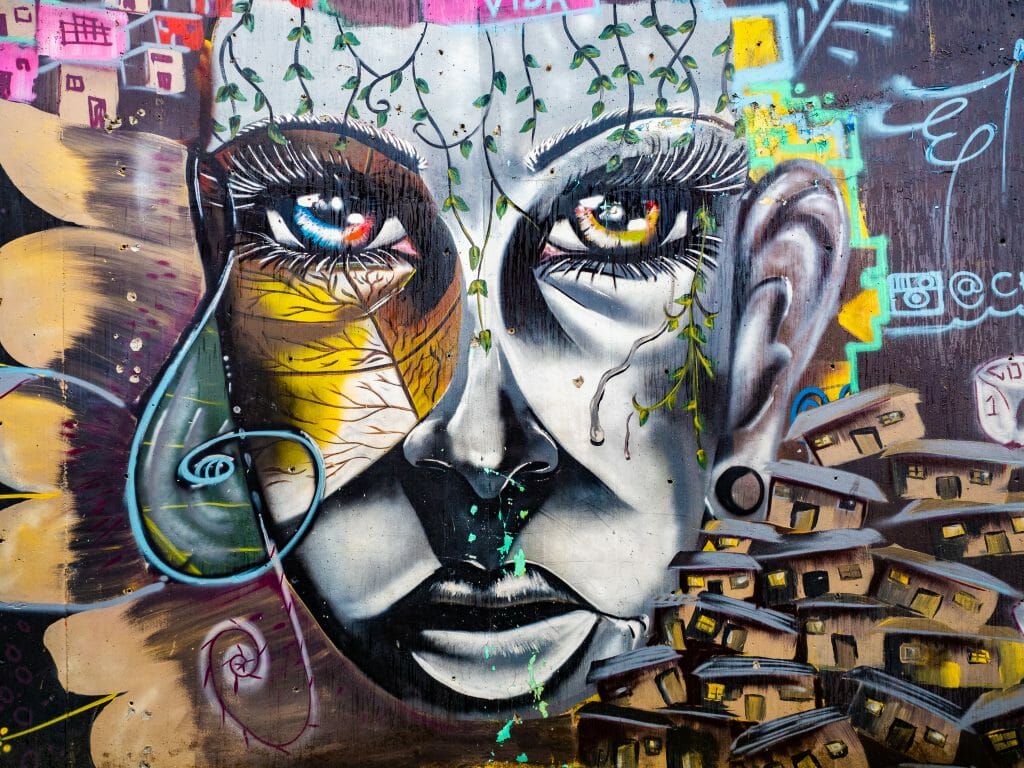
12 | …but I’d recommend going with a local tour guide
Even though you CAN visit on your own, I’d strongly recommend opting for a guided tour instead. Not only is this the best way to learn about the neighbourhood’s transformation and the symbolism behind the most striking pieces of street art, it’s also an excellent way to support locals working hard to de-stigmatise their home.
A vast majority of the tour guides you’ll find (at least the good ones) grew up in Comuna 13 and many still live here today, so you’re also providing direct financial support to the local community.
There are heaps of tour options, but I’d personally recommend Zippy Tours , which departs from the San Javier Metro Station daily at 10am or 2pm. Although the tour is technically “free”, you should plan to tip around 20,000COP (less than $8AUD) per person. I promise it will be well worth it!

13 | Comuna 13 will change your impression of Colombia
Formerly a country whose political instability made it a no-go for travellers, Colombia is now one of the most popular destinations in Latin America , and even if you haven’t concluded that for yourself yet, you probably know half a dozen people who have. Its reputation is night and day to what it used to be, but chances are you’re thinking more about its Caribbean beaches and sultry cities than its troubled history when planning a trip.
Visiting Comuna 13 will change your impression of Colombia, but in the absolute best kind of way. This is a magical country with untold natural beauty, but it’s the incredible story of a dark fate subverted and rebirth from the ashes that really captivates.
Medellín and Comuna 13 are leading global examples of a city’s ability to endure in the face of unimaginable terror and remodel into the best possible version of itself, all whilst preserving a memory of the past and remaining brightly optimistic of an ever-improving future . If that doesn’t inspire you, I’m not sure what will.

Read more about Colombia
9 AWESOME THINGS TO DO IN MEDELLÍN, COLOMBIA’S MOST INNOVATIVE CITY
11 AMAZING THINGS TO DO IN SAN GIL: A GUIDE TO COLOMBIA’S ADVENTURE CAPITAL
HOW TO GET FROM BOGOTÁ TO SAN GIL: COLOMBIA TRANSPORT GUIDE
TRAVELLING FROM BOGOTÁ TO MEDELLÍN VIA BUS OR PLANE: COLOMBIA TRANSPORT GUIDE
THE BEST WAY TO GET FROM SAN GIL TO MEDELLÍN (BUS VS FLIGHT): COLOMBIA TRANSPORT GUIDE
EVERYTHING YOU NEED TO KNOW ABOUT VISITING GUATAPÉ AS A DAY TRIP FROM MEDELLÍN, COLOMBIA
HOW TO GET FROM MEDELLÍN TO SANTA MARTA (BUS OR FLIGHT): COLOMBIA TRANSPORT GUIDE
HOW TO GET FROM CARTAGENA TO MEDELLÍN (BUS OR FLIGHT): COLOMBIA TRANSPORT GUIDE
MORE COMING SOON

brooke brisbine
I've spent the last decade exploring the world— everything from solo trekking in the Andes to overlanding in Zambia, all while completing a PhD in Biomechanics, teaching at a university & securing permanent residency in Australia. In 2020, I finally fulfilled my dream of becoming a full-time nomad! Whether it’s vanlife in Mexico, scuba diving in the Galápagos, ticking off incredible US National Parks, or climbing in the Dolomites, I hope this blog will inspire your future adventures & help you find wonder in every corner of the globe. xx bb
Leave a Comment Cancel Comment
The comments.
a very nice article. I would recommend every0ne take a communa 13 tour on saturday’s after 11am.
I’ve just visited Medellin and Communa 13 two weeks ago. I’ve learnt many of the points the author makes in this article. But the article goes much further. It’s a great article.
Thanks so much for reading, Khoa!
You May Also Like
Los humedales & el muro de las lágrimas: a guide to cycling to the wall of tears on isla isabela, a tribute to earth’s most majestic creature, the llama, ausangate & rainbow mountain trek (day 2): anata to hanchipacha via rainbow mountain.
Comuna 13 Medellín (Full Guide + Tour Recommendations)
Twenty years ago Comuna 13 Medellín was one of the most dangerous places in the world. Run by cartels, rife with violence and crime, overpopulated and unsafe just to live there.
But today, it’s completely transformed. The streets once controlled by drug and weapons traffickers are now full of artwork, street performers and food and drink stalls. And everyday visitors flock to Comuna 13 to learn about its history, immerse themselves in the culture and support the local economy.
Taking a Comuna 13 tour with a local guide is the most popular way people visit this neighbourhood. And you’ll find recommendations for the best here – as well as how to visit by yourself on a Comuna 13 self-guided tour.
Read on for an overview of the history, what to expect in this neighbourhood, how to get to Comuna 13 and the best tours…
Some of the links below are affiliate links, meaning, at no additional cost to you, I may earn a small commission if you click through and make a qualifying purchase.
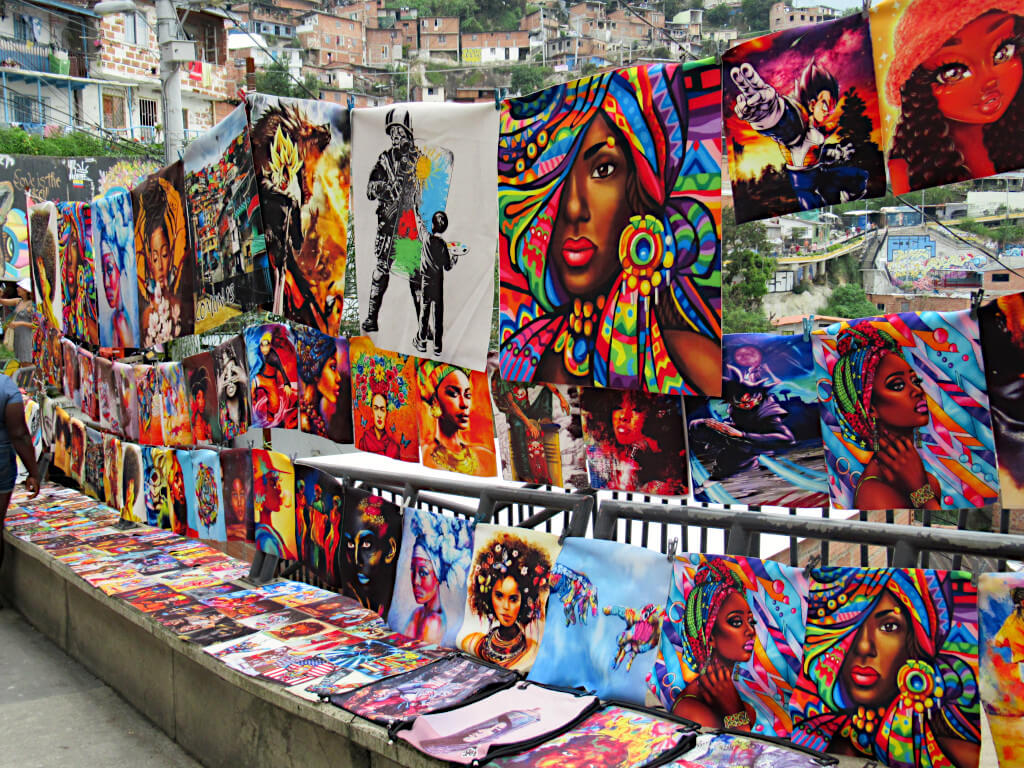
What is Comuna 13 Medellín?
Comuna 13 is one of 16 communes in Medellín. And while most people believe it to be one neighbourhood, it’s actually a whole district with many neighbourhoods across the steep hills.
Today, the area may be popular with tourists enjoying the artwork, street performances and bars . But, Comuna 13 was once known as one of the most dangerous places in the world .
And, the story of that transformation is fascinating…
A Short Comuna 13 History
I’m summarising because the best way to learn about the area is to take a Comuna 13 tour and hear the story from a local. The next best is to read a dedicated and thorough history guide compiled by an expert, not a travel blogger.
Located on the western hills of Medellín, Comuna 13 soon attracted the attention of traffickers. With its location near a main highway, these traffickers realised they could use the area to easily transport weapons, drugs and money in and out of the city .
This was an action that largely went unchallenged. Because the district was home to many migrants from across Colombia with little money or influence.
And quickly, the area became controlled by the gangs who recruited people living there with the lure of money that they couldn’t earn any other way.
Violence and stigmatisation of those who lived there ensued. In fact, many people are still missing today, and their relatives will never know what happened or where their remains lie.
But after years of cartel rule, the Colombian military entered Comuna 13 Medellín in October 2002 . And in a multi-day siege – called Operation Orion – began to overthrow the rebel groups. Bullet holes from that pivotal point in the area’s history remain visible today.
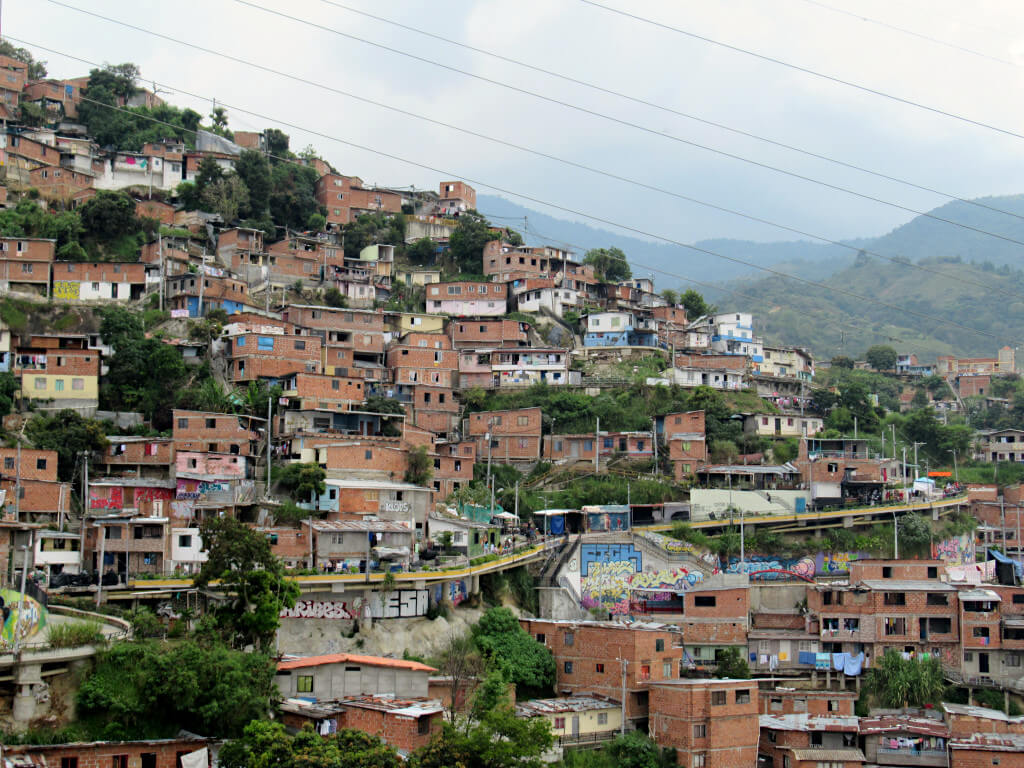
Evolution into One of Medellín’s Most Popular Tourist Spots
Today, you might associate Comuna 13 with vibrant art or confident street performers. But, it still remains an area of low socioeconomic status.
The area has very few roads , requiring residents to walk long distances uphill to reach their homes. The addition of 6 outdoor escalators in 2011 improved the situation only slightly.
Additionally, many of the houses are unfinished – though, this is on purpose to pay lower taxes. However, the corrugated iron roofs are typically pinned down with bricks to prevent them from being washed away during heavy rain.
Despite this, visiting Comuna 13 isn’t a trip to view poverty or feel sorry for the residents. Instead, it’s very much a celebration of the transformation over the last 20 years .
Today, the people are proud to say they’re from this neighbourhood.
Financial investment and the reduction of crime have made the area more appealing to tourists. And now, the locals dance, rap or display and sell their art in galleries to earn money.
Comuna 13 might not have the money, status or towering buildings compared with other neighbourhoods. But, it has soul, purpose, community and a vision for a better future .
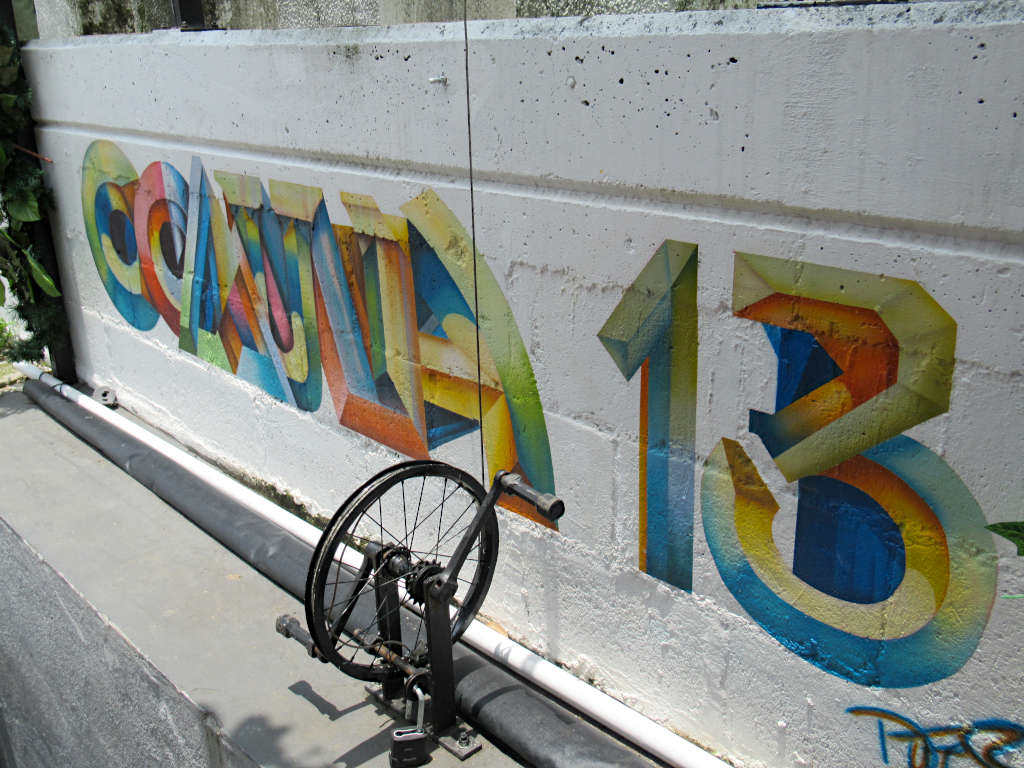
Why You Should Visit Medellín’s Comuna 13
A trip to Comuna 13 is an immersive experience taking you through the streets of a place once dubbed the most dangerous place in the world. It was in many of our lifetimes that crime, poverty, violence and discrimination plagued this part of Medellín.
Yet, in a relatively short amount of time, Comuna 13 has been transformed. Tourism has created jobs, boosted the economy and made the area an attractive place to visit.
As well as being a historically fascinating place to visit, you’ll come face to face with the culture of Comuna 13. It’s vibrant , it’s busy and it’s where real people live and work .
This is no show home, it’s gritty and soulful . You’ll love it.
From a personal perspective, visiting Comuna 13 felt like the most authentic look into life in Medellín , especially being accompanied by a local guide.
As well as his knowledge of historic and recent events told with his memories of each, we bumped into so many people he knew during the tour. Someone setting up a new art gallery, a street performer, someone working in a shop.
And yet, despite being popular with tourists, it feels much more real than the soulless high-rise buildings of El Poblado. Or the grey buildings of the downtown area.
But, Comuna 13 was definitely a highlight of the two weeks I spent in the city. It’s unlike anywhere else in Medellín. The personal touch is really what sets a Comuna 13 walking tour with local guides apart.
INTERESTED IN FINDING OUT ABOUT THE BEST COMUNA 13 WALKING TOUR? > > Jump to the section below on the best tours, DIY visits and what to avoid! < <
Is Comuna 13 safe?
Yes, it’s safe to visit during the day and early evening. Although – like much of Medellín – it’s recommended to not visit at night.
The previous threats of violence, gang warfare and drug trafficking might have gone. But as this is a tourist hotspot, you still need to watch out for pickpocketers and use general common sense methods as in any major city.
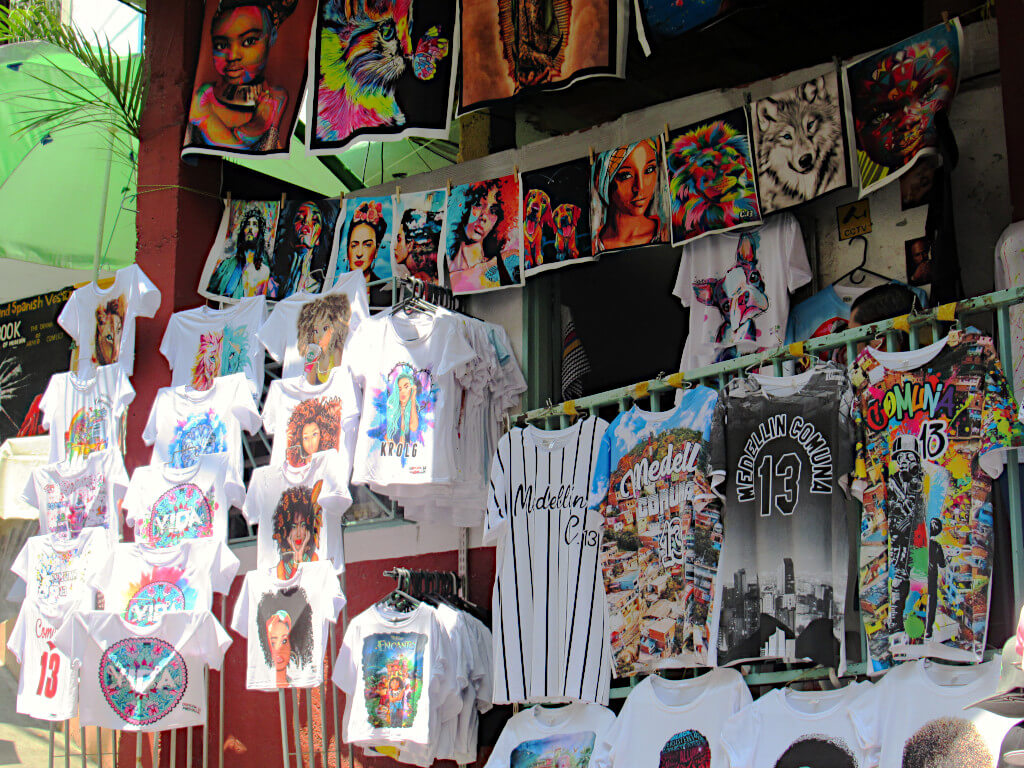
What to do in Comuna 13
The district is huge and there’s lots to see, do and experience. And no two visits will be exactly the same.
There are plenty of ways to get off the typical route. But, here’s where to go in Comuna 13 to see the best bits…
Street Performers, Graffiti and Street Art
From afar, you’ll hear the music from dance groups and rappers . Audience interaction is almost a given, so sit at the back if you don’t want to participate!
The street dancers we watched got a few people up to have a dance-off. The rap group asked us to each say our favourite Spanish word as well as what country we were from. Then, they freestyle rapped with all those words in!
Graffiti art and street art are also everywhere!
On the viaduct, along the escalators and on the side of almost every building! Each has a unique story and meaning, with tour guides typically stopping at various different ones during your visit.
Some of this artwork is also replicated onto canvases, prints and souvenirs that you can take home with you.
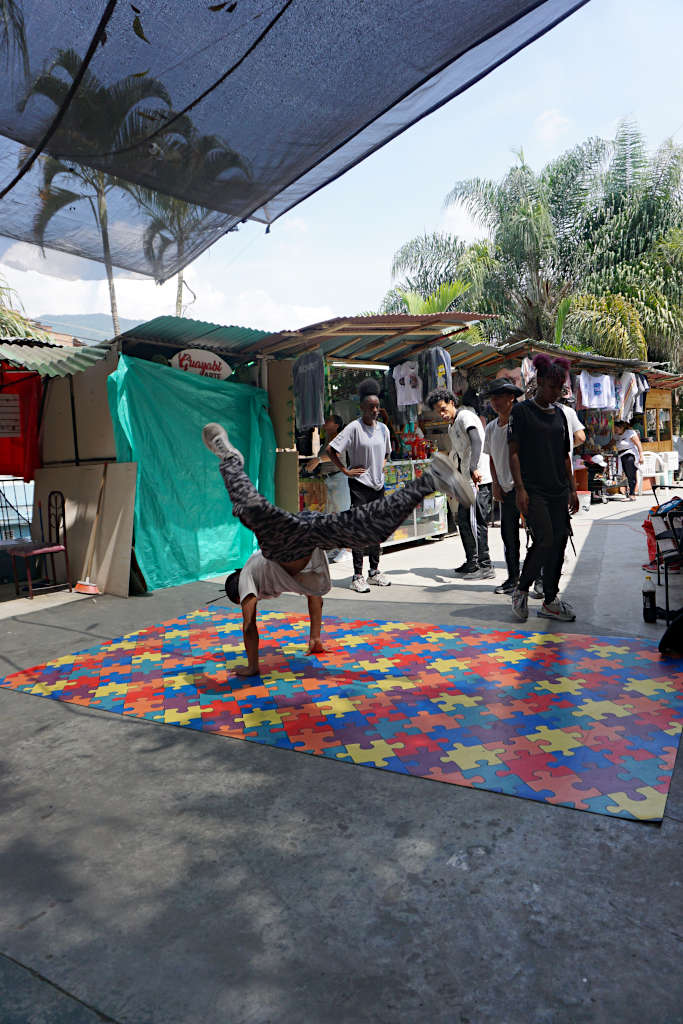
Comuna 13 Escalators
The escalators – somehow – are both the least and most interesting thing about Comuna 13 . Honestly, these escalators are just like every other one you’ve seen before, except they’re not.
They were installed after the siege in Comuna 13 to regain control from the gangs and cartels. As the government’s way of providing compensation to the community.
Because one of the biggest inconveniences to people living in the area was the difficulty in travelling around. Since the only way was up and down narrow stairs, with no roads for vehicles.
The installation of 6 escalators (3 going up and 3 going down) reduced a 25-minute uphill walk to 6 minutes travelling on the Comuna 13 escalators. This was transformative for those with reduced mobility, young children and carrying heavy shopping!
However, in a neighbourhood the size of Comuna 13, 3 pairs of escalators only solve the ease of access issue for some people.
And, of course, there’s the fact that the 6 Comuna 13 escalators do not make up for years of gang rule, sky-high murder rates, a siege and the transfer of power to paramilitary groups! It’s a controversial subject, for sure.
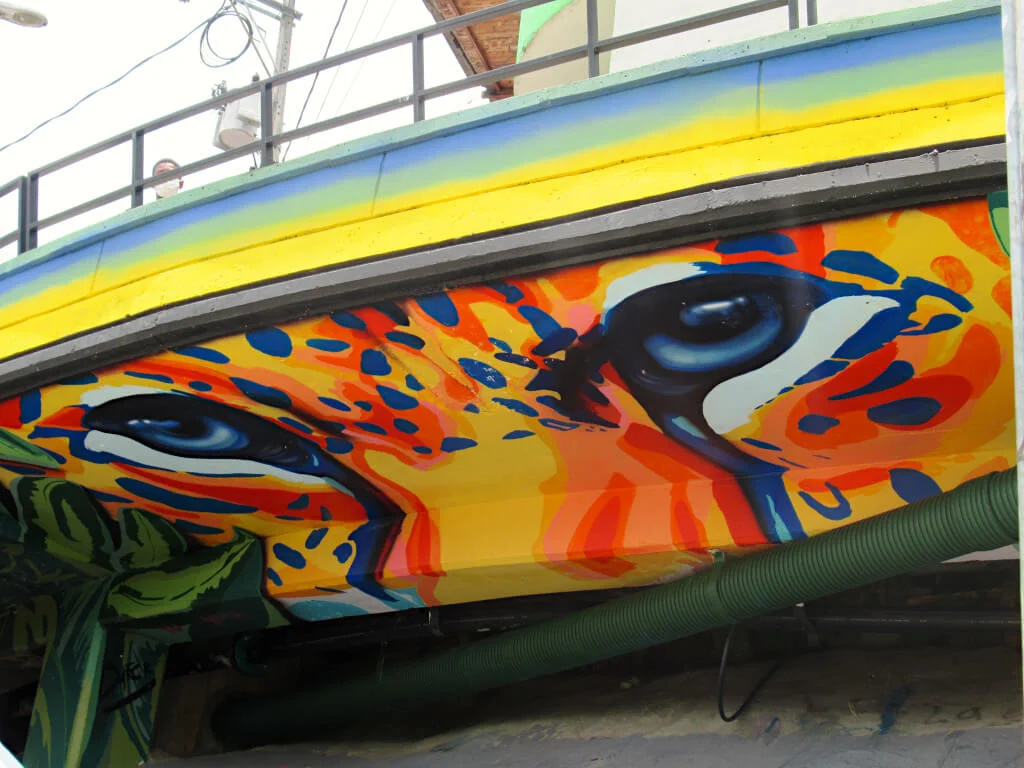
Art Galleries and Souvenir Shops
Speaking Spanish might be the way people in Comuna 13 communicate but art is the real common language here . As well as the huge amount of street art, Comuna 13 is also home to a large collection of art galleries and art shops.
Around the escalators, there’s some immersive, neon galleries that you can walk inside for a bedazzling experience! Plus, there’s the more traditional art galleries and shops that display canvases and prints available for purchase.
As well as artwork in the more traditional form, some of the most popular designs are also available on souvenirs . T-shirts, tote bags and the like are easy to come by featuring the best of Comuna 13’s artwork.
Cafes, Coffee Shops, Bars and Restaurants
Not often thought of as a place for a drink or a meal. But as a popular tourist destination, there’s a good number of bars and restaurants around the central area (i.e. near the escalators).
Stalls and small shops selling ice cream, coffee, beers and soft drinks are also commonplace. If you’ve never tried avocado-flavoured ice cream, this is your chance…
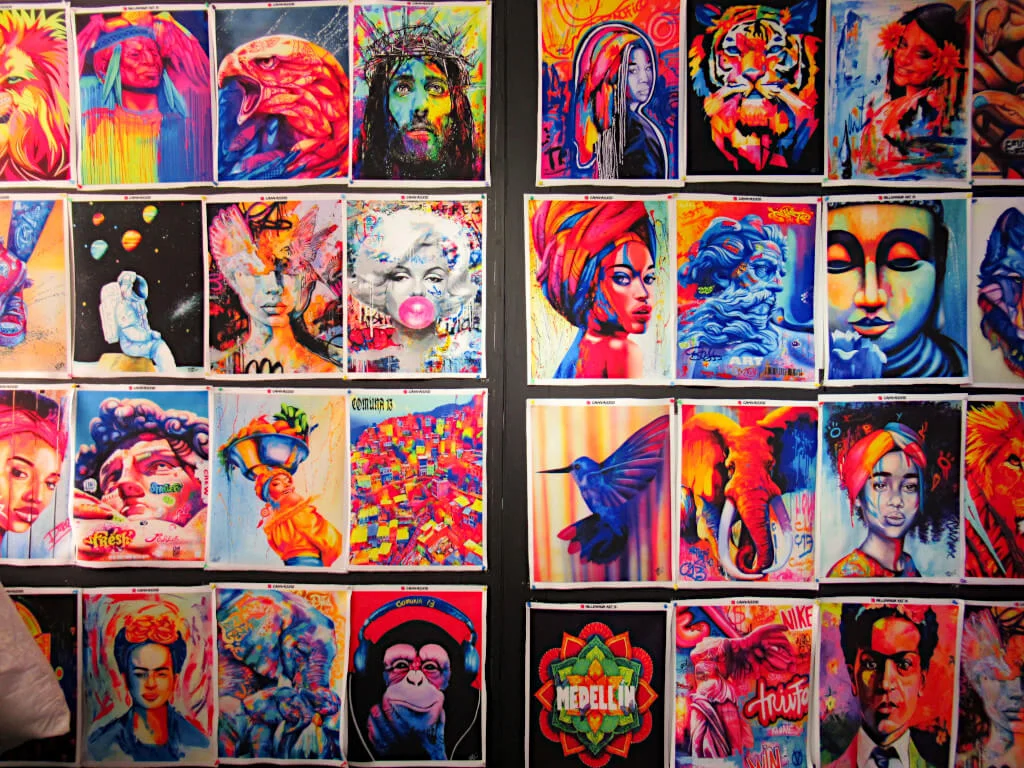
Comuna 13 Tour Recommendations (And How to Visit By Yourself)
For exploring Comuna 13, you have three options:
- Paid-for tours (pay upfront)
- Free walking tours (where you tip at the end)
- Going and walking around by yourself
Each has its pros and cons and each will suit different people.
For example, free walking tours have local guides to give you unique insight and a personal touch. Whereas going self-guided, means you can explore different areas away from the main roads.
Best Comuna 13 Walking Tours
- BEST OVERALL: COMUNA 13 HISTORY & GRAFFITI WALKING TOUR
- BEST PRIVATE TOUR: COMUNA 13 & DOWNTOWN WALKING TOUR
Free walking tours aren’t exactly free when you consider the tip. So, if you’d prefer to pay upfront or online (and in your own currency) then a tour where you pay in advance is for you.
A paid-for Comuna 13 Medellín tour is also for you if you prefer the comfort of having transport included to and from your hotel or hostel, typically in El Poblado to Comuna 13. Although, do check carefully as not all include this.
But other than that, the paid tours don’t include anything you wouldn’t get on a free walking tour. So make sure you don’t get overcharged.
These tours are typically priced around the 20 to 25 USD mark (80,000 to 100,000 COP).
My top pick is this Comuna 13 history and graffiti tour with a cable car ride . It offers great value and can be booked online to secure your date – with free cancellation up to 24 hours beforehand should your plans change.
Check out prices and availability for your travel dates…
But, if you’re after a private or small group tour , then there are some pretty economic options. These typically include hotel or hostel pick-up so are suited to new or first-time travellers…
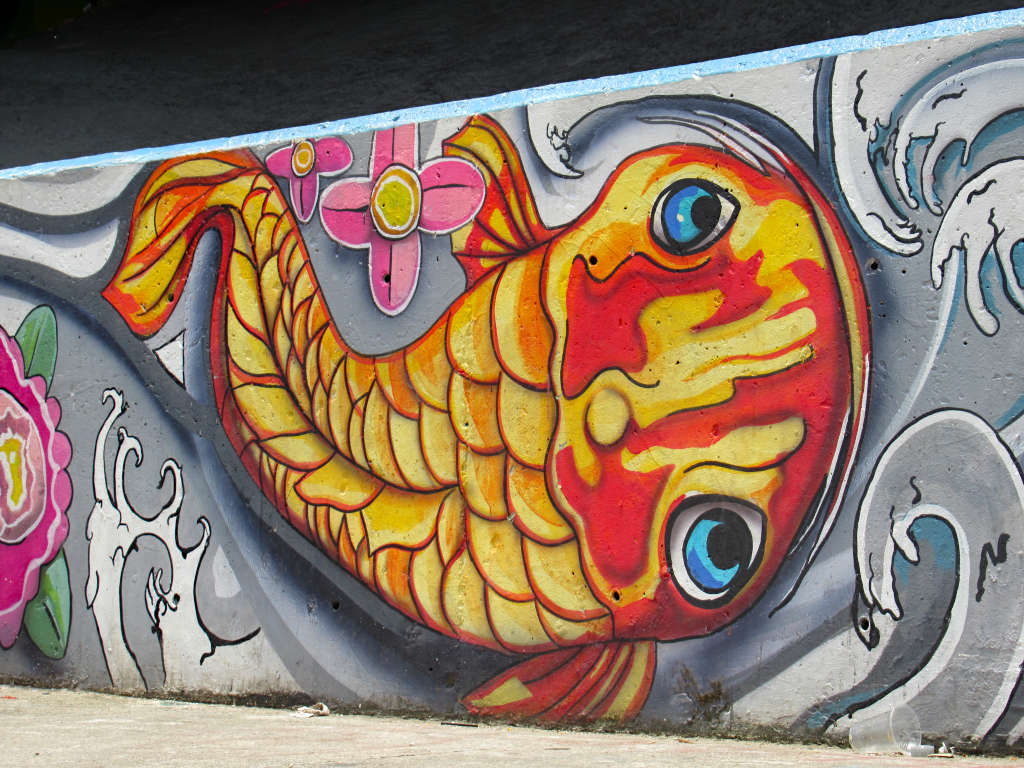
Free Walking Tours of Comuna 13
The Comuna 13 free walking tours typically start at San Javier Station . Here, you’ll meet your guide and group before heading into the Comuna by bus , the price of which (2000 COP) is not included in your tour.
Almost all the Comuna 13 free tours are led by guides who themselves grew up and continue to live in the district . Meaning they provide a unique and personal insight into the history of the neighbourhood and the current tourism boom.
Each company and guide takes a slightly different route and approach to showing you the best of the area.
However, you can expect your Comuna 13 tour to include watching rappers and street dancers and visiting art galleries and coffee shops (with free samples). As well as learning more about the different pieces of street art.
The free Comuna 13 walking tours are the best all-around value option , as the guides work on a tip-based model to get paid.
25,000 COP is the recommended tip amount. But it’s optional and you can tip what you think it was worth or what you can afford.
The tours typically last around 2.5 hours and end in Comuna 13. So you’ll need to make your own way back to the metro.
Recommendations for English and Spanish walking tours: Civitatis , Guru Walk and Zippy Tours .
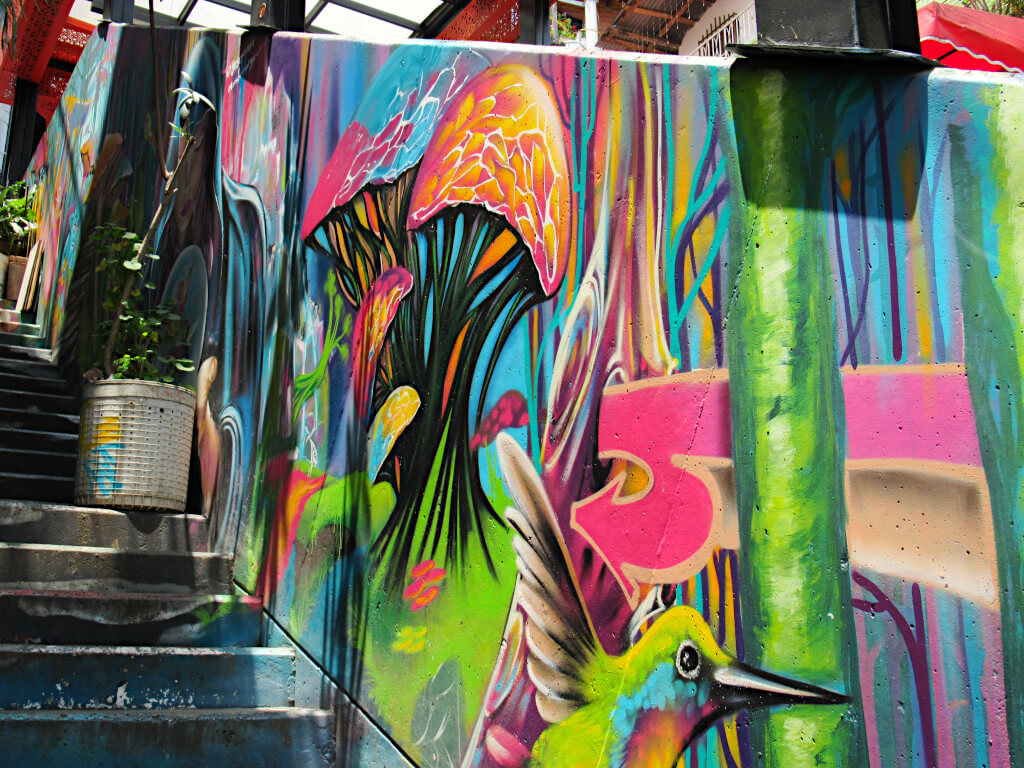
Comuna 13 Self-Guided Tour
Not everyone enjoys tours and that’s ok. If you fall into that group, then you’ll be thrilled to know that you can explore Comuna 13 by yourself, easy peasy, lemon squeezy!
Yes, that’s right, you don’t need a tour or guide to visit Comuna 13 . You can simply go there, walk the streets, drink in the bars, photograph the artwork and more, all by yourself.
Yes, it’s completely safe to do so and during the day and early evening, you’ll find plenty of tourists doing the same.
As in cities across the world, you should take extra care after dark. And make sure you have a way to get back to where you’re staying safely.
While you might miss out on some information, insight and anecdotes from a guide. You can always ask your questions to the many friendly and welcoming people working in hospitality and tourism in the neighbourhood.
Of course, the more Spanish you know, the better . Don’t expect English to be widely spoken here.
Additionally, you don’t have to choose between a walking tour and a Comuna 13 self-guided tour. The walking tours can be great to get your bearings as off of the main street, it’s a maze. You can take a walking tour and then spend a few more hours walking around either the same day or another day.
Recommendations: Visit early in the day to beat the crowds. Morning tours meet at San Javier around 10 am and get to Comuna 13 Medellín around 10.30 am. The afternoons are even busier.
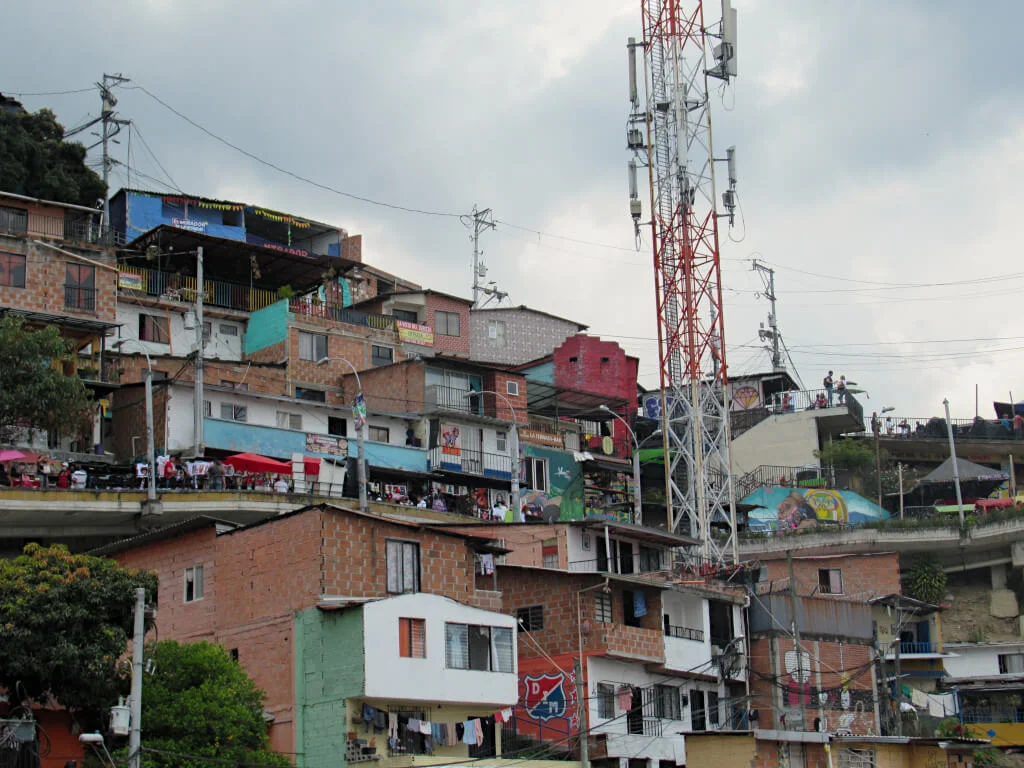
What a Comuna 13 Tour is not…
Pablo escobar or narco tourism.
Of course, there’s an undeniable link between Comuna 13, Pablo Escobar and the narcotics trade. But, tours of the district do not focus on the drug lord specifically nor the drug trade .
Pablo Escobar tours are available in Medellín. Although these are very unpopular with locals who would prefer their city stopped being associated with a man who caused so much damage and pain.
These tours typically visit a museum curated by a family member, which I’ve heard from many people to be overpriced and underwhelming.
For a more morally sound education on the role Pablo Escobar had in making Medellín what it is today, take the Real City Tours downtown walking tour . It’s free and you’ll get a complete introduction to the city.
Graffiti Tour
A few tours advertise themselves as ‘Comuna 13 Graffiti Tours’ but they don’t just focus on the graffiti . In fact, they’re no different than the ‘standard’ Comuna 13 walking tour option listed above.
These self-proclaimed graffiti tours still watch street performers, still visit the escalators and still see the shops and stalls.
Of course, like the standard walking tours, they do take you to various pieces of graffiti and street art. But importantly, that isn’t the only thing you’ll see on a graffiti tour of Medellín.
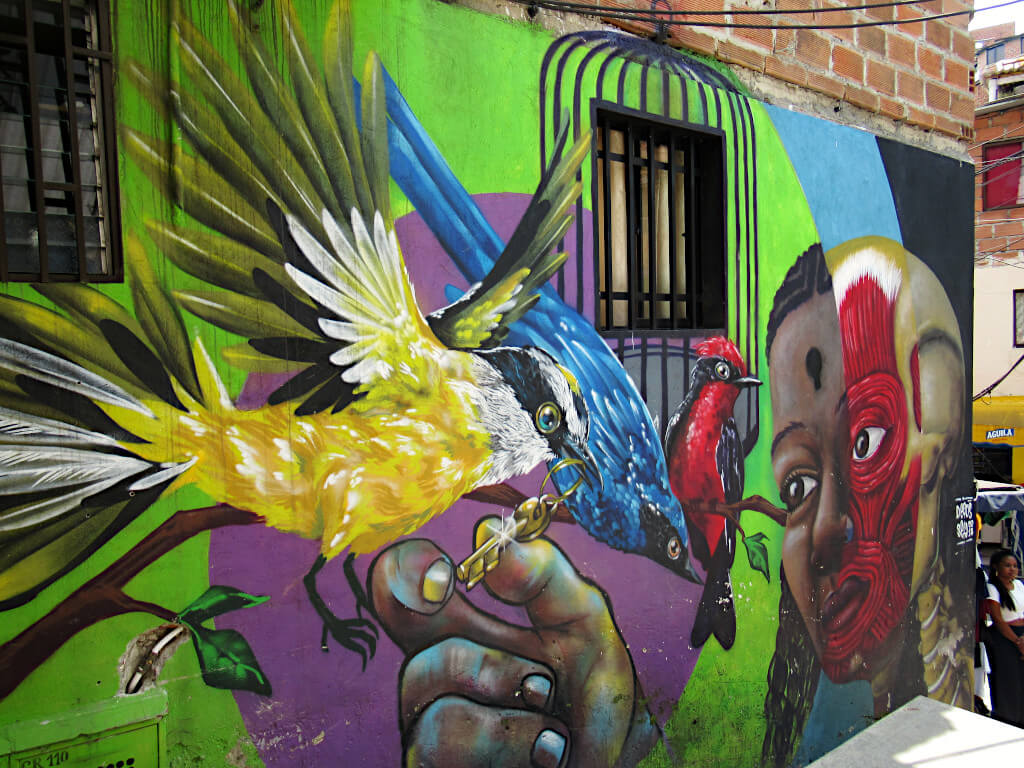
How to Get to Comuna 13 Medellín
Getting a taxi is the most direct option, but Medellín traffic can add unexpected time and cost to your journey all throughout the day.
Instead, take a metro to San Javier Station. From there, you can either walk (uphill, I don’t recommend it), take a taxi or take a dedicated bus running from the station to the lower part of Comuna 13 (2000 COP per person).
How to Get to Comuna 13 From El Poblado
Travelling from El Poblado to Comuna 13 is simple and cheap. If you don’t already have one, you’ll need to buy a Metro Card from the kiosk at the metro station for 10,000 COP.
When buying the card, you’ll also be able to put credit on it for your upcoming journeys.
However, you can have one Metro card for multiple people. You’ll just need to pass it along as you pass through the gates and ensure it has enough credit.
All metro journeys in Medellín cost 3280 COP for tourists , including changes as long as you don’t exit through the barriers.
From Poblado Metro Station, take Line A in the direction of Niquia . After 4 stops, change at San Antonio Station for Line B to the last stop: San Javier Station .
From San Javier, you have three choices to take you into Comuna 13:
- Walk . But it’s all uphill and you’ll be doing plenty of walking around when you arrive, so I don’t recommend it.
- Taxi . Uber or Cabify typically charge around 7000 to 8000 COP but metered taxis will be more.
- Bus . There’s a special bus service from San Javier Station to Comuna 13 for visitors. A one-way fare costs 2000 COP and you can pay with cash or a Medellín Metro card .
Remember, if you’re joining a Comuna 13 Medellín tour most of these have San Javier Metro Station as the meeting place. So, you only need to travel to the station and then you’ll travel as a group into the district.
Got Everything You Need?
Now you know a little bit about Comuna 13, you’re ready to learn more when visiting. And honestly, the locals are the best people to learn from.
Don’t forget to book your Comuna 13 Medellín tour online – secure your date with free cancellation up to 24 hours beforehand.
Do you have any questions or want any more information? If so, drop a comment below and I’ll get back to you!
Information and prices are correct as of December 2023 but are subject to change in future.
More Colombia Travel Inspiration…
BOGOTÁ : El Salto del Tequendama Falls: Bogotá’s Hidden Gem [Ultimate Guide]
BOGOTÁ: Cascada La Chorrera, Choachi: Colombia’s Tallest Waterfall (Complete Guide)
SANTANDER: San Gil Santander: Complete Guide to Colombia’s Adventure Capital
LA GUAJIRA: Palomino Beach (Colombia’s Caribbean Coast Paradise): Ultimate Guide
QUINDIO: Salento, Colombia: Ultimate Guide (Quindío’s Prettiest Town)
HUILA: Tatacoa Desert, Colombia: Essential Visitor’s Guide
PIN IT FOR LATER!
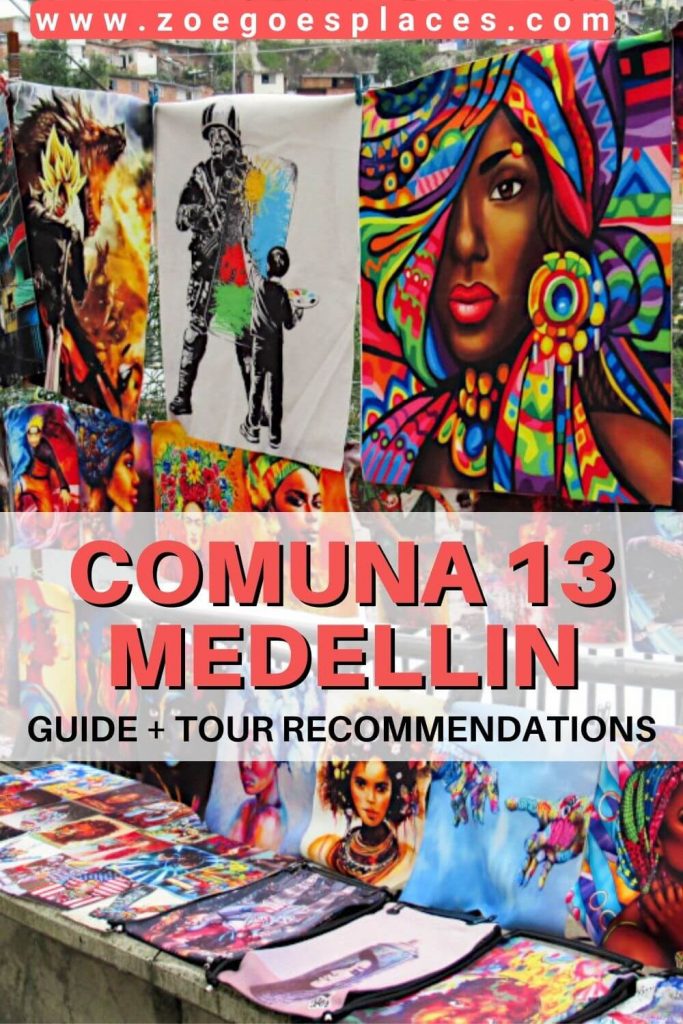
Leave a Comment Cancel Reply
Your email address will not be published. Required fields are marked *
Save my name, email, and website in this browser for the next time I comment.
Wander-Lush
13 Things to Consider Before You Book a Comuna 13 Tour in Medellin
Comuna 13 is known for its street art – but there’s a lot more to this neighbourhood than pretty murals and selfie spots. Here’s everything you should know before taking a Comuna 13 tour in Medellin, Colombia based on my personal experience.
J ust a few short years ago, Comuna 13 was considered the most dangerous area in Medellin , itself the most dangerous city in the world.
Tourists didn’t dare set foot here – they had no reason to. And many locals, as our Comuna 13 tour guide Laura told us, were too ashamed to admit that they lived in the ramshackle suburbs that cling to a mountainside on Medellin’s western fringe.
Now, it’s a very different story. Over the past decade Comuna 13 has undergone an almost complete transformation – or so it seems.

The area is no longer known for gang violence, police raids, cartels and illegal trafficking.
These days, Comuna 13 is more readily associated with graffiti, street art performances and walking tours. New infrastructure, including a cable car system and six outdoor escalators, has made life in Comuna 13 a whole lot easier for residents and opened the area up to tourists like never before.
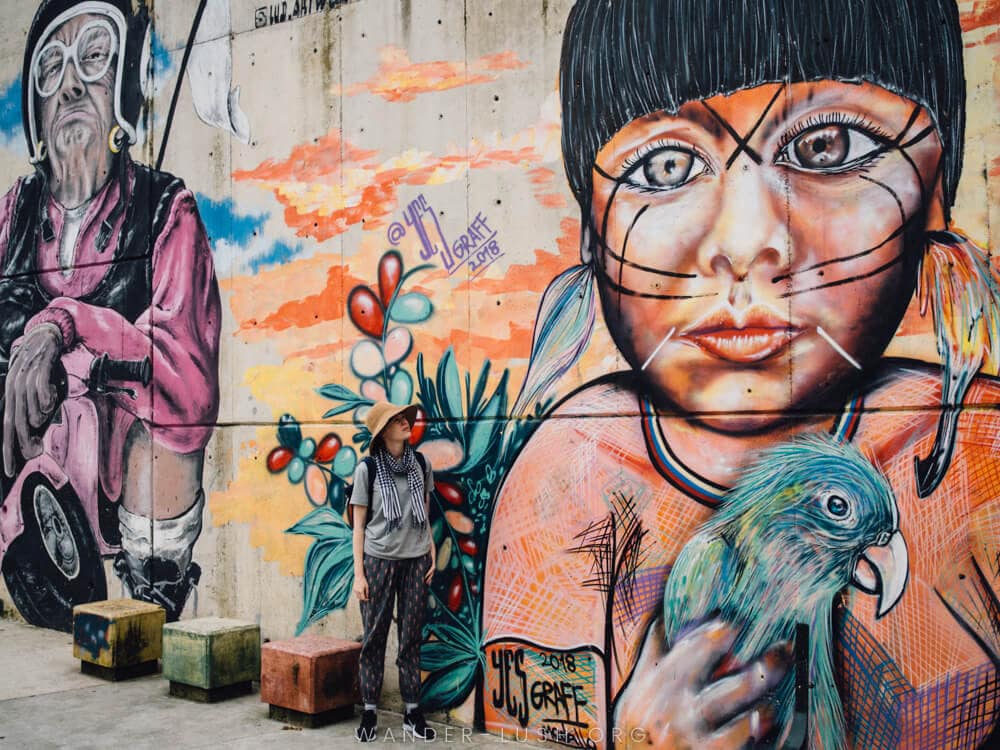
Many people view Comuna 13 as a symbol of Medellin’s (and indeed Colombia’s ) social transformation. It’s one of the most vibrant and intriguing places we visited in Medellin and a must-see, even if you only have a couple of days in the city .
However, there are still a lot of misconceptions surrounding Comuna 13, especially regarding safety. Part of the joy of visiting is discovering these contrasts and contradictions for yourself. But there are a few things I wish I had known before we signed up for our Comuna 13 tour .
Here are 13 things I think you should consider before you go, plus my recommended Comuna 13 walking tour itineraries.
Please note: This post contains affiliate links, meaning I may earn a commission if you make a purchase by clicking a link (at no extra cost to you). Learn more.
Recommended Comuna 13 Tours
Option 1: 4-hour graffiti tour with a local guide – This top-rated tour includes metro tickets, snacks, and invaluable insights from a local guide. Two departures daily in the morning and afternoon. Prices start from $25. (Also available to book here on Viator .)
Option 2: Private Comuna 13 tour with hotel pick up – An in-depth Comuna 13 tour tailored to your interests. Flexible start time and hotel transfers included (great for families, solo travellers or groups). Prices start from $37.\
Option 3: Full-day city tour with cablecar and Comuna 13 walking tour – Longer walking tour (5+ hours) that shows you the best of Medellin downtown as well as Comuna 13. If you only have a day in Medellin, this is a great option. Prices start from $46.
Option 4: Social Transformation Tour – This walking tour with hotel pickup focuses on the neighbourhood’s history to give you an in-depth understanding of Comuna 13. I have personally travelled with Steven, the company operator and main guide, and was extremely impressed with his knowledge and attention to detail. Prices start from $61.
Option 5: Comuna 13 Graffiti Tour and Street Food Tour – The ultimate combination of street art and street food for a comprehensive introduction to all aspects of local culture. Includes empanadas and ice cream.
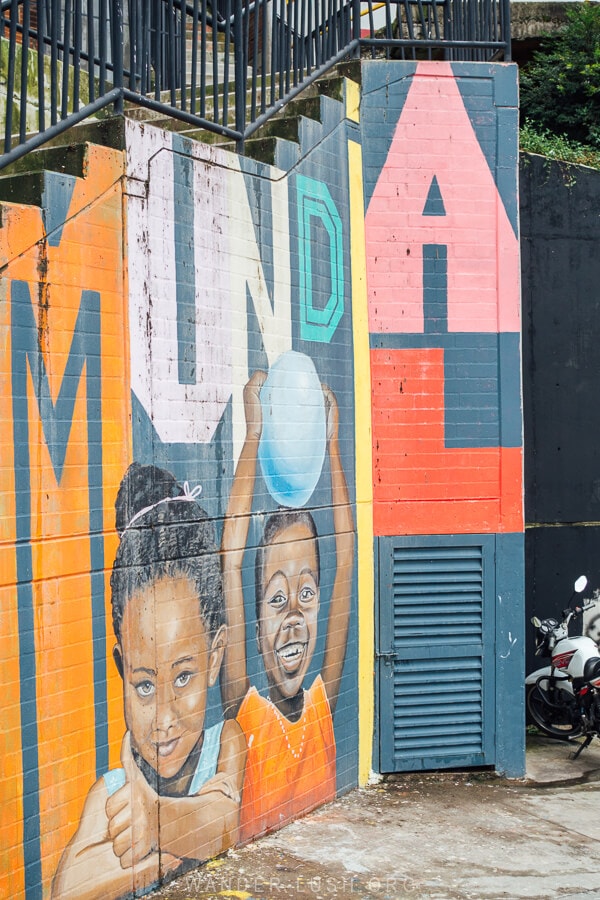
Before you go…
If you’re planning to visit Medellin and you want to learn a bit about Comuna 13 and Colombian culture before you go, why not try a virtual travel experience where you can meet and chat to a local.
This Airbnb Online Experience with a local takes you through the basics of Colombian history and culture – it’s the perfect way to prepare for your trip!
What is Comuna 13? A very brief history of Medellin’s most notorious neighbourhood
One of the most important things you can do before visiting Comuna 13 is take the time to read a bit of background information. You’ll learn lots on the tour, but it helps to have a general understanding of the area and its turbulent past.
Comuna 13 started out as an illegal settlement. In the 1960s and 70s, around 1,500 families displaced by conflict in different parts of Antioquia Department settled here. The neighbourhood was unplanned: They built their houses from basic materials, and there was no running water or electricity.
Comuna 13 rose to notoriety in the 1980s and 1990s at the height of Colombia’s drug and gang era. Because of its location on the edge of the city and the way its organised (winding streets and an awful lot of places to hide), the barrio became a transit point for drug traffickers, guerillas, gangs, and otherwise unsavoury characters. Soon enough, paramilitary groups ELN and FARC were fighting for control of the commune.
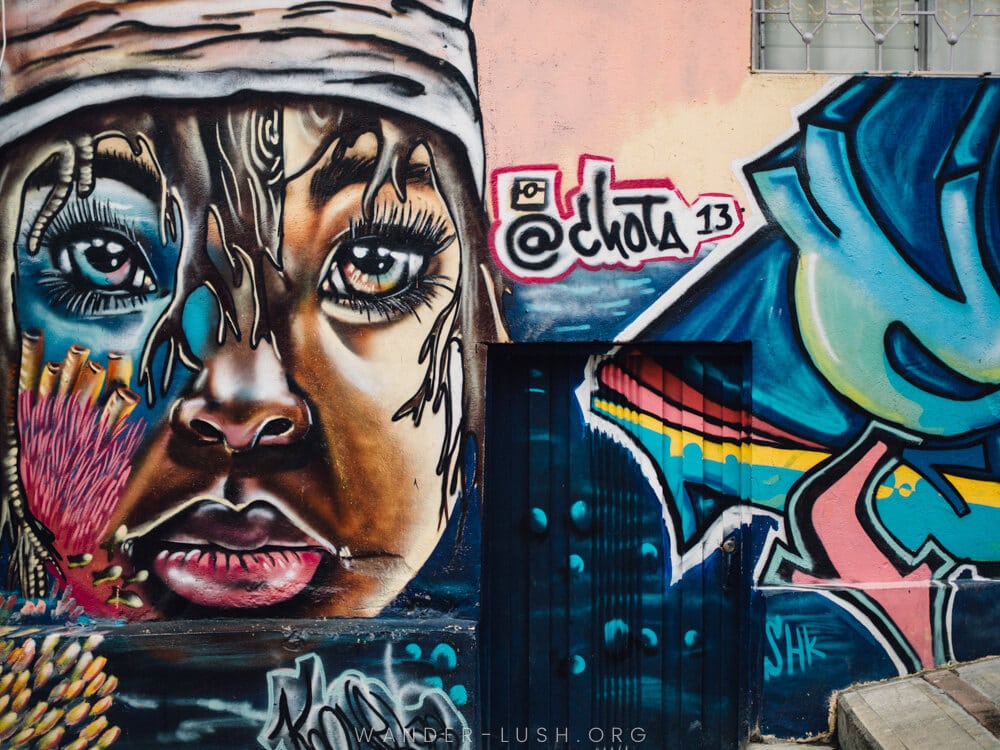
The idea to ‘clean up’ Comuna 13 started in 2002 when a newly elected President Alvaro Uribe took a heavy handed approach and launched 10 military operations. The two biggest, known as Mariscal and Orion, were designed to root out the paramilitary. As you can imagine, many residents – regular working families and innocent civilians – got caught up in the fray. At least 20 people lost their lives, almost 250 were arrested, and many more simply disappeared.
In 2006, Comuna 13’s image finally started to change. Medellin Mayor Sergio Fajardo Valderrama took a different tact and set about improving living conditions for underserved families by involving them in the process. He invested massively in infrastructure, including a new metro station (2008) and outdoor escalators escaleras electricas (2011), to reintegrate the commune with the rest of the city. This approach turned out to be much more effective.
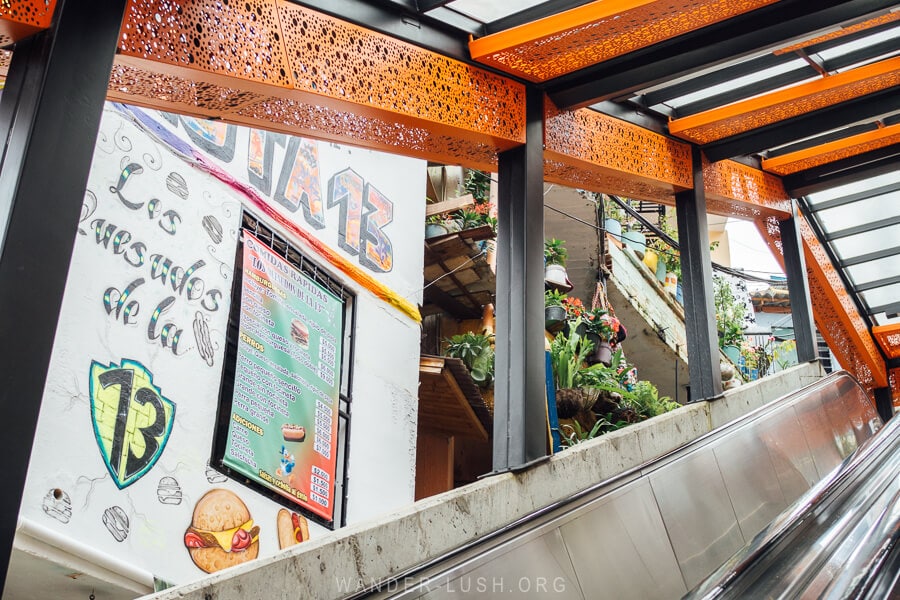
The Comuna 13 of today is a very different place. With greater accessibility came less stigma, and the narrative surrounding Comuna 13 slowly started to shift. The streets became safer, and the neighbourhood was once again a playground for children and artists alike. Now responsible tourism is a major contributor to social change in the barrios.
When you visit Comuna 13, you can witness this incredible transformation up close. No one has forgotten the past, but everyone is looking towards a brighter future. It really is a remarkable story and a special place.
13 things to know before signing up for a Comuna 13 tour
1. it’s not a place for dark tourism or ‘narco tourism’.
Colombia’s own brand of dark tourism, ‘narco tourism’, is a thriving industry in Medellin. What many partakers don’t realise is just how offensive many locals find it. If you want to do paintball at one of Pablo Escobar’s former residences, then be my guest. I’m not here to judge.
But Comuna 13 is not the place to gawk at the horrors of the past.
Transformation, rebirth and hope are themes that come up again and again in Comuna 13. These are the things your guide will focus on, not the violence of the 80s and 90s.
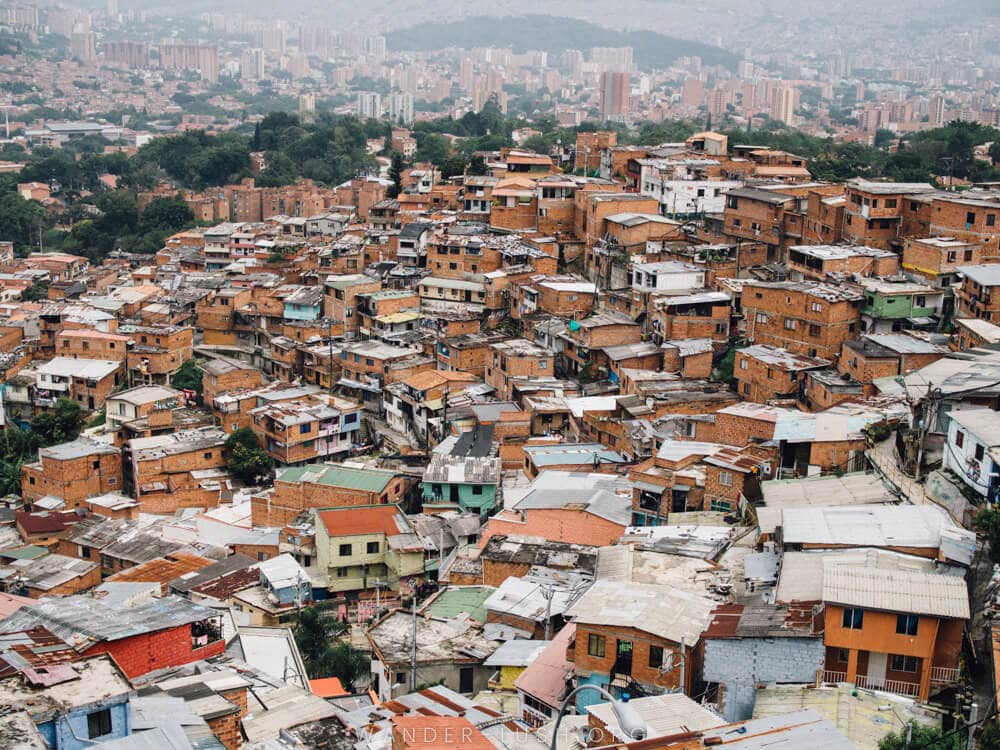
Comuna 13 has undergone a massive physical transformation in recent years, as documented in memoirs like this one . But what’s even more important than the aesthetic changes is shifting the way people think about the area. And that has involved a transformation of the psyche.
There are countless books about Colombia (fiction and non-fiction) that can give you a deeper insight into this chapter of national history before you arrive in Medellin. But the best way to learn is to experience it on the ground.
Most people in Comuna 13 (and Medellin) choose to look forward, not back. Memories of past violence are still very raw for families in this area, with many thousands of people still unaccounted for.
Bottom line: Be respectful and sensitive, and please leave your Pablo Escobar t-shirt at home.
2. Comuna 13 isn’t one neighbourhood
There’s a common misconception that Comuna 13 is one discrete barrio . In truth, it’s a commune (one of 16 in Medellin) that incorporates around 12 separate neighbourhoods spanning more than 2 square miles.
The name ‘Comuna’ does not only refer to the low socio-economic hilltop barrios around the city, either. El Poblado and Laureles are comunas too. El Centro, for example, is a district within Comuna 10.
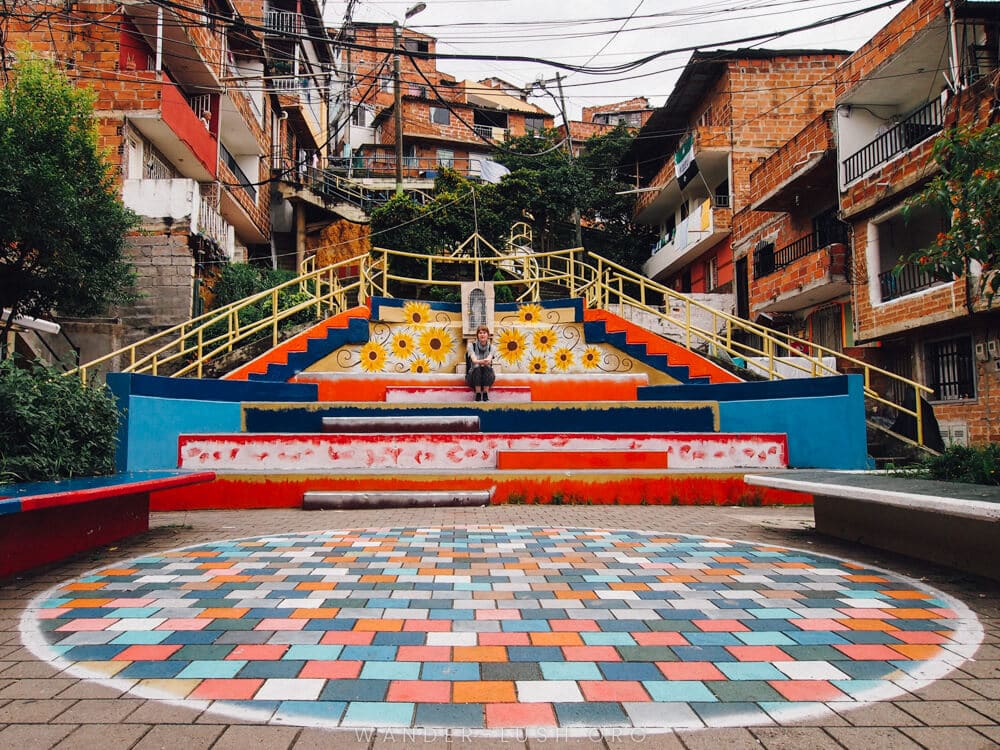
It’s important to understand that Comuna 13 is huge. Some areas are safe for tourists to visit, while other barrios should be avoided. Most walking tours focus on the Las Independencias and 20 de Julio area, where most of Comuna 13’s street art is located.
Because of the size and layout, it’s very easy to get disorientated in Comuna’s 13’s labyrinth of narrow laneways and private entries – that’s another reason why it’s a good idea to visit with a guide.
3. A Comuna 13 tour involves a lot of walking (and stairs)
Most tour companies instruct you to wear comfortable shoes when you book a tour. But I wasn’t prepared for just how much uphill slug is involved in visiting Comuna 13. Just getting to the street art area from the metro station takes a good 15 minutes of walking up a steady incline.
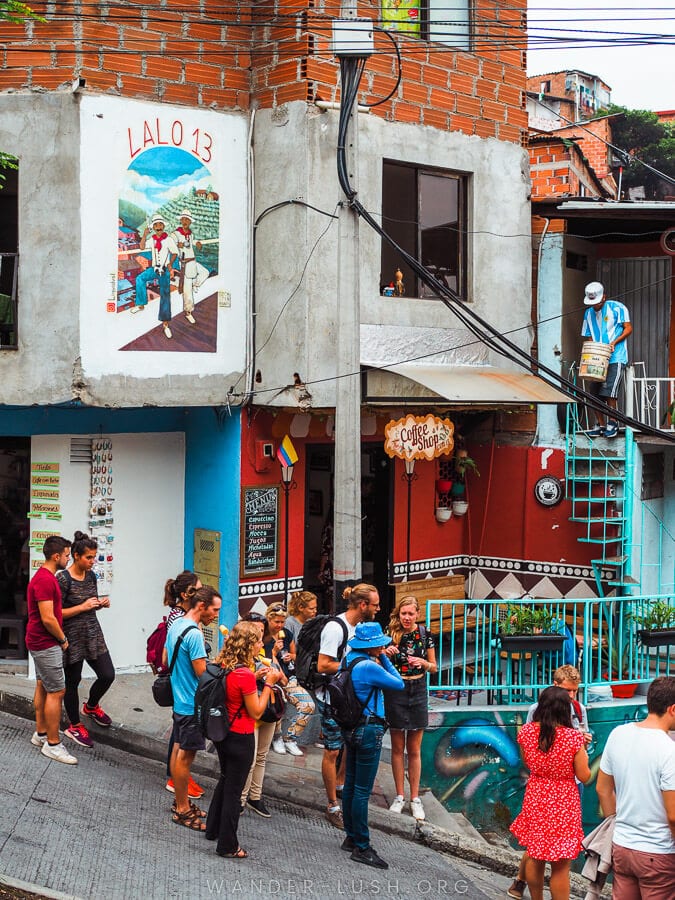
Comuna 13 is set on a steep hillside, so stairs are an unavoidable reality. Comfy, lightweight shoes are essential, as is plenty of drinking water, sunscreen, and a good hat or an umbrella . Just be glad you don’t have to carry your groceries or push a stroller!
The saving grace are the six interlacing outdoor escalators that replace 350 of the steepest stairs. Free to ride, they operate from the early morning until late at night and will always be running in the daylight hours when tours take place (including on Sundays and holidays).
Once you reach the top of the escalators, the terrain evens out a little. This is where you’ll find wide concrete pedestrianised areas (like the one in the first picture above) that feature seating and lighting.
4. It’s better to go with a local
There are dozens of companies in Medellin that offer tours of Comuna 13. As more and more people visit, the commercialisation of the community’s grief is becoming a serious issue. It’s something you should keep in mind when booking a Comuna 13 tour.
The most responsible and ethical option is to go with a local guide. Zippy Tour guides, for example, all grew up in Comuna 13 and know the streets (and the stories) well.
They incorporate personal anecdotes and authentic accounts without dramatising or romanticising things. And in our experience, they are truly grateful for the chance to show tourists around their barrios.
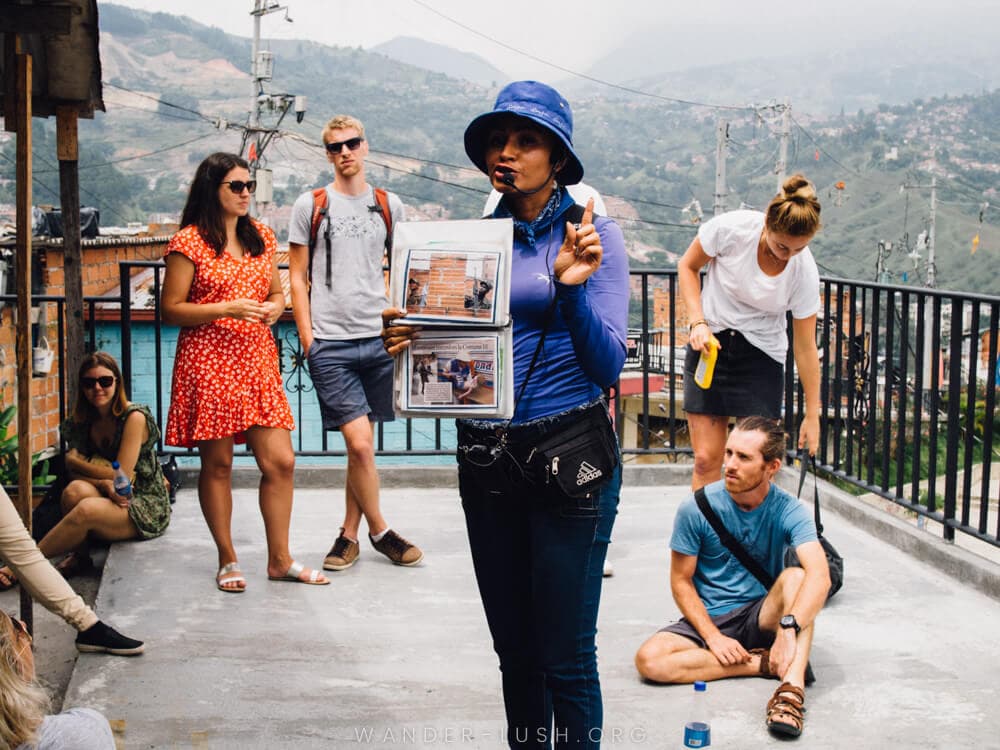
Our guide, Laura, taught herself English so that she could show visitors around the streets she grew up on.
The photo above was taken on the balcony of her family home – how many walking tours do you know of that make a stop at the guide’s house!? That’s just how generous and open the local guides can be.
5. It feels a lot safer than you might expect…
I can only speak to our experience, but we felt completely safe in Comuna 13 – both when we were with our guide and at the end of the day when we were walking back to the Metrocable alone.
Exercise common sense and caution as you would anywhere else. But don’t let fear or hearsay stop you from visiting Colombia or Comuna 13.
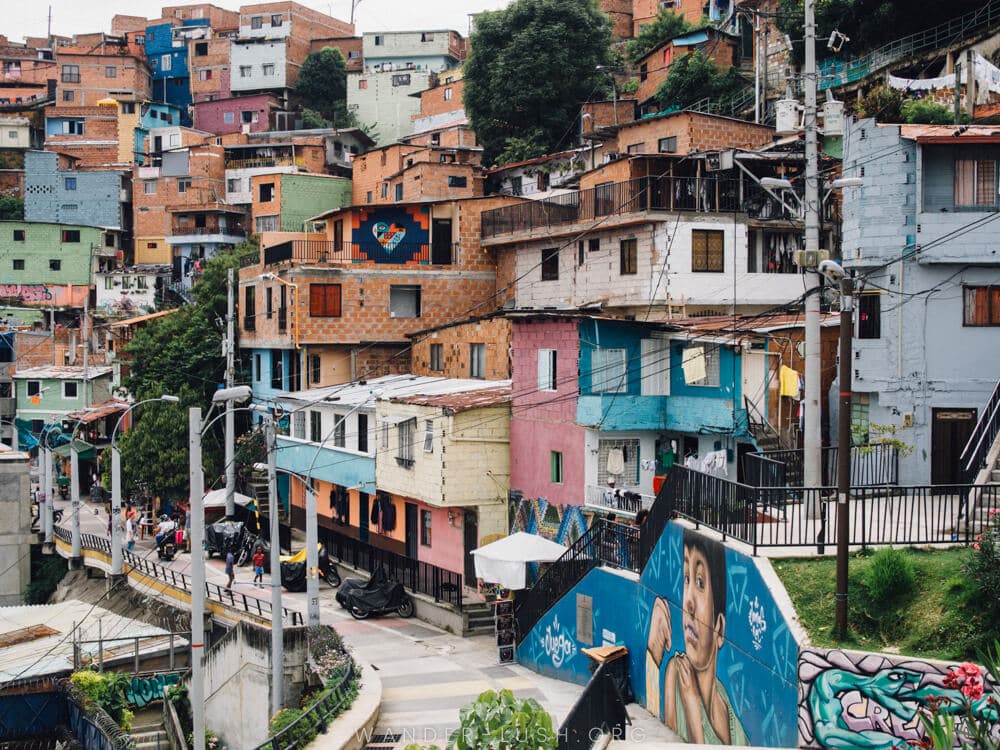
Remember that it’s easy to get lost, so stick close to your guide and don’t wander off track. At the end of the tour you may have the option to walk yourself back to the metro station, in which case your guide will provide directions.
If you prefer to stay with a guide at all times, choose a tour itinerary that includes transfers back to downtown, either by bus or Metrocable.
6. …But that doesn’t mean there’s no crime or violence
Comuna 13 has changed a lot, but poverty and violence are still big issues here. We were told that a few weeks before our visit, another tour group had to take cover from gunfire after fighting broke out between rival gangs.
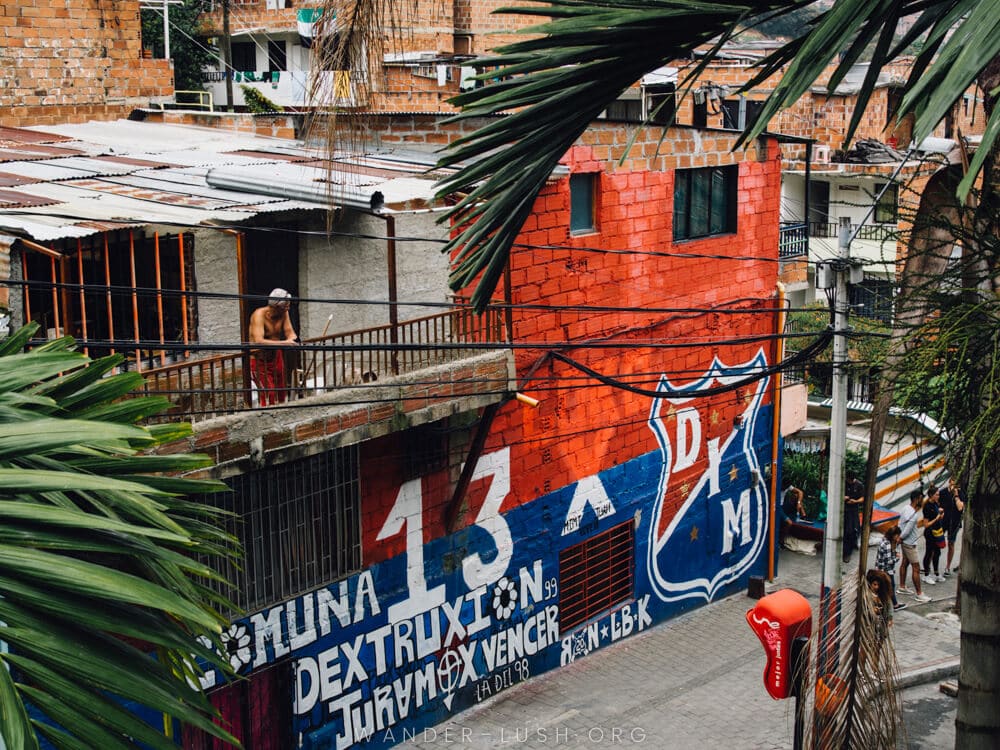
It’s perfectly safe to visit Comuna 13 during daylight hours. But just like the rest of Medellin, it’s not recommended to walk around after dark.
7. The locals are extremely welcoming
I get the feeling that foreign tourists are still a bit of a novelty in Comuna 13. We were warmly greeted everywhere we went in Medellin, but the smiles and buenoses we received in this part of the city were more animated and generous than anywhere else.
After our Comuna 13 tour ended at the top of the escalators, we decided to walk ourselves back to the metro instead of riding the bus with our guide.
It was interesting to see how people’s reactions toward us changed once we were no longer travelling with a group. It felt like people were even kinder to us than before.
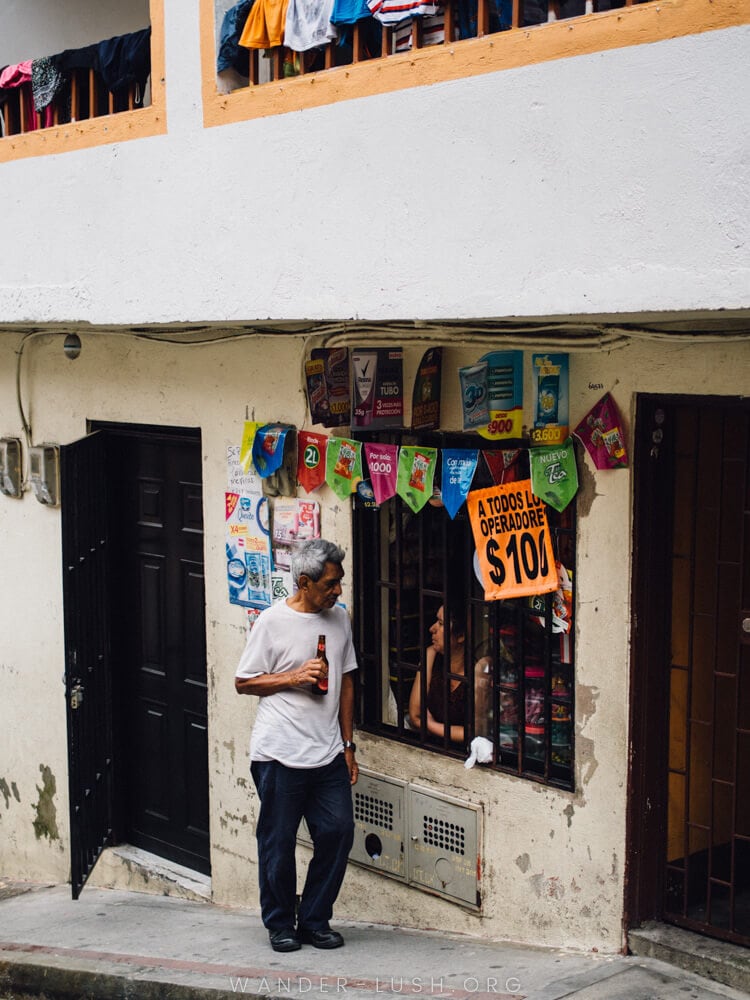
Like in any residential area, most people in Comuna 13 are just going about their daily business. Be respectful of people’s privacy (especially of accidentally trespassing) and use common courtesy when taking photos.
8. There are plenty of places to eat, drink and shop for souvenirs
We passed by dozens of restaurants, cafes, coffee shops and bars during our Comuna 13 tour. There is a large concentration of local eateries around the San Javier Metro Station, while plenty of ‘tourist-friendly’ venues (with English menus and clean bathrooms) have opened up around the street art zone. If you like ice cream, there are a few places that sell popsicles!
There are also several small galleries and market stalls dotted along the main pedestrian route where you can buy art prints and other souvenirs .
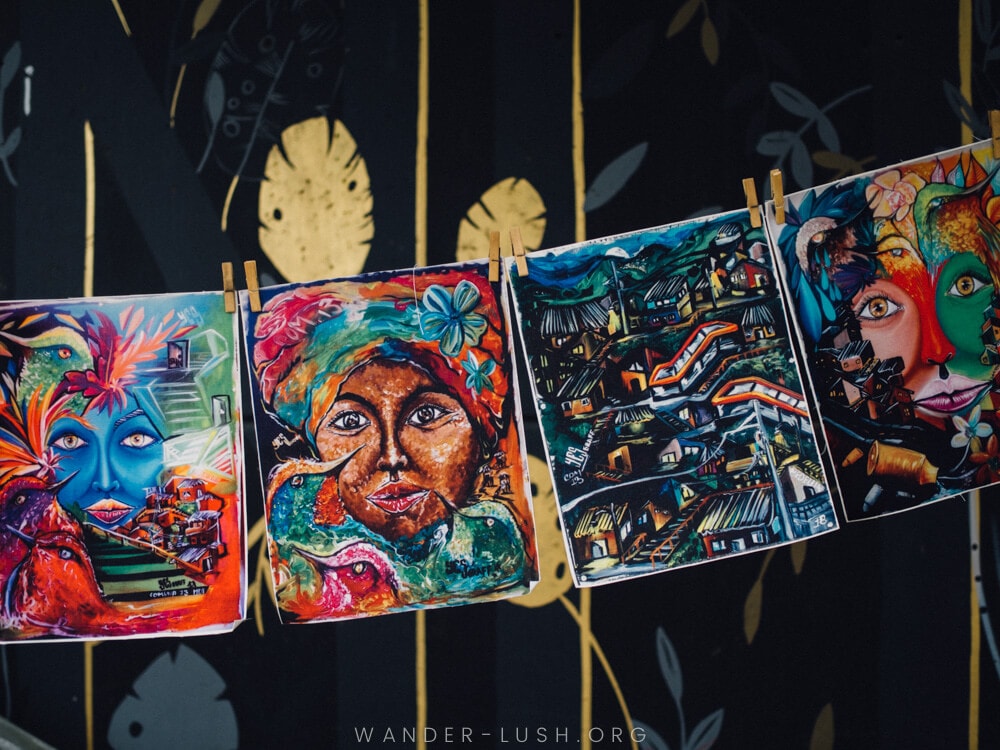
I expect that many more venues will open up as Comuna 13 continues to grow in popularity.
Note that most tours include a stop off at at least one cafe or restaurant.
Tip: Did you know that there is a district in Bogota that’s similar to Medellin’s Comuna 13? If you’re visiting Colombia’s capital, why not join a Social Transformation Tour of Barrio Egipto .
9. The street art in Comuna 13 is not just for decoration
You don’t need me to tell you that Comuna 13 is all about the street art. Not only does it look fantastic and form a perfect backdrop for tourist selfies (guilty as charged!), the murals are also symbolic.
There are dozens and dozens of large-scale works throughout the area, manly concentrated around the escalators. Any and every surface can be used as a canvas.
As our guide Laura explained to us, graffiti is actually illegal in Medellin. For a local artist to create a mural, they first need to obtain permission from the area’s chief artists as well as the owner of the building.
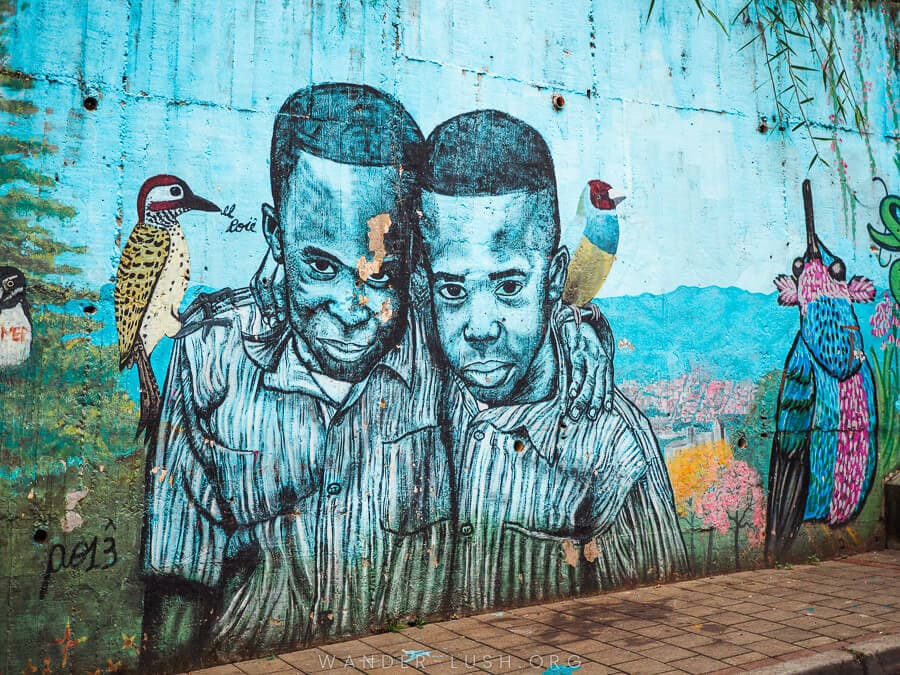
Murals in Comuna 13 definitely aren’t just for decoration: They also serve to memorialise the past and express hope for the future.
Your Comuna 13 tour guide will point out the best pieces. Special motifs to look out for include white cloths (a reference to May 2002, when a mother flew a white sheets from her rooftop as a request for ceasefire after two of her sons were injured by gunfire; anything in red, yellow and blue (the colours of the Colombian flag and a stand-in for national pride); and birds (another symbol for peace).
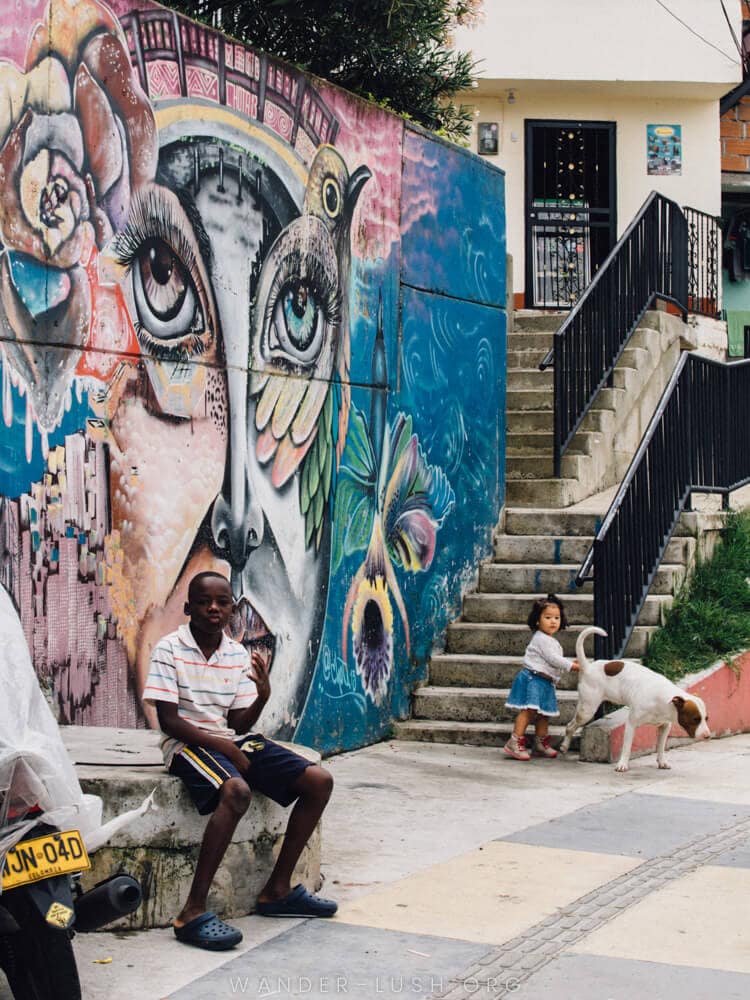
My favourite symbol in Comuna 13 is elephants, which represent the barrios’ pledge to never forget the events of the past.
Many families have painted their houses in bright colours to match the murals, making the whole area feel vibrant and uplifting.
10. There are other kinds of art to look out for, too
There are plenty of other art forms visitors should keep an eye out for, including performance art, music and breakdancing.
During our tour, we watched a short performance by Black and White, a local hip-hop crew.
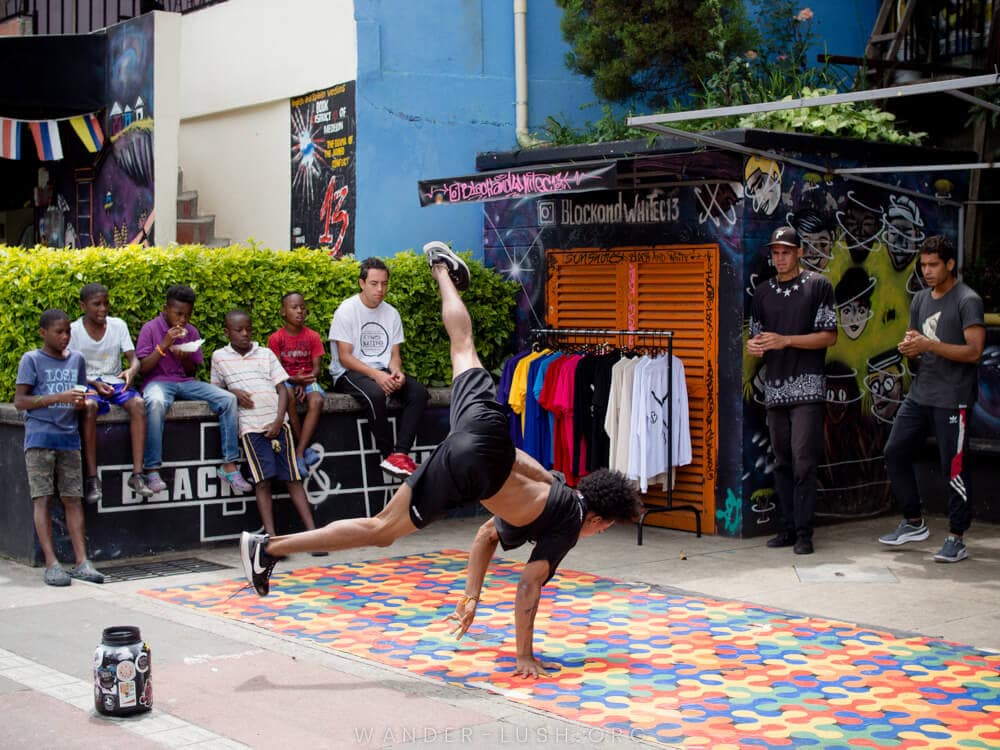
Another group you might encounter is C15 Collective, a coalition of young graffiti artists, music producers, rappers, photographers and DJs from Comuna 13.
They oversee up to 90% of the street art in the area and run a physical exhibition and performance space, Casa Kolacho , where people can come together to collaborate and develop new art forms.
All these different artistic formats – some organised by community leaders, some organic and self-managed – are designed to provide an alternative pathway for youth in Comuna 13.
11. You should visit Casa de la Memoria first
For a better understanding of Comuna 13’s art scene and how creatives grapple with sensitive and raw topics, I highly recommend visiting Medellin’s Museo Casa de la Memoria (Memory House Museum) near Parque Bicentenario first.
My main takeaway from the museum was that art is used to interpret and make sense of past events, which often means it’s quite abstract.
Our visit to the museum gave us a bit of background knowledge and prepared us for our Comuna 13 tour. Even if you decide against visiting Comuna 13, Museo Casa de la Memoria is a must-visit in Medellin .
12. Comuna 13 offers some of the best views of Medellin
It’s not exactly difficult to get a good view in hilly Medellin, but I was surprised by the vistas from Comuna 13. This area is high , and in my opinion offers the best outlook over the city.
From Comuna 13, you get an appreciation for the scale of the city. The viewpoint also allow you to look down over the colourful rooftops and beyond to the green hills that form the city’s western border.

The views get better with each escalator you ride or set of stairs you climb, so persevere! There are lookout points with handrails dotted all along the way where you can stop for photos.
13. By visiting, you’re helping a community rebuild
Every family in Comuna 13 has been negatively impacted by violence in some way. By taking a Comuna 13 tour, you’re not only supporting local guides and local businesses in financial terms, you’re also helping people shed the stigma.
It’s just one of the ways responsible tourism is contributing to social transformation in Colombia .
Our guide, Laura, was very honest in telling us that families from Comuna 13 were openly discriminated against in the past. Hence why many people didn’t want to admit they lived here.
That reputation is changing with every tourist group that visits, and now young people like Laura are proud, not ashamed, to call Comuna 13 home.

If you do decided to visit Comuna 13 and like us you have a positive experience, review your guide, spread the word back home, and encourage others to go, too.
I can guarantee you that your Comuna 13 experience will stay with you long after you’ve left Medellin.
How do you get to Comuna 13 from El Poblado?
Comuna 13 is located on the western side of Medellin, about 6 miles (10 km) northwest of El Poblado. The closest metro station is Estación San Javier , the final stop on the east-west metro Line B.
To get to San Javier from Poblado Metro Station, first take Line A (red line) in the direction of Niquia to Antonio Station (4 stops in total). Here, you’ll need to change to Line B and ride it all the way to the final station, San Javier.
From the station, you need to walk approximately 20-30 minutes uphill to reach the escalators and the heart of the street art zone.
Alternatively, you can take bus 225i the rest of the way (recommended). To find the bus, turn right after the metro station exit and look for the green bus stop at the traffic lights. The fare is 1500 COP payable with the same metro card (the transfer is free if you’ve just alighted the metro).
A taxi costs approximately 10,000 COP or a little less if you use an app such as Uber.
Most Comuna 13 group tours meet at the San Javier Metro Station so you don’t have to worry about finding the bus or making your own way up the hill – just rendezvous with your guide and they will show you the way.

What time should I go to Comuna 13?
The best time to visit Comuna 13 is in the morning. There are two reasons for this: Firstly, the area tends to get much more crowded in the afternoon ; and secondly, if it’s overcast, it can get foggier as the day progresses.
Because of the altitude (Medellin is 1,495 metres above sea level) and the unusual micro-climate, there is often poor visibility in the city. High humidity and low clouds can make the skies look grey and obscure your views.
Most tours of Comuna 13 start at either 9am or 10am. If you’re booking a private tour and you have the option to choose your start time, I recommend picking one of the earlier timeslots.
Is it safe to go to Comuna 13?
Yes, it is safe to visit Comuna 13 provided you use common sense. Take care of your valuables (as you would anywhere in Colombia), and if you have a backpack, consider wearing it on your front.
The biggest thing to remember when visiting Comuna 13 is not to wander off-track . The streets are a bit of a maze and it’s easy to get disorientated and accidentally walk onto someone’s private property. Stick to the main walkways.
An added element of safety comes from being with a tour group and having a local guide with you. This is another reason I highly recommend signing up for a tour rather than visiting independently.
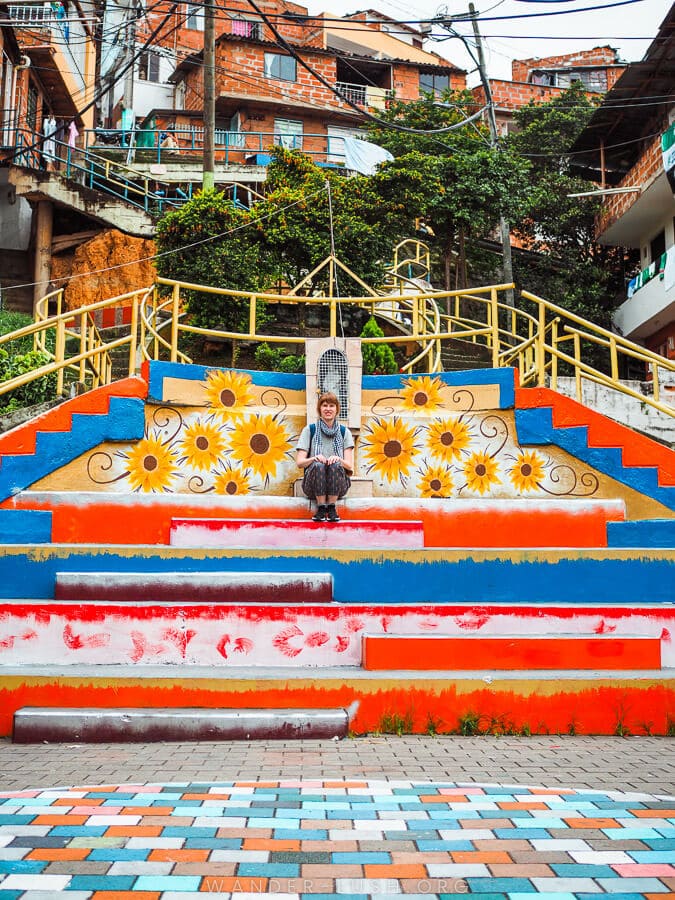
Is Comuna 13 accessible?
Comuna 13 is located on fairly difficult terrain, with lots of steep hills and streets pitched at precarious angles. As I mentioned earlier, there are a lot of stairs. Even with the escalators and cable system, it’s still fairly difficult to get around.
Not all parts of Comuna 13 are wheelchair friendly or suitable for anyone with mobility issues.
Accessible travellers can still visit the area – if that’s you, I highly recommend contacting one of the recommended tour companies below (and ideally booking a private tour) so they can plan a more appropriate route for you.
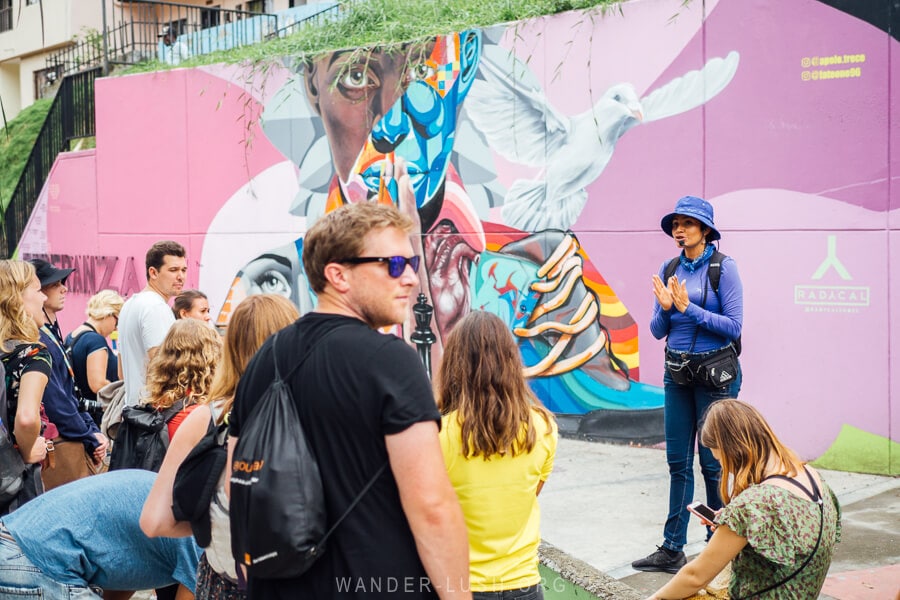
Can you go to Comuna 13 on your own?
It’s definitely possible to visit Comuna 13 independently and walk yourself around the neighbourhood. But there are several reasons why I don’t necessarily recommend it.
First and foremost, you will miss out on all the information and anecdotes you get from a guide . Meeting a local who has lived and breathed Comuna 13 for their entire life really is a huge privilege and you’ll learn so much more through this process.
Some of my best memories of visiting Medellin are of the chats we had with our guide, Laura, on the terrace of her family home. Sure, it’s possible to stop and talk to everyday people in the neighbourhood – but remember that English is not at all widely spoken, so unless you have fluent Spanish, it’s not really viable.
Secondly, as I already mentioned, it’s very easy to lose your way in the winding backstreets . If you want to go beyond the main pedestrianised roads, you’ll certainly need a guide to show you the way. Furthermore, Google Maps isn’t particularly reliable in this part of the city. While the area is generally safe, you definitely don’t want to accidentally wander into an area where you shouldn’t be.
There was one point during our tour that I almost got lost. I was taking a photo of a washing line (the one pictured just above) and when I looked up from my camera, my husband and the rest of the group had vanished. I panicked and froze, not knowing what to do. (Turns out they had gone down a nearby staircase – as soon as they popped up again on the next terrace over, I was able to rejoin them.) It was only 10 seconds or so, but it was not a good feeling to be disorientated and alone. This moment made me very grateful that I was with a guide who knew the area like the back of her hand.
An organised tour will give you peace of mind to enjoy your day fully – and I can guarantee you that you’ll come away with a much better understanding of the area and its history.
Top Comuna 13 tour companies
Comuna 13 Graffiti Tour: This company uses local guides and covers a lot of terrain over 4-plus hours of walking. The focus is firmly on the street art, making this a great tour for anyone whose primary interest is seeing he murals. The price includes metro tickets and snacks. Online bookings are available through GetYourGuide. Check prices and availability here .
Epic Tours Medellin: Another local company focused on Medellin city, Epic Tours offers a private tour of Comuna 13 with hotel transfers included. What I like about their tours is that they include other street art areas in downtown Medellin first, helping to put San Javier into context. Online bookings are available through GetYourGuide. Check prices and availability here .
Zippy Walking Tour: Free walking tours of Comuna 13 led by guides who grew up in the area. Tours are available in both Spanish and English and depart twice daily (see here for the schedule and to book). Remember to tip your guide at the end of the tour! The suggested tip is 25,000-30,000 COP per person.
Visit Medellin Tours: These popular tour programs combine Comuna 13 street art and views with a taste of local street food. Sample the best empanadas and mango ice cream during your walk around the neighbourhood – it doesn’t get more local than that. Check prices and availability here .
Lets Colombia: Steven, the freelance guide who showed us around Medellin’s fruit markets , also leads tours of Comuna 13 with his own company, Lets Colombia. Visit his Facebook page for more info.
Where to stay in Medellin
As you can probably gather from my photos of Comuna 13, Medellin is a pretty big city! It’s very spread-out, so you need to be strategic about where you base yourself. And just a heads up, you probably don’t want to stay in Comuna 13.
We spent 3 weeks in Medellin and stayed in the lovely Laureles neighbourhood. It’s leafy, it’s very walkable, there are hundreds of amazing restaurants and cafes – and it’s away from the busy downtown area, giving it a local feel. The northern part of Laureles is especially good because it’s close to the metro line.
If you prefer to be in the thick of it, El Poblado is the beating heart of Medellin. It can be a bit touristy, but on the flip side, that means lots of options for eating and drinking.
Budget hostel: The Wandering Paisa in Laureles is one of Colombia’s most-loved hostels. Choose from mixed dorms or budget-friendly private doubles.
Mid-range hotel: 574 Hotel is boutique on a budget near Lleras Park in El Poblado, with bright, tidy rooms and breakfast included.
Boutique hotel: Hotel Quinta Ladera has minimal, well-appointed rooms that will make you feel right at home in El Poblado.
High-end hotel: For an iconic Medellin experience, I highly recommend staying at Hotel Nutibara in El Centro. The 1940s Art Deco building is an architectural masterpiece.
Self-contained apartment: Factory Lofts has chic rooms with floor-to-ceiling windows and views over the beautiful Laureles neighbourhood. Choose a room with a full kitchenette if you want to cook at home.
Prefer Airbnb? Check out my round-up of Medellin’s best Airbnb rentals here .
Have you been on a Comuna 13 tour? What was your experience? If not, is it a place you think you’d be interested in visiting? I’d love to hear your thoughts!
Comuna 13 tour tips: Pin it & share it!

Colombia trip essentials
Here are some of the websites and services I recommend for planning a trip to Colombia. Remember to check out my full list of travel resources for more tips.
FLIGHTS: Find affordable flights to Colombia using the Skyscanner website .
VISAS: Use iVisa to check if you need a tourist visa or a Health Declaration form for Colombia and apply for your documents online.
TRAVEL INSURANCE: Insure your trip to Colombia with HeyMondo , my preferred provider for single-trip and annual travel insurance.
AIRPORT TRANSFERS: Book a safe and reliable private transfer from the airport to your hotel in Medellin , Bogota or Cartagena (prices start from $18 per group).
ESIM FOR COLOMBIA: Stay connected during your trip – pre-purchase an eSIM for Colombia and get online as soon as you arrive without having to visit a phone shop.
CAR HIRE: Use the Discover Cars website to compare prices and features across all the major car rental companies.
ACCOMMODATION: Find the best Colombia hotel deals on Booking.com .
CITY TOURS & DAY TRIPS: Browse the Viator website to find the best day trips, city tours, Colombian cooking experiences and more.
Further reading for Medellin & Colombia
- 30 best things to do in Medellin , my Medellin city guide
- 2 days in Medellin , the ideal itinerary for first-timers
- Top 3 markets in Medellin , Colombian fruit, flowers and more
- 30 best places to visit in Colombia , the ultimate bucket list
- What to do in Colombia , memorable experiences
- What to buy in Colombia , the best authentic souvenirs
- Guide to Jerico , Antioquia’s loveliest pueblo
- El Despertar Hotel , Jerico’s best accommodation
- Guide to Jardin , Colombia’s most colourful town
- Colombian coffee tour , bean to cup in Concordia
- 20 best things to do in Bogota , how to spend 1-2 days in the capital
- Colombian cooking class , in the kitchen in Bogota
36 Comments
It was so amazing on article you described about comuna13 medellin, can you provide me guide Laura information as you mentioned,may i check does she local tour guide ?
Hi Egene, thanks for your comment. Laura was our guide through Zippy Tours. Have a great time!
This article is right on the money. Our visit in July 2019 was great. We toured with Gate1 but hired a local gentleman for our Comuna13 tour. Best part of our 3 city trip. Felt safe and he was very informative. We follow himon FB and keep in touch and recommend him to people planning a trip to Medellin as he was recommended to us by our local guide in Cartegena! He was greatful for opportunity as he makes more money on the side doing tours than ge does as a civil engineer! It felt great we helped a local supplement their income.
Sounds like a wonderful experience, I’m glad you enjoyed your visit!
What an interesting discovery for me! Thanks.
Thanks for an interesting article on comuna 13. A friend of my visited this part of the world not all long ago. I’m unlikely to ever see this A lot of the photos seem to be take on the go and the documentary style suffers where the composition is all over the place. Do you take most of the pics yourself ? I wondered what phone/camera you take most of your pictures with?
Hi Pete, I use an Olympus OMD em10 Mark II. It’s lightweight and great for travel.
Thanks a lot, Emily! Loves this guide, we will take the Zippy Tour then, it sounded best! thanks for all the details, perfectly prepared now! We wanted to go on our own but it surely make sense to take the tour. Can’t wait to listen to the background stories. Few guys from our hostel joined a tour (not sure which one) yesterday, they said it was 5h long instead of 3. They loved it! Matt
Great to hear that, Matt! Enjoy the tour!
I just visited Comuna 13 today and it was an amazing and vibrant community. You are right about the welcome you feel when arriving. The artwork is stunning, the colors are beautiful and the feeling was safe and joyful. I would definitely recommend going there to experience it for yourself. Yes, the young guides (many of them, rappers and graffiti artists who work with the young kids to mentor them) are knowledgeable and do help navigate the streets. This is a great experience!
So glad to hear you enjoyed it, Beverly! I couldn’t agree me.
Thanks for your comment. Enjoy the rest of your time in Colombia!
Fantastic article! Really looking forward to going on this tour next month. Do you recall how long the tour took? Trying to determine if we can go the morning before our flight out (4pm). Thank you!!
Hi Erin! Good question. From memory the tour was around 2 hours. It’s possible to leave early if you need – a few people wandered off at different points because they had to be somewhere else.
I hope you get time to do it. Enjoy Medellin!
Hello, we booked the tour for the 1st of June, I wonder how much would be a appropriate tip?
Great to hear! And good question. It’s up to you, and it depends on the price and duration of the tour you chose. We tipped a little higher for the free tour since our guide was so fantastic and that’s the way the free tours work 🙂 From memory, I think we tipped the equivalent of around $10 each.
I hope you have a fantastic tour!
Visited this past week and this is a great walking tour. Referred to the best tour guide ever, Juan. Used him for our complete needs. Safe, reliable local.
I agree 100% with Emily’s experiences and advice.
Thanks so much for the feedback, Sebastian! Glad to hear you enjoyed your experience.
Safe travels.
I didn’t realize that Medellin is built on a hillside and thus will have very steep streets to climb. This makes me wonder if there are touring services that offer scooter rentals for those who would prefer a more relaxing tour of the city. In my mind, this would be the best way to see the country while still having the flexibility to visit local markets and tourist attractions.
What a thoughtful review of a tour. It sounds like an authentic and enriching experience. I always appreciate the opportunity to see a place with a local. I’ll put this on my list for Medellin!
Great tips for a visit to Comuna 13! I love how you balance our desire to explore and take photos with the need to be respectful and contribute to the communities we visit.
This guide has really inspired me to think about visiting Comuna 13. To hear that you can get guided around by a local who not only knows the streets in and out but can tell you real stories is so fascinating Obviously, a big concern as a solo female traveller is safety so it is really interesting to hear how safe you felt, someone you wouldn’t necessarily expect to do so.
Yes—great point! I think this tour would be an ideal option for solo travellers. Thanks for your comment, Rebecca!
In love with your post! My partner wants to visit Medellin and Colombia the last couple of years now, so this guide is perfect for our planning!
I love how thoughtful this entire piece is, its such a refreshingly holistic take from a traveler. I especially appreciate your emphasis on ethical travel choices and the perspective of the local community who lives in the village and would prefer to focus on hope for the future, rather than grief over the past. Really great writing.
Thanks for the kind words, Megan! It was a special experience.
Interesting. This definitely seems like a very educational experience and one that could showcase the ingenuity and artistry of local people. You mention that people seemed to see tourists as novelties, but do you think the tour was intrusive at all?
Great question. I didn’t feel like it was intrusive. The tour focused on public areas (parks, pedestrian zones), and being with a local guide was a great help—knowing where to go and where to avoid. I think if you ventured out to explore independently—as with any neighbourhood—it would be easy to venture into private spaces.
Psychologically and emotionally, I think our guide did a great job of balancing storytelling without naming names or intruding on anyone’s privacy. It’s always a tricky balance when a residential area opens up to tourism, but I genuinely felt like the community is very welcoming of visitors.
I oved the fact that you stressed on mindful travelling and respectfully exploring the place. Yes, people can be very sensitive about the past and we as tourists shouldn’t hurt those sentiments. Glad to see a dangerous community becoming safe again. Kudos to the efforts and planning. Thank you for sharing this journey. I really enjoyed reading it.
Thanks for your thoughts! I totally agree.
What a fascinating place! I love the idea of taking a tour with a local – they really know the place and you know that you’re having a positive impact on the locals. I had no idea that Medellin was so hilly. Those views. Between the art, history and views, I’ll definitely be looking up this tour when I finally make it to Colombia. Thanks for sharing!
So many hills = great views everywhere you go! Thanks, April!
What a fascinating area, I love the colourful street art – I would happily spend hours walking the streets watching and learning. Would love to visit Colombia.
Wow, the street art there looks incredible.
I love that you bring up what Comuna is NOT–a place for narco-tourism. It’s a real community on the upswing after experiencing a lot of strife.
Absolutely!
Fantastic tips for the future if i ever visit! Amazing how a place can change that much. It would worry me a bit after hearing what it was like but going with a local or tour group would put me at ease 🙂
Really helpful info, thanks for sharing!
Leave a Reply Cancel reply
Your email address will not be published. Required fields are marked *
- Subscribe to future posts

- DESTINATIONS
- EXPERIENCES

How Tourism Miraculously Transformed the Comuna 13 Neighborhood of Medellin
Once one of the most violent places in Medellin, Comuna 13 is now a bustling tourist destination home to colorful graffiti displays, exciting street performances and highly-rated walking tours. This hillside suburb is no longer riddled with gang wars, police raids, cartels and trafficking – rather, it attracts locals and foreigners alike who want to celebrate the social change that took place in just the short space of a decade. Indeed, entering the Comuna 13 area 10 years ago was unimaginable but today it has become a bucket-list experience for every traveler visiting the City of Eternal Spring.
Aside from being dangerous, Comuna 13 also lacked investment and infrastructure – making poverty inevitable. However, in recent years, cable cars and outdoor escalators were installed to open up the neighborhood. As soon as crime dropped after several military interventions, companies such as Comuna 13 Tours were eager to show tourists around. Although, at the beginning, people thought they were crazy to run tours in the community because they believed tourists would get killed. It was basically a ghost town in the early days, yet it transformed into a hub of culture.
The first guests that Comuna 13 Tours hosted were a young couple from the USA. Admittedly, the woman was apprehensive but soon relaxed when she was greeted with open arms by the residents. From this successful first trip, the tour operator has continued to go from strength to strength due to the increased safety levels in the neighborhood. A combination of government support and investment by mayors has boosted the economy of Comuna 13 to put it on the path towards prosperity. Of course, there is still plenty of work to do but the violent scars of the past are starting to heal.
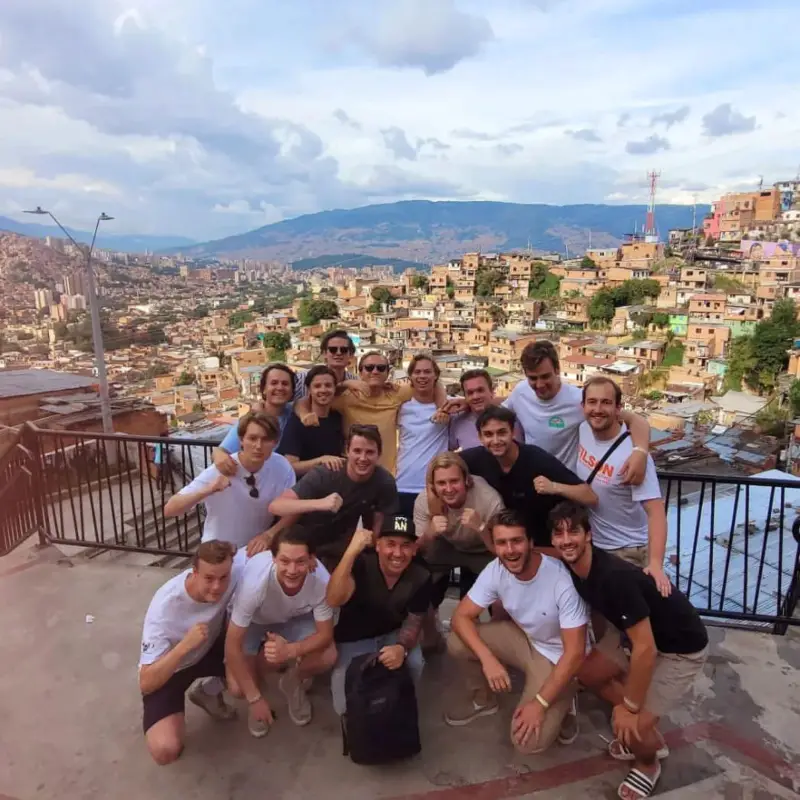
The Tumultuous History of Comuna 13
Before you book with Comuna 13 Tours, it’s important to read up on the history of the neighborhood as much as possible in order to gain context and background information. It helps to have a basic understanding of Comuna 13 so you can dive deeper into the historical details, and ask the right questions, while on the tour. The neighborhood began as an unplanned and illegal settlement back in the 1960s when thousands of families fled here after being displaced by various conflicts in Antioquia. A few decades later, the suburb started to attract cartels and gangs.
This was primarily due to Comuna 13’s location on the outskirts of the city, its clandestine streets and absence of police presence. Paramilitary groups, one pro-government and the other a Marxist guerrilla group called FARC, fought for control of the commune. The violence got so bad that no one dared visit, not even lifelong Medellin inhabitants. Eventually, something had to be done. So, in 2002, a newly elected Colombian president – Alvaro Uribe Velez – decided to act. He launched a series of intense military operations with the bloodiest one known as Operation Orion.
The government sent armed forces and many innocent people were killed in the crossfire. In the end, the gang wars stopped – not just in Comuna 13 but in most of Colombia – when a peace accord was signed in 2016 between the two parties. Other key dates were 2008 and 2011 when the metro station and outdoor escalators were built, which connected Comuna 13 with the rest of Medellin. Slowly but surely, the area got safer and kids went out into the streets to play again. Jobs appeared and artists showed admiration for locals by painting murals dedicated to their resilience.
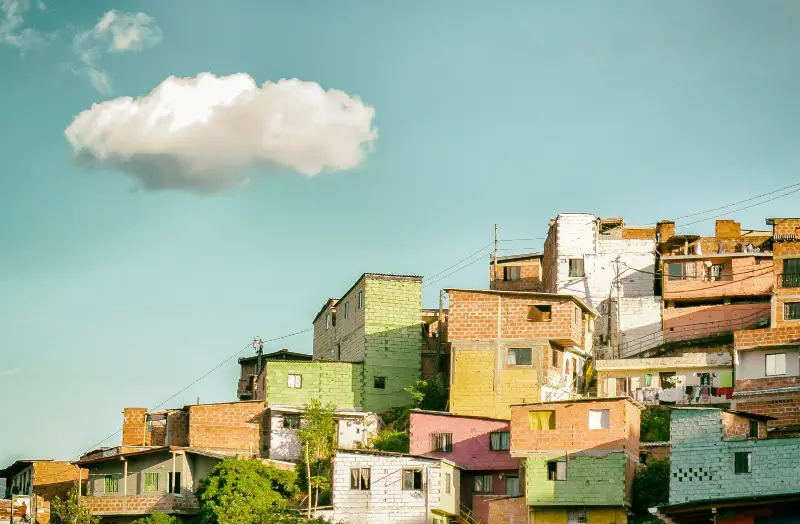
Best Things To Do in Comuna 13 Today
Taking a tour, whether it be private or small group, is the best way to immerse in the cultural charms of Comuna 13 because you will get shown the top spots in addition to learning about the unwavering strength of the inhabitants. Nevertheless, you still might want to go exploring on your own. If that is the case, there are some incredible things to do in Comuna 13 that will blow you away. For starters, the creative graffiti and street art murals are a must-see attraction. Talented artists, many of them locals, have done a wonderful job paying homage to the people of the barrio.
Secondly, you need to find the break dancers. Use the free electric stairs and wander the colorful streets until you find them. They will be happy to accept tips in exchange for a performance and photos. Another highlight of Comuna 13 is marveling at the beautiful views of Medellin and the surrounding landscapes. This activity can be ticked off your list at the barrio itself or by enjoying a cable car ride at the start or end of your visit (or both). The contrast between the metropolitan city of Medellin below and the hillside neighborhood is nothing short of spectacular.
Finally, no trip to Comuna 13 is complete without supporting the small local businesses. Buy their artisan products, such as organically grown coffee and unique pieces of art, to ensure the money you spend circulates there. The great thing about Comuna 13 is the locals never push their products or services on you, so you can shop without feeling pressured. Even the smallest purchase goes a long way to maintaining the responsible and sustainable tourism practices that the residents have come to champion. For those interested in a tour, we cover that option below.
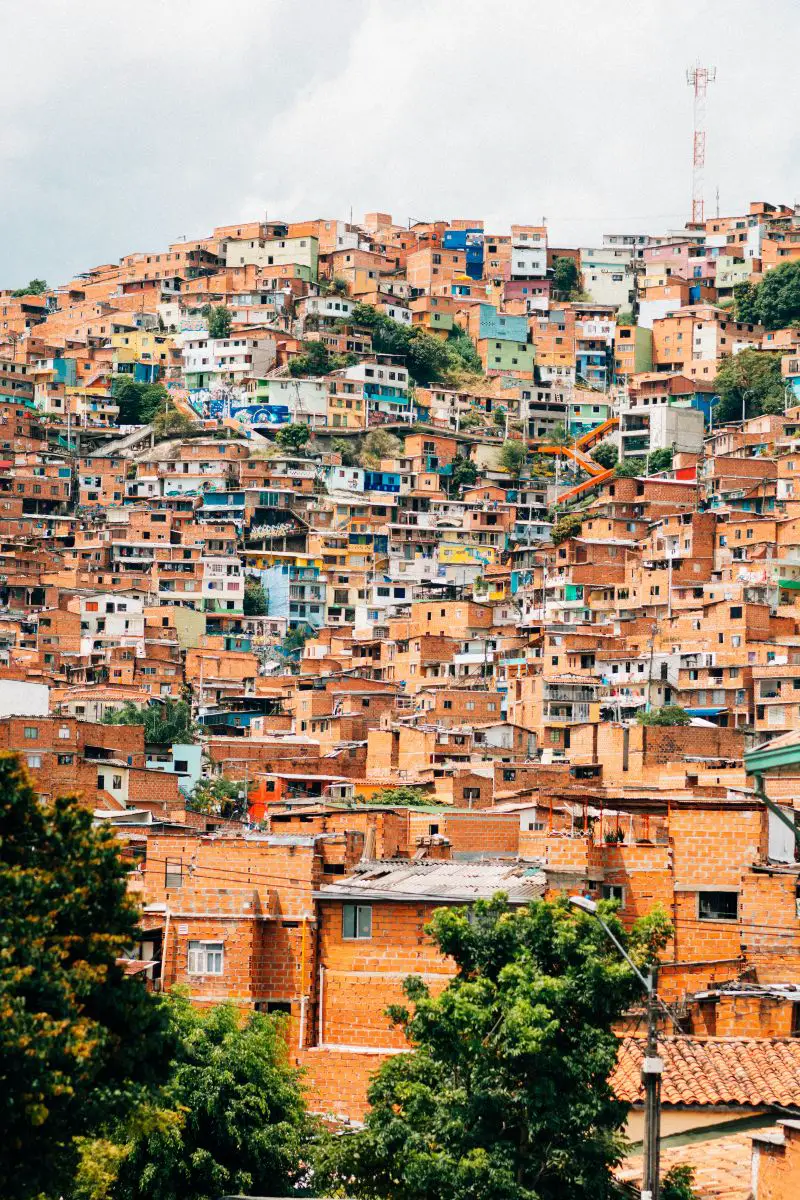
Why Book a Guided Tour in Comuna 13
Comuna 13 Tours is rated as one of the top five experiences in Medellin by Tripadvisor and it’s easy to see why. They help you absorb the turbulent history and miraculous transformation of the district on a thrilling four hour small group walking tour. It kicks off with a journey on the metro-cable car, before hiking up the steep hillside terrain of Comuna 13 where the outdoor escalators are located. You will be greeted with panoramic views throughout, be given the opportunity to converse with locals, take fantastic photos of all the colorful street art murals and hear some fascinating tales.
The tour guide provides you with a deep knowledge of Colombian history, tells you how Comuna 13 recovered from such a violent past and leads you from place to place via the most comfortable routes. None of the walking is too strenuous – every age and ability can participate. It’s a mix of education and fun, unlike anything else in Medellin. The group is encouraged to bring cash to pay for food, drinks and entertainment offered by the community. Although it’s not mandatory to purchase anything, a gesture of goodwill to the friendly folks of Comuna 13 is something you won’t regret.
Above all, Comuna 13 centers around people. It makes you think about the power of community, and how ordinary men and women have the ability to conquer adversity in just a few short years. While some of the stories are harrowing, what you come away with most is a sense of optimism about the future. The atmosphere of art, love and peace in Comuna 13 is contagious and it certainly leaves its mark on you. That is what traveling does best – at times it’s uncomfortable but it changes you for the better. Comuna 13, and the country of Colombia as a whole, will inspire you.
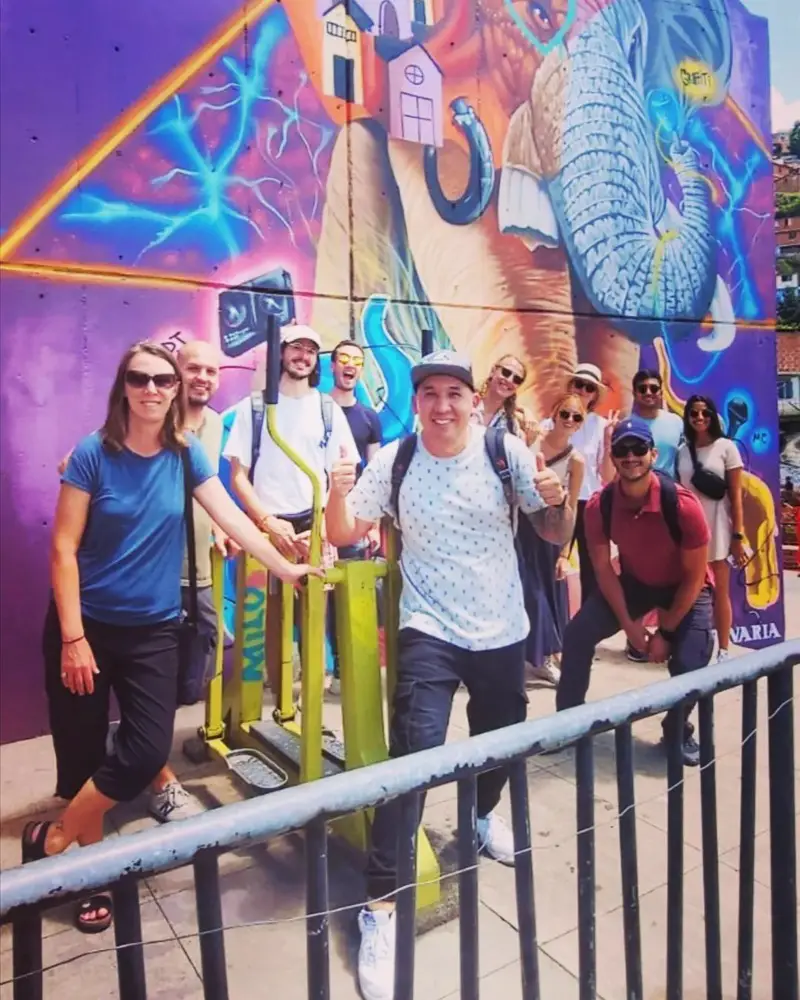
Author: Cameron Kennedy
Related posts.

Leave a Reply Cancel reply
Your email address will not be published. Required fields are marked *
Save my name, email, and website in this browser for the next time I comment.
Post comment
Travel experiences
Accommodation.

Beaches & Islands

Food & Drink
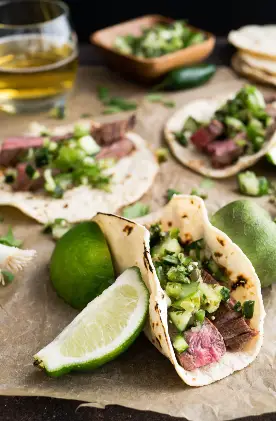
Historical Sites
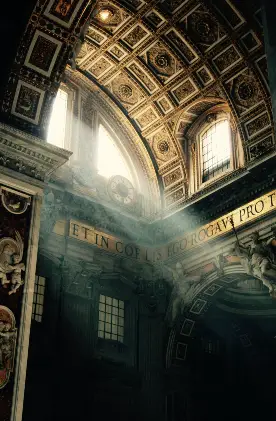
Living Abroad

National Parks
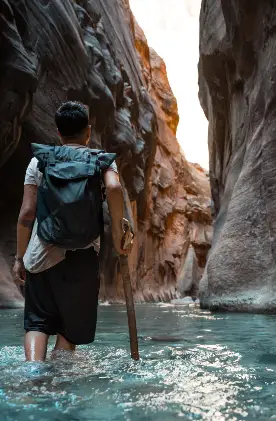
Towns & Villages
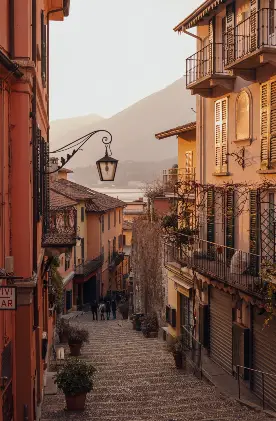
Travel Tips

Sign up to our newsletter

- Touristic Places
Comuna 13: tour, history and how to get there

- April 9, 2023 8:31 am
If someone had told me 20 years ago that Comuna 13 would become the most visited tourist attraction in Medellín, I would have told them crazy.
But today, this neighborhood, which before seemed like a forbidden site even for locals, is not only the most visited place by travelers who come to Medellín, but also one of the most transformative experiences that anyone could have anywhere in the world.
If you are thinking of visiting Comuna 13, I am going to explain what makes it so popular and everything you need to know so that you can get the most out of this mandatory tour in the Paisa capital.
¿Qué encuentras en este post?
What is Commune 13?
Comuna 13 is one of the 16 districts that exist in Medellín and is made up of 20 popular neighborhoods, most of them located in the mountains and with the typical “favela” appearance that is so common in Latin American cities.
This Comuna is also known as “San Javier” and is home to almost 200,000 inhabitants. Historically, Comuna 13 has not been a tourist site nor a crowded place for local visitors.
In fact, it is unlikely that those who live in Medellín have visited this place before attractions such as the Metrocable, the escalators and the “Gragffitour” appeared.
Why is Comuna 13 popular?

The main reason that Comuna 13 has received so much recognition is that it has become a world example of urban transformation. A magical place where you can connect with the life and history of humble people from Medellín who have found in art and culture a way to change the face of their neighborhood.
But this transformation didn’t happen overnight. One of the main sources of change was the construction of a Metrocable in 2008: a public transport line through aerial cabins that was created to make life easier for mountain dwellers.
Before the Metrocable, people who lived in Comuna 13 and had to go out to run errands or work in other parts of the city, had to undergo long walks or wait for hours for the arrival of a small bus that would take them to the metro.
When the Comuna 13 Metrocable appeared, a double effect was generated. Not only did the inhabitants of the sector found an easier and more flexible way to connect with the rest of the city, but it also created an effect of “intra-urban tourism” of other Medellinians who wanted to browse what at that time was a novel system of transportation for many.
But what ended up exposing the commune to Medellín and the world was the inauguration of a system of escalators, which replaced 350 steps in the 20 de Julio neighborhood.
This work, unique in the world, encouraged a cultural movement of graffiti artists, rappers and local merchants who ended up turning the place into what is now known as the “Graffitour de Comuna 13”.
How to get?
The 2 main ways to get to Comuna 13 are by Metro, Taxis or mobility applications. My favorite option is the Metro, since it will allow you to get to know the two key points of the Comuna: the Metrocable and the escalators (Grafittitour).
To get to the commune by metro you must take metro line B and arrive at the San Javier station. If you are located in the south of the city (El Poblado, Envigado, Sabaneta or Itagui) you must first take the metro on line A heading north and then transfer to line B at the San Antonio station.
If you are located in the western part of the city, sectors such as Laureles, Estadio, Floresta, you can go to the Estadio station and take the train towards “San Javier”, which is the last station on the line.
Once you arrive in San Javier, I advise you stay at the station, go to the second floor and take a tour on the MetroCable. You don’t have to pay an extra ticket.
A few months ago I did exactly this with some Brazilian friends, who were quite surprised by the ease of transportation in Medellín and how safe it was to take a metrocable ride through the popular communes.
The metrocable is a “circuit” so you will not have to get out of the cabin at any time and you can return to the original point where you took it (the San Javier station).
Once you are back in San Javier, you can leave the Metro station to go to the Electric Stairs, which are the starting point of the Graffititour. If you have previously booked a tour, it is most likely that the Metro station will be your meeting point and your guide will take you to the place.
But if you want to get there on your own, you can either take a taxi or take one of the green bus routes that are at the station exit. You just have to ask the bus if it goes through the escalators and kindly ask the driver to let you know once you get there.

A pice of advice here: If you don’t speak spanish is better for you to go with the help of tourist guides, since local people doesn’t have the ease to communicate with you.
Graffitour: the best plan in Comuna 13

The Graffitour is a tour between the 20 de Julio neighborhood and the Las Independencias 1 neighborhood of the commune, where you can appreciate more than 300 graffiti drawn by local artists, which tell the story of violence, displacement and rebirth of the neighborhood.
What I like the most about this tour is that it is a cultural immersion where you not only see beautiful works painted on a wall, but you can experience up close the daily life of the people who made it possible to transform the neighborhood.
The Graffitour is not about seeing painted walls and taking photos for your Instagram, but about going to listen to the history of the inhabitants of the commune, appreciating cultural expression through music and dance and tasting a little bit of the gastronomy of the neighborhood.
Speaking of food, two things that I love about this place are the “mango icecream” (made with green mango and a little salt) and mangochelas, some preparations of beer, salt, lemon, mango and from then on what you want to throw.
Although doing the graffiti tour is free and you don’t need to pay any entrance fee either to appreciate the graffiti or to enter the escalators, I recommend that at least the first time you go, you pay for a guided tour, which can cost between $40,000 Colombian pesos and $60,000 Colombian pesos per person (between $10 and $12 USD dollars).

These guided tours can last from 2 to 3 hours, and you can hire them at different points in the Comuna. The first point is at the San Javier Metro Station, where several tour guides will offer you the service once you leave the station. The other point is at the beginning of the route, just where the escalators start. For safety, I advise you to take the second option.
But if what you want is to ensure a place with trusted guides, I recommend that you make a reservation online. When I first did the tour, we did it with Parche Experiences , which has a more political and historical focus on what has happened in the neighborhood.

There is also the option to book with Casa Kolacho , which is a youth cultural group and which, in fact, are the original creators of the tour.
My last suggestion so you can enjoy the walk is that you do it early, ideally before noon. And if possible, avoid the weekends, as the place is quite crowded, to the point where it is difficult to walk. Oh and bring an umbrella, just in case!
Comuna 13 History
Comuna 13 began to take shape in the 1940s in a planned manner by the municipality of Medellín. The first buildings were in the lower part of the commune, in the area known as San Javier.
However, due to the Colombian armed conflict and the height of the industrialization of the city, in the 1950s informal settlements (known as invasions) began to take place, made up of people from different regions of the Colombian countryside who fled from the war.
Many of the houses built in the area were initially made of tins and wood and over the years there was an unstructured growth of the 20 neighborhoods formed from narrow streets and brick houses.
Along with population growth, Comuna 13 became an epicenter for the operation of guerrilla organizations that fought for territorial control of the area, the management of the extortion business, and drug trafficking. These groups were called “militias”; urban guerilla cells such as the Farc and the ELN.
For decades the population of the Comuna has been a victim of the struggle of these groups for territorial control. But without a doubt, the darkest period for its inhabitants was in 2002 when the Orion operation was carried out there.

This has been the largest military operation in the history of Colombian cities. And it was organized by the National Army and the government of then President Álvaro Uribe Vélez.
Orión was a bloody operation for Comuna 13, since in order to eradicate the guerrilla groups in the sector, the Colombian Army established alliances with paramilitary groups to carry out the operation. This left dozens of civilian deaths and hundreds of missing people as a result.
One of the images that portrayed the horror of this event was the photograph taken by photojournalist Jesús Abad Colorado. It shows a hooded man wearing rubber boots (paramilitary) giving instructions to the Colombian armed forces. Clear evidence of complicity between illegal groups and the official army.
If you are going to visit commune 13, the inhabitants of the sector will be able to share their personal experience during this operation that marked their lives. Listen to them with empathy and appreciate the value it has for a community to have revived from sordid moments and become a symbol of resilience from culture and roots.
Commune 13 and Pablo Escobar
Before you go let me demystify something. Pablo Escobar has nothing to do with the formation and growth of Comuna 13. He was not born, raised there, nor did he sponsor the formation of the neighborhood. Nor is it true that the epicenter of his hitmen was this neighborhood.
The guerrilla and paramilitary groups that have inhabited the area actually had historic confrontations with the leader of the Medellín cartel. When the paramilitary groups occupied control of this territory, Pablo Escobar had already been dead for almost 10 years.
During your visit you will find multiple hallucinatory shirts to this figure of terrorism and crime in Colombia. Although this is a method that many locals use to survive, taking advantage of the interest that the image of the “capo” arouses among foreigners, it is a symbol of terror, death and a lot of pain for Colombian society.
¡Hola, soy Jorge! Medellinense por obligación y convicción. He vivido en dos países y cuatro ciudades. He viajado por el mundo (Suramérica, Centroamérica, Norteamérica y Europa). Pero debo decirte algo, para mí no hay ninguna ciudad como Medellín.
Después de haber compartido con grandes anfitriones, me propuse algo: si alguien viene a “medallo” voy a asegurarme de contarle todo lo que debe saber para enamorarse de ella. Y aquí me tienes. 30 años viviendo en Medellín y unos 10 años viajando por aquí y por allí me han dado un poco de experiencia para poder compartirte y contarte lo que sé sobre mi ciudad.
Leave a comment Cancel reply
Save my name, email, and website in this browser for the next time I comment.
Enter the e-mail address associated with the account. We'll e-mail a link to reset your password.
- El Salvador
- Blog Archives
- A Graffiti Tour of Colombia
- The Colors of Oaxaca Mexico
- Photo Essay: Foreign Roads
- India in Ten Snaps: A Photo Essay
- Photography Portfolio
- About These Foreign Roads
- Get in Touch with Us

The Evolution of the Notorious Comuna 13 in Medellin
Mark Stewart December 5, 2021 Destinations 9 Comments
This post may contain affiliate links. We receive a small commission when you click them or make any purchases. It doesn’t cost you anything extra. We only ever recommend products and services that we stand behind. Read more in our Affiliate Disclosure
For years, Medellin was the most dangerous city in the world. Between Pablo Escobar and the drug cartels vying for control, and the military attempting to control them; to leftist revolutionary guerrillas and the privately funded right-wing paramilitary groups locked in conflict.
Car bombs, shootings, kidnappings and outright war were commonplace in the region. While the city itself stood amongst the most violent on earth, until as recently as 2010; one neighbourhood in particular ranked deadliest of all. The neighbourhood of San Javier, commonly referred to as Comuna 13, Medellin.
The History of Comuna 13
With thousands of villagers displaced due to violence in the countryside surrounding Medellin, the city saw a surge of new residents. Arriving with nothing, most of the new residents set up in small communities in the hills on the outskirts of town.
Illegal houses were built using whatever materials could be gathered. With no official infrastructure, houses were built on top of others while drainage and waste filtered through the streets.
Being unofficial and illegal, the government would regularly move in and tear the shambled buildings down. With no place else to go, the community would rebuild. This cycle went on for years, but with each rebuild, the community grew stronger until the government finally caved — only leading to new problems.
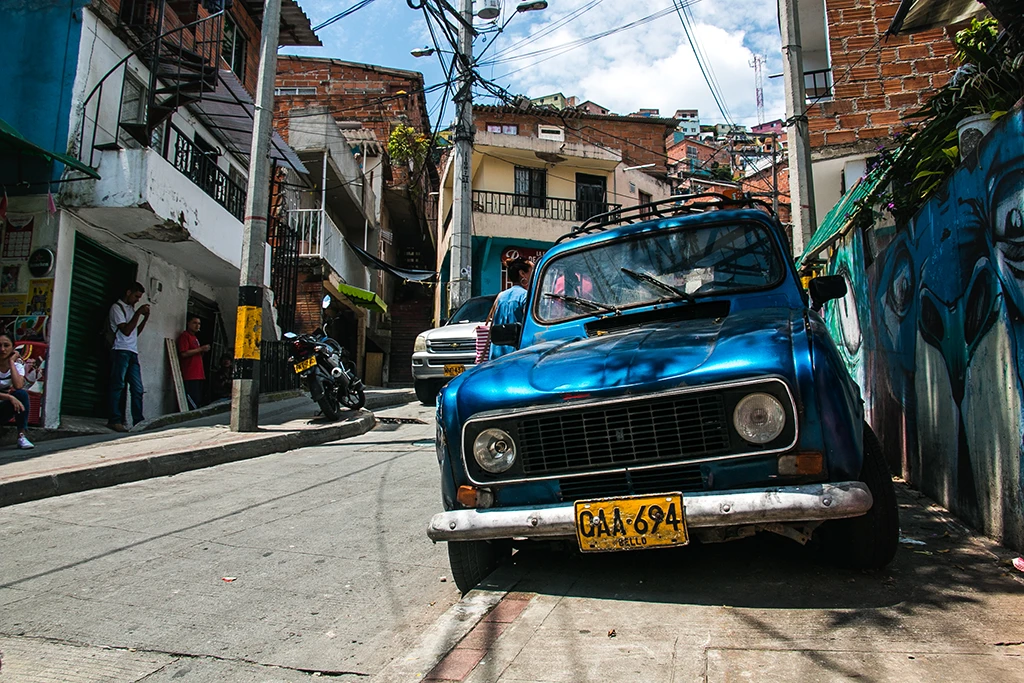
The community and buildings of Comuna 13 would be allowed to stay and minor utilities would be set up. However, as they did not pay taxes, the area was to be unrecognized by the police. Guerrilla groups from the countryside used this to their advantage. Acting as the unofficial law enforcement, these groups used the barrio as a front for arming a local militia.
The desperation of locals gave the guerrillas easy access to recruits.
Soon came extortion, more crime and a hotbed of criminal activity that could operate safely without official authority. In many ways, this continues through today.
The People of San Javier Had Enough
After decades of turmoil, calm began to spread throughout the country. A city once plagued with violence and terror began to see light. Following a horrific few days in 2002, when a military operation to remove the militias from the Comuna ended with mass civilian casualties, the residents had enough.
While the left-wing rebels had been evicted, the far-right paramilitary groups moved in. The worst had passed, but another decade would pass before anything could reach a relative normal.
The youth of the neighbourhood took action in their own ways. Rather than falling into the tempting world of gang life, many focused their energy in the form of art. Music and graffiti replaced the sounds of gunfire and cracked brick walls. Guns and violence were slowly replaced by spray cans and street performances.
While the youth rebelled, the gangs held their ground. The violence and killing continued.

A Revitalization of Comuna 13
The city itself poured money into Comuna 13 in hopes of revitalizing the former war zone. An additional metro-cable line was added from San Javier station to provide access to the northern hillsides surrounding the area. A few years later, modern, open-air escalators were built to help locals reach the city centre without climbing hundreds of stairs upon their return.
For the first time in history, residents of San Javier no longer felt alienated by the city they once couldn’t call home. Job opportunities within the city centre suddenly became a reality for thousands of residents, who until then, lived in poverty.
While these measures were by no means an overnight solution, the doors are now wide open.
Visiting Comuna 13 Today
Not only has the metro-cable and escalators provided access to the city from residents, but also a means of bringing visitors into the struggling community. Although the access existed, many locals still feared the journey.
As recently as 2010, the murder rate was over 160 in 100,000 people. To put that in perspective, the most dangerous city in the world in late 2021 is Tijuana, Mexico, with a rate of 138.
Things have vastly improved over the last decade. Though gangs still rule much of the area, a strong police presence holds things in relative calm. During our first visit on the famed graffiti tour of the Comuna, we felt completely safe, without a hint of worry.
Friendly locals and tourists alike walked the streets and enjoyed street food and cold beer while break-dancers performed. It quickly became one of our favourite spots to wander around the city.
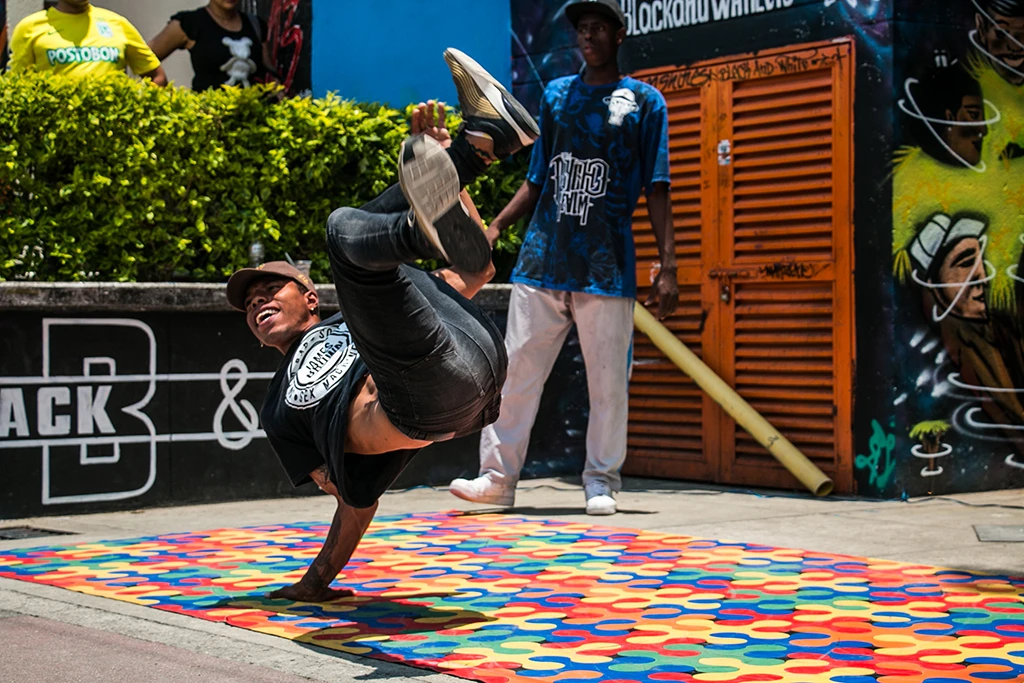
Heading to Colombia? Let us help you plan it out with our different Colombia Travel Itinerar ies!
San Javier is Safe, but not Perfect…
More recently, however, while a friend from home was visiting us during our 2018 visit, we took him to see this fantastic neighbourhood. The vibe was different nearly immediately upon leaving San Javier Metro station. Police presence was many times stronger than previous visits and local media was on site.
While enjoying some delicious artisan ice cream from Cremas Doña Alba as we climbed the escalators, the police were here en masse as well. Also, as a handful of tourists were out enjoying the stunning murals of street art, their numbers were a minuscule fraction of what we’d seen prior.
The breakdancers were practicing in a quiet corner rather than performing their lively act for the non-existent crowd.
This was all quite odd for a sunny Saturday afternoon in Medellín.
After several hours of enjoying the afternoon, we wound down over some cold beer from Cafe Aroma de Barrio . Overlooking the rooftops as the sun continued to set over the high hillsides, food carts packed up for the day. Sunny afternoons are great, but sticking around after dark isn’t a good idea in most parts of the city, let alone here.

Comuna 13: A Work in Progress
That evening while flipping through some local news, the signs of the day were quickly apparent. Just days earlier, a high-level gang leader and many of his followers were captured by the police. The resulting power vacuum sparked an increase in violence and murder in Comuna 13 over the past few days.
Although the atmosphere was noticeably different, our most recent visit caused no discomfort. The people still smiled from their open-for-business carts and cafes and nobody — even the police — mentioned anything to us. That being said, the recent activity led to the suspension of tours and city-wide warnings; for good reason.

During our 2020 visit, things in San Javier and Colombia as a whole are still in limbo. The ELN, the second-largest guerrilla group in the country held an armed strike for several days across Colombia, and some sources stated that Comuna 13 might be a target.
Thankfully, to the best of my knowledge, nothing serious happened during this strike. As for Comuna 13, the overall situation is still on edge. Murders increased in the early months of 2020, with four taking place in as many days in mid-February.
It’s worth noting that these attacks took place in the northern section of San Javier, far from the popular tourist area, so they shouldn’t dissuade you from visiting.
While the situation seems to have calmed, it’s a deep reminder that stability can change overnight, especially in a place such as this.
Take a Comuna 13 Tour
Comuna 13 continues to evolve. And the colourful hillside barrio is busier than ever. The once wide-open pedestrian walkway is now partitioned to help organize the increasing foot traffic. And many of the colourful walls are lined with open-air shops selling everything from art prints to clothing — some of which have nothing to do with Comuna 13.
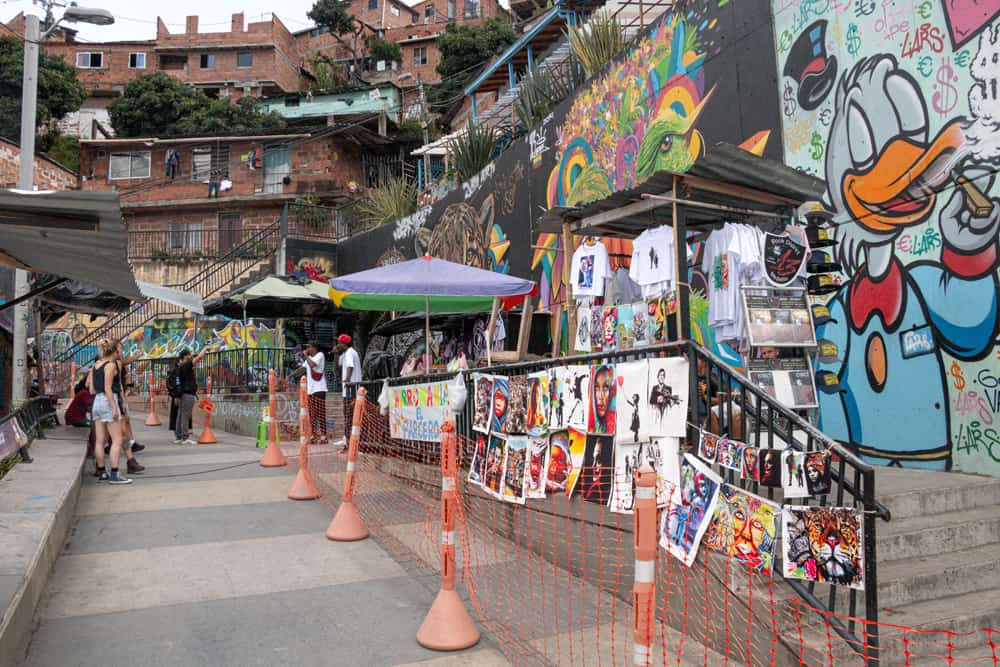
Regardless of the changes, it’s still a great place to visit and the area remains one of our favourite activities in Medellin. And while you can visit on your own, to get the full story, we always suggest taking a tour. During our first visit several years ago, there was only one main tour, the Free Graffiti Tour of Comuna 13 by Zippy Tours.
These days, there are dozens of tour operators, though few are official. With the rising popularity of Comuna 13, it seems anyone and everyone is trying to capitalize. If you arrive at the San Javier metro station, you’ll find many people fighting for your attention. Some wearing “Tour Guide” shirts, others in plain clothes.
We heard one story of a recent tragedy where one of these “guides” stabbed another while fighting for the attention of a group of tourists.
It’s for this reason that we still only recommend using the official tour through Zippy . They’re the original and have been running the tour for years. We’ve taken this tour and highly recommend it.
Explore, Appreciate the History, and Show your Support
Don’t let the negativity steer you away from visiting. Comuna 13 remains one of our favourite spots in Medellin and we always look forward to visiting.
Please support the locals, enjoy their artwork, purchase their products, eat from their carts and drink from their cafes. Just be sure to research the current situation before heading in.

More Colombia

Like It? Pin It!
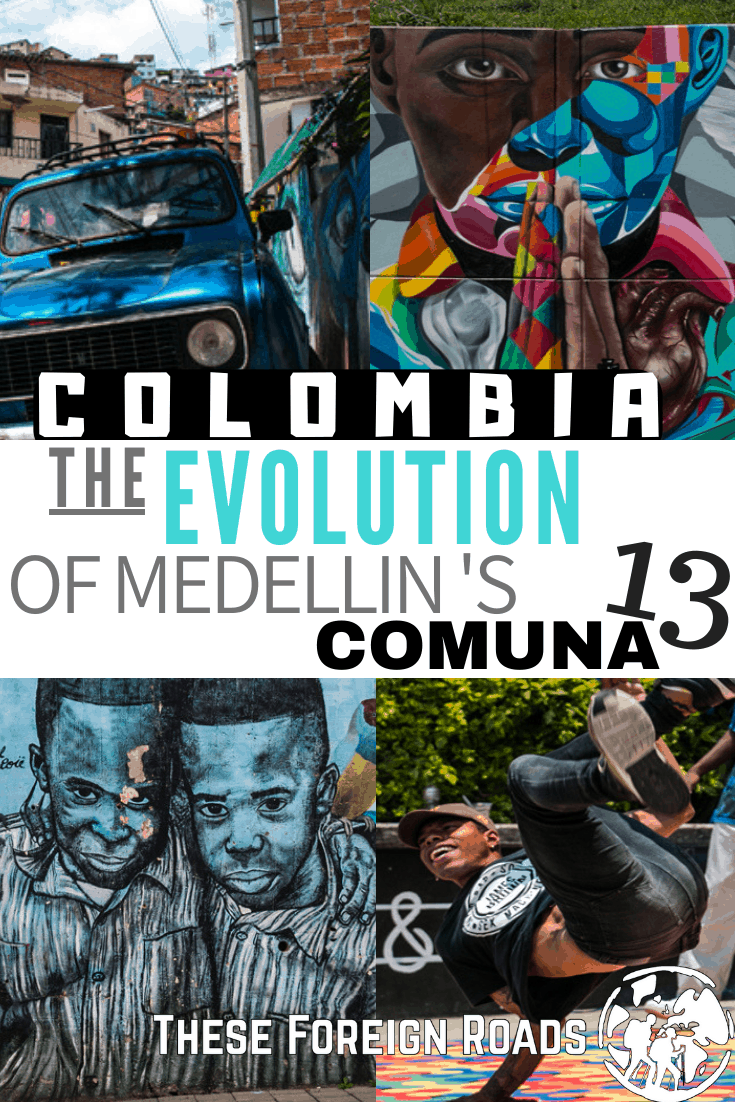
About the Author
Mark Stewart
Mark is a multi-passionate creative with a fascination for getting the most out of the human experience. While he isn't chasing adventures around the globe as a travel journalist and photographer, he works as a freelance writer, private chef and web developer.
WOW you guys are super adventurous to visit such perilous places, or you must of had a Herculean travel companion.
…Something like that 😉
We visited in mid March with young children and felt just as safe as anywhere else in Medellin. This was just a week before Colombia shut down due to COVID-19
This is a great article 😀 I went to Medellin years back but was doing a Dragoman tour during this part of the trip – I wish I hadn’t (for many reasons)!! I loved Colombia though (and Jim hasn’t been!) so there’s every hope I’ll return😀
Thank you so much! Did your tour visit Comuna 13 at all or was it a quick pass through Medellin? There are a lot of positives to taking a tour, but being rushed is one of the huge downsides. Hopefully you guys get a chance to visit soon, now is the perfect time to be visiting Medellin (and Colombia as a whole)!
Well we just visited Medellin and took our own tour (hiring a local tour guide who lives in Comuna 13) to see the beautiful Street Art as well as meet many of the local business owners and artists (yes, we met Chota one of the famous street artists, he is a wonderful ambassador for Comuna 13 and the street artists). When we visited (May, 2019) we felt completely safe and enjoyed the fresh made local ice cream and empanadas. The hip-hop artists were dancing in select areas and entertaining the visitors. The history of the comuna and the perseverance and attitude of the people is very exciting. The open air escalators are fantastic and a true help to the community. I hope to return to Medellin and Comuna 13 in the next couple years to see the growth and improvements the city will make. Best of luck to all of you in Comuna 13.
nice information, thanks buddy!!
Awesome post, Mark. We will definitely do the Communa 13 walking tour! And visit some of the other parts that you had suggested. Thanks!
Thanks you for reading! The best Comuna 13 tour is done by Zippy Tours is the original and the best. The guides are actually from that area, so make sure you do that one!
Leave a Reply Cancel reply
Your email address will not be published. Required fields are marked *
Privacy Overview

We have received your request correctly.
You will receive an email with a summary of your bookings.
Can't find it? Leave us your email and we'll send you a summary of your bookings.
Comuna 13 Free Tour
- 9.40 / 10 8,163 reviews | 93,260 travellers The activity was with Robin and we couldn't have asked for a better guide. His experience in the commune and the way he tells the whole story made us feel it. If you see this place without knowing its history, you don't appreciate it the same. 10 Rebeca Colinas
- X (Twitter)
Enjoy a fantastic free tour of Medellin's Comuna 13 , an area that has traded its past of criminality and danger for a future of diversity and positivity .
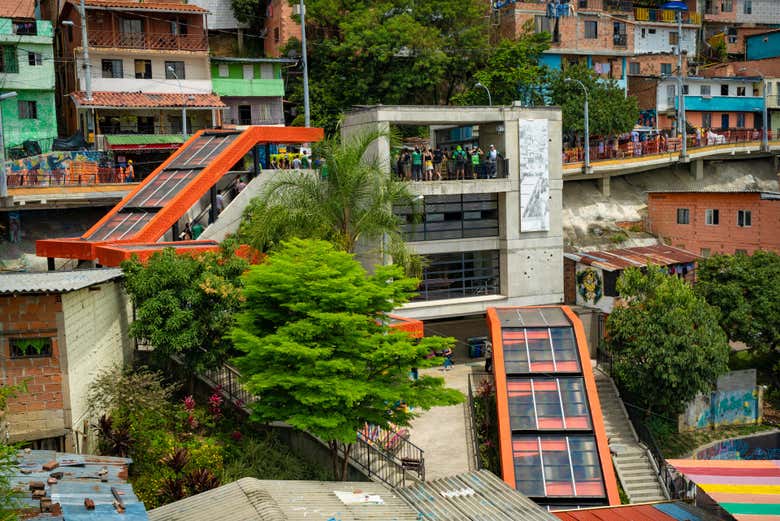
We'll meet up at the time of your choice at San Javier metro station . From here, we'll take the metro and the bus to Comuna 13 in Medellin , a fascinating hillside neighborhood full of color and life.
During the free tour of Comuna 13 , we'll talk about its dark past and how it was once the most dangerous area in the world . Due to its strategic location, Comuna 13 became the epicenter of violence and armed conflict in Medellin. While we contemplate its colorful graffiti, we'll talk about the different military operations that took place in the area, such as the famous Mariscal and Orion.
However, walking through its steep streets you'll feel totally comfortable and safe. This is due to the incredible transformation of Comuna 13 in the last decades. Thanks to the street art and its colorful murals , the locals have managed to turn it into an attractive place for visitors without forgetting its past.
After 2.5 hours, we'll say goodbye and end the free tour of Comuna 13 back in the center of Medellin.
More Information
2 hours 30 minutes.
The activity takes place with a guide that speaks in English.
English–speaking guide
Not included
Bus ticket: 2,000 COP ( US$ 0.50) per person
When to book?
You can book up until 45 minutes before the activity as long as there are still places. Book now to guarantee your spot.
Type of voucher
Electronic. Show the voucher on your phone.
Accessibility
Wheelchair accessible. This must be indicated in the reservation. An accompanying person is required.
Sustainability
All services published on Civitatis are carried out in accordance with our Sustainability Code .
Our providers commit to:
- Provide a safe and satisfying experience.
- Reduce, reuse, recycle.
- Incorporate eco-conscious technologies.
- Uphold fair employment standards.
- Foster the growth of local communities.
- Preserve the integrity of local culture.
- Safeguard both cultural and environmental heritage.
- Ensure ethical treatment of animals.
- Operate with honesty and transparency.
- Encourage sustainable behaviors among customers and staff.
This particular activity contributes as follows:
- No printing of documentation required.
World Lion Tour Show more
Corporate name: Leandro Román Gomez
Not permitted.
Frequently asked questions
Q - Why do this activity with Civitatis?
A - At Civitatis we guarantee the best quality and prices, click here if you want to know how we select our activities .
Q - How to book?
A - To reserve the activity, choose the date and complete the form on this page. You will receive your confirmation immediately.
If you have any other questions please contact us.
Free cancellation
Meeting point.
San Javier Metro Station
You may also be interested in
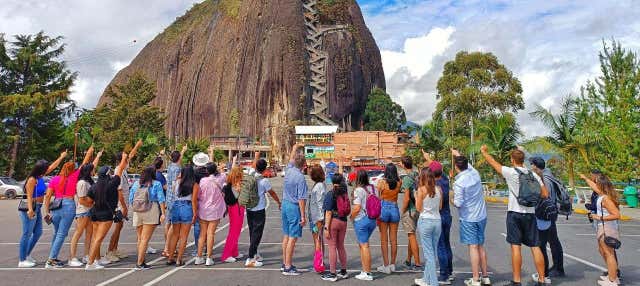
Tour of Guatapé + Boat Ride
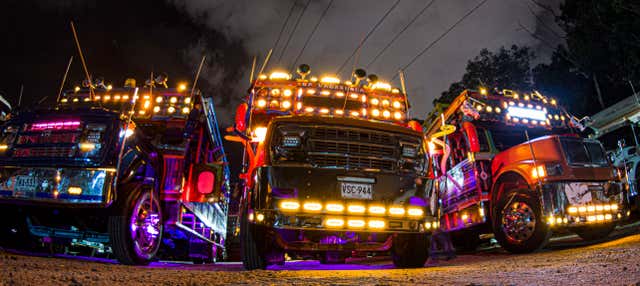
Chiva Rumbera Night Tour + Street Food Tasting
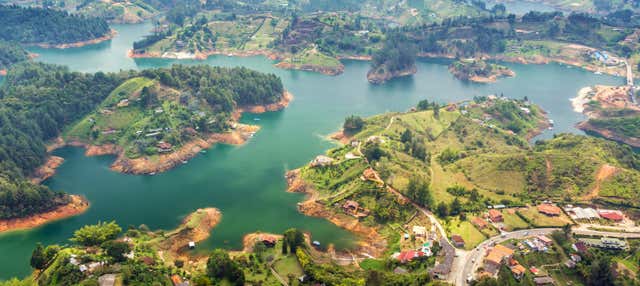
Guatapé Day Trip
Login to add activities to your favorites and access them from any device
This site is reCAPTCHA protected and Google's privacy policy and terms of service apply.
Basic information regarding personal data protection
Person responsible for the processing: CIVITATIS TOURS, S.L. (CIVITATIS). Purpose: Provision of the services requested; Sending commercial communications about CIVITATIS products and services, for which commercial profiles of our customers may be drawn up; Sending surveys in order to assess the services offered and their degree of satisfaction, as well as the publication of opinions about the service received; Compliance with accounting, legal, fiscal and administrative obligations; Publication of customer images and processing of data for statistical purposes. Rights: You have the right to access, rectify and delete data, to limit its processing, to oppose its processing and to its portability. Additional Information: You can consult additional information on Data Protection in the General Terms and Conditions .
Log in to rate the opinions of other travelers

Colombia's "Eternal Spring", Medellín, is a colourful city, with works by Fernando Botero everywhere. However, the true colour of Medellín can be discovered in Comuna 13, the former "Cradle of Pablo Escobar", a neighbourhood that has now become a tourist attraction in the city and where you can delight in its countless examples of Urban Art, such as its Graffity murals. Comuna 13 was the epicentre of drug violence during the worst years of the social conflict. A shantytown built on the slopes of the mountain, with small houses similar to the Brazilian favelas, steps, narrow streets and lookouts to control when the forces of law and order entered the commune. After these hard years, thanks to the impulse of the Government with different programmes of social inclusion, and, above all, thanks to the community formed by its 12,000 neighbours, Comuna 13 has undergone an unprecedented transformation, being today a quiet and safe neighbourhood, touristy, that receives thousands of visitors every year, to discover its extensive sample of Urban Art, buy souvenirs in its shops or enjoy the good atmosphere that is breathed in its cafes and restaurants. To get to Comuna 13 from the centre of Medellín you can use the metrocable, a funicular that connects the centre with the upper neighbourhoods. It is also possible to get there using the metro, for which you have to travel on line B, the orange one, and get off at the last stop, San Javier. One of the distinctive architectural features of Comuna 13 are its free escalators, which replace the old 350 steps and have contributed significantly to the opening up of the commune and its transformation. You can use these escalators from the metro to get to Comuna 13. Once in the neighbourhood you can walk through its streets, an explosion of colours thanks to the Urban Art created by the young resident artists, who have been graffitiing the walls of the poor houses in the neighbourhood and creating large murals and works of art. Among the urban artists with works in Comuna 13 are @chota_13 and @yesgraff. Walking through the narrow streets of Comuna 13 discovering large murals and colourful spaces at every step, enjoying its atmosphere and safety, is one of the tourist experiences you can't miss if you travel to Medellín.
Continue your adventure after the Free Walking Tour of Comuna 13 in Medellín
Find other experiences near the walking tour of comuna 13 in medellín.
- Free walking tour in Dublin
- Free walking tour in Edinburgh
- Free walking tour in London
- Free walking tour in San José
- Free walking tour in Granada
- Free walking tour in Antigua Guatemala
- Free walking tour in Havana
- Free walking tour in Lima
- Free walking tour in Miami
- Free walking tour in Cali
- Free walking tour in Quito
- Free walking tour in San Juan
Discover more options in Medellín after the Free Walking Tour of Comuna 13
- Destinations
- Tours in Medellin
Free Tour of Comuna 13
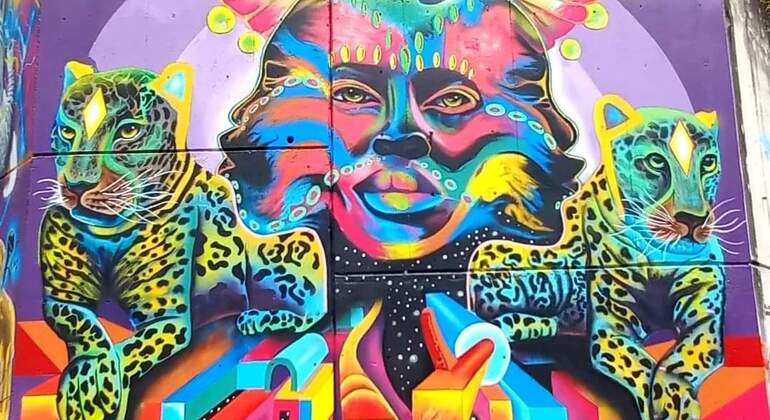
Overview of the tour in Medellin
Hello, my name is Estefania, I am an inhabitant and local guide of the city of Medellin, I have my national tourism registration #130234, and for me it will be a pleasure to show you the change that my neighborhood has had during these last years. We start talking about the invasions (its first beginnings), the armed groups, the public forces, the military operations, the gangs, the invisible borders and finally the transformation. You will be able to witness how a whole community decided to unite and make their neighborhood resilient, changing the weapons for graffiti, dances, shows, entrepreneurship and a lot of desire to move forward. The alleys that we walk through, many of them with stories and people that will make you feel as if you were at home, bringing a smile to each of our visitors and I assure you that you will not want to leave the place, the best viewpoints where you can take the best pictures and videos, appreciating the city and its surroundings. I will be waiting for you and together we will live an unforgettable experience, that you go to your city and infect everyone to want to know this place and show that you can change the stigma of a city.
This activity includes:
- Historia contada por habitante de la zona
- Significado de los murales
- Show de baile
- Show de improvisación
- Galería de artistas locales
- Actividad deja tu huella realizando tu propio grafiti
- No te puedes ir sin probar el helado mas famoso de la comuna (corre por tu cuenta)
- Escaleras eléctricas
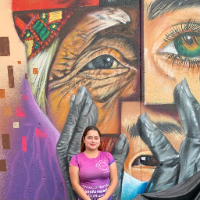
Meeting point
Barrio plan del che
If you come by subway, you will arrive at the San Antonio station and there you transfer to the San Javier station (the transfer has no additional cost). When you arrive at the San Javier station you look for the green public transport (number 221 that says plan del che) the transport has a value of $2.500 Colombian pesos per person or if you have the metro civic card recharged you can use it and I will be waiting for you at the last stop that the transport makes (the driver lets you know when you have arrived), if you arrive by car we will send you the exact location to whatsapp.
Things to note
-Carry your identity documents with you at all times -Comfortable clothes -Comfortable shoes -Sunscreen -You can bring cameras, drones, etc. -There will be a maximum wait time of 10 to 15 minutes if the tour does not start. -Umbrella depending on the day. -We accept dollars, euros and credit cards. -We ask that when making the reservation you leave a number to which the guide can communicate and be in contact in case of any situation. If you can not attend please cancel the reservation, the tour capacity is limited.
Free Cancellation
You are free to cancel a booking anytime. We kindly remind you to cancel bookings you cannot arrive for. Being reported as absent decreases your customer level points and the benefits you can enjoy.
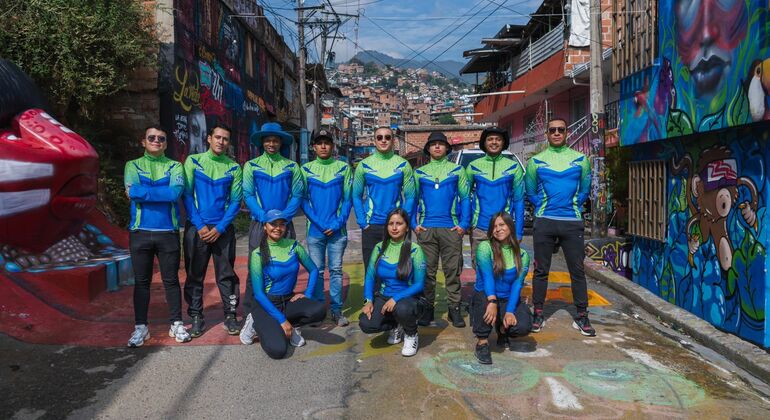
More tours near Medellin
- Join Freetour
- Provider Sign In
- Affiliate Program
- Security & Privacy
- Terms & Legal
- Cookie policy
- Freetour Awards
- Ratings & Reviews powered by

IMAGES
VIDEO
COMMENTS
The Escalators are about progress in the form of social equity and accessibility for all citizens. electric stairs in comuna 13. Apparently though, instead of locals doing what was the equivalent of a 28 story building climb daily to get the nearest metro stop. The Escalators cut this to around a 6 minutes leg break.
How to Visit Comuna 13 in Medellin. 1. 'Free' Walking Tour of Comuna 13 in Medellin. The best way to visit Comuna 13 is to take a 'free' walking tour. We went with Zippy Tours, which is run by local guides who have always lived in Comuna 13. The guides are fantastic at conveying the history of this part of Medellin.
How to get to Comuna 13 without a tour. If you wish to visit Comuna 13 independently, then it is easy to do so. You'll find Comuna 13 in the west of Medellin, around 6 miles (10 kilometres) from Poblado, but despite the distance its really easy to get there on Medellin's metro system. The closest Medellin metro station is San Javier.
Yes, you can visit Comuna 13 without joining a tour. Many travelers choose to explore the area independently to experience the vibrant street art, outdoor escalators, and local culture at their own pace. While I don't go on tours most of the time because I like to explore at my own pace as a slow traveler, visiting Comuna 13 is another story.
I explore the famous Comuna 13 without a tour guide. Good decision or will I regret it?Part I: https://youtu.be/x8pjPdKhYj4#Colombia #Medellin #Youtube #Yout...
A tour guide in Comuna 13 talks to a group of tourists in Medellin, Colombia Comuna 13 Graffiti Tour and Street Food. Graffiti art and street food are two of the main attractions in Comuna 13, and this tour combines them both. You'll visit the 20 de Julio neighborhood, which is the most graffitied barrio in the district, and learn all about the history and significance of the murals that you ...
How to Get to Comuna 13 Without A Tour. Again, I highly recommend taking the walking tour or graffiti tour. Learning the stories behind the art and the history of the community from a local makes this a much more memorable experience. However, if you want to explore Comuna 13 on your own, there are a few ways to get there. ...
The Medellín Cartel took over Comuna 13 and ruled it during the 1980's-1990's. This was due to the location of Comuna 13: it was seen as a favourable position for the cartel as it is located just off the San Juan Highway, on a steep hill just west side of the city. Therefore it was the ideal route for the cartel to transport guns, drugs ...
Your guide will be a local to Comuna 13 and our guide George was an absolute legend! The tour lasts about three hours and walks you through five different neighbourhoods of San Javier. At the end of the tour we were free to explore Comuna 13 independently. Our Zippy Tour guide, George, was a Comuna 13 local and legend.
Graffiti Tour at Comuna 13 | Check Prices* But that is the compromise you have to make. We can definitely recommend doing the tour to Comuna 13 alone and without a tour. In some blogs you read that you should rather not go too far from the escalators alone. We can not confirm that either. Maybe it was different a few years ago, but nowadays ...
When you arrive to comuna 13 many guides are waiting for someone who wants a tour, if you don't find nobody you can go by yourself it's a pretty safe area during the day. 😃. Maybe someone from CouchSurfing will want to go with you. Nah I went twice a few months ago with no guide. Its a pretty safe area during the day.
Every day, dozens of energetic, bilingual paisa tour guides stand beneath vibrant red and blue umbrellas outside the San Javier Metro Station, each collecting a small group of travellers with whom to walk through Comuna 13, share stories of Medellín's darkest days, and showcase the incredible transformation this city has undergone in just a few […]
The free Comuna 13 walking tours are the best all-around value option, as the guides work on a tip-based model to get paid. 25,000 COP is the recommended tip amount. But it's optional and you can tip what you think it was worth or what you can afford. The tours typically last around 2.5 hours and end in Comuna 13.
Prices start from $37.\. Option 3: Full-day city tour with cablecar and Comuna 13 walking tour - Longer walking tour (5+ hours) that shows you the best of Medellin downtown as well as Comuna 13. If you only have a day in Medellin, this is a great option. Prices start from $46.
I explore the famous Comuna 13 without a tour guide. Good decision or will I regret it?#Colombia #Medellin #Youtube #Youtuber #Dangerous ?
By Cameron Kennedy May 8, 2023. Once one of the most violent places in Medellin, Comuna 13 is now a bustling tourist destination home to colorful graffiti displays, exciting street performances and highly-rated walking tours. This hillside suburb is no longer riddled with gang wars, police raids, cartels and trafficking - rather, it attracts ...
Comuna 13 History. Comuna 13 began to take shape in the 1940s in a planned manner by the municipality of Medellín. The first buildings were in the lower part of the commune, in the area known as San Javier. However, due to the Colombian armed conflict and the height of the industrialization of the city, in the 1950s informal settlements (known ...
Take a Comuna 13 Tour. Comuna 13 continues to evolve. And the colourful hillside barrio is busier than ever. The once wide-open pedestrian walkway is now partitioned to help organize the increasing foot traffic. And many of the colourful walls are lined with open-air shops selling everything from art prints to clothing — some of which have ...
This is due to the incredible transformation of Comuna 13 in the last decades. Thanks to the street art and its colorful murals, the locals have managed to turn it into an attractive place for visitors without forgetting its past. After 2.5 hours, we'll say goodbye and end the free tour of Comuna 13 back in the center of Medellin.
Medellin: Comuna 13 Tour with Spray Paint and Ice Cream 5.00 Excellent (2 ratings) Duration: 2h and 30min Starts at: 10:00 and 13:30 wed 11. thu 12. fri 13. sat 14. sun 15. mon 16. tue 17. wed 18. thu 19. Guru: Maria Jose Art and Culture. MEDELLÍN GRAFFITI TOUR - COMMUNA 13 MEDELLIN free walking tour with professional guides
15 contributions. Camantours - Comuna 13 Tour: a must do for travelers! Visiting Comuna 13 in Medellin was a truly unforgettable experience. The breathtaking views of the city from the hillsides left us all in awe, and the vibrant colors and intricate murals on the walls told a powerful story of the city's history.
Free Tour of Comuna 13; Free Tour of Comuna 13. Duration: 2h 30min | Provided by Experiencia comuna13. Overview Includes Meeting point Reviews (68) Watch video. ... When you arrive at San Javier station (without leaving the station) you go to the side where the escalators or escalators are where you take the subway, cable or cable car and at ...
Comuna 13 Tour Without Cable Car. Medellin: Comuna 13 Tour and Cable Car Ride in Spanish 2. From $18.65 per person. Check availability. Reserve now & pay later to book your spot and pay nothing today. Give this as a gift. Sort by: GetYourGuide traveler - Trinidad and Tobago June 16, 2024 - Verified booking.